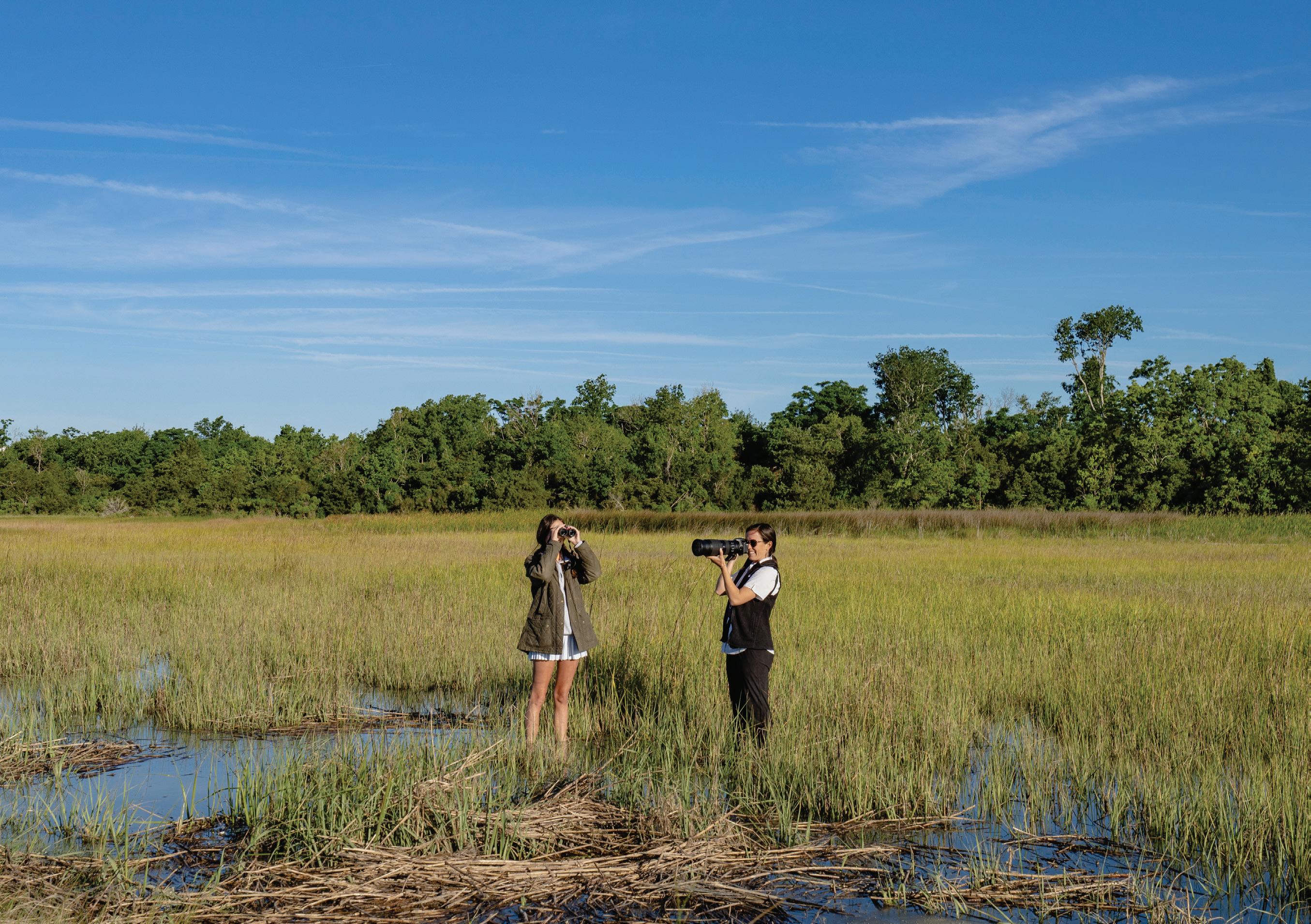—INSIDE—
PERSPECTIVES


—INSIDE—
PERSPECTIVES

BOARD OF TRUSTEES
2022–2023
OFFICERS
Anne Frances Bleecker ’76 | Chair
Eric P. Strickland | Vice Chair
Laurie A. Host ’73| Secretary
Philip Horn | Treasurer
Emmie Aichele Dawson ’70
Sara E. DeWolf
Elizabeth B. Fort
Kendra Y. Hamilton, Ph.D. ’76
Lenna S. Kirchner
Jim McNab
Rhett Ramsay Outten ’82
Kurt Palmer
Karen Jenkins Phillips ’79
Rowan G. P. Taylor
M. Ann Riopel, M.D. ’83
Mary Agnes Burnham Hood
Martha Rivers Ingram ’53
Patricia T. Kirkland
Hugh C. Lane, Jr.
Elizabeth Rivers Lewine ’54
Heidi Ward Ravenel ’74
Jerry Reves, M.D.
Conrad Zimmerman, Jr.
HEAD OF SCHOOL
Anne T. Weston, Ph.D. ’73
Paula Harrell | Director of Strategic
Marketing & Communications
Liz Regalia | Writer & Editor
Kate Daughtry | Graphic Designer
Brian Principe | Social Media Manager & Photographer
Betsy Sidebottom | Data Manager
Please forward any address changes to Ashley Hall Institutional Advancement Office, 172 Rutledge Avenue, Charleston, South Carolina 29403
Last September, Ashley Hall freshmen spent the morning perched on the edge of a boat in the middle of the Charleston Harbor with binoculars pressed to their faces. They were on a mission to identify as many shorebirds as they could out of the thousands that reside on the island of Crab Bank, a local seabird sanctuary.
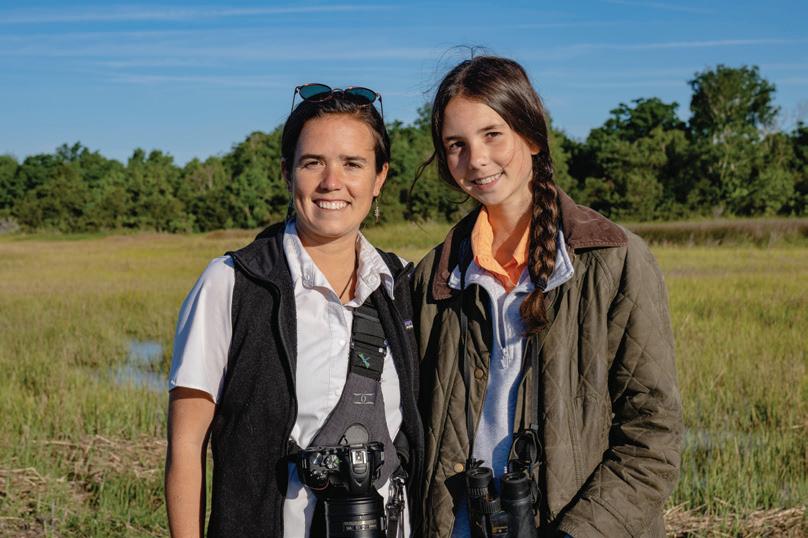
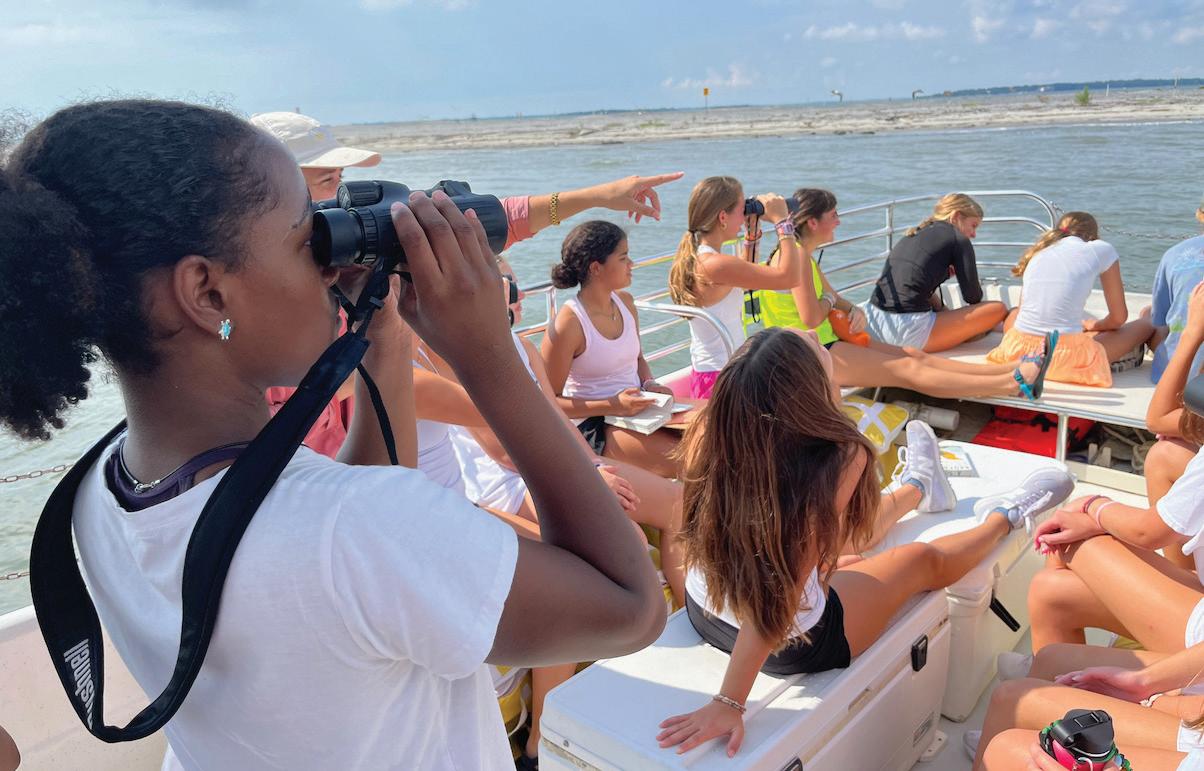
The educational field trip, led by Director of Education at Coastal Expeditions and alumna Katie Morrison ’13, was a part of a project entitled Migrating Together, a collaborative study aimed to further students’ understanding of migratory bird conservation through lessons in science and art. “I was lucky enough to be a part of the renourishment project of Crab Bank,” Morrison says. “We raised a certain amount of money for it to be here, and this project led me to regularly educating students of why these sanctuaries are important to shorebirds.”
This year, one of her students was her very own sister, Annie Morrison ’26, who took part in the project as a ninth grader at Ashley Hall and can be seen on the cover of this issue of Perspectives with Crab Bank in the distance.
“The sanctuary is such a great educational tool for kids because it teaches them that they can play a part in creating a habitat for animals, and not just the opposite of what’s happening around Charleston which is a lot of development,” Katie Morrison says. “They can see they can affect the future of these species, and it’s happening right in the middle of the harbor.”
Read more about Ashley Hall’s involvement in Morrison’s Migrating Together on page 44
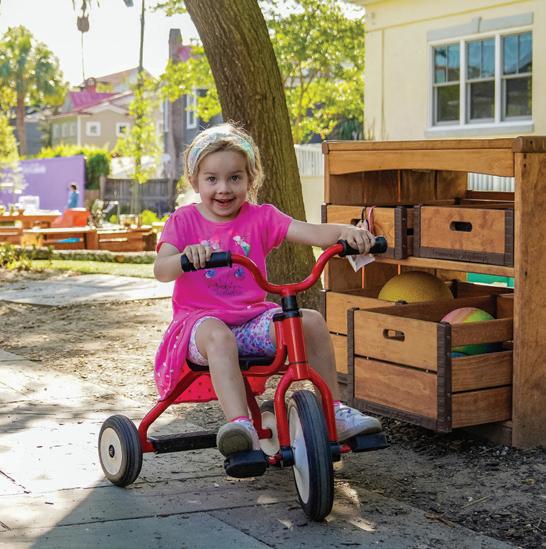
This year, the Ashley Hall yearbook staff took on an extra project after hitting their deadline to further develop their journalistic skills. The 4-week assignment focused on interviewing members of the student body and writing short articles for a new Student Voices section of this issue of Perspectives . Check it out on page 62!

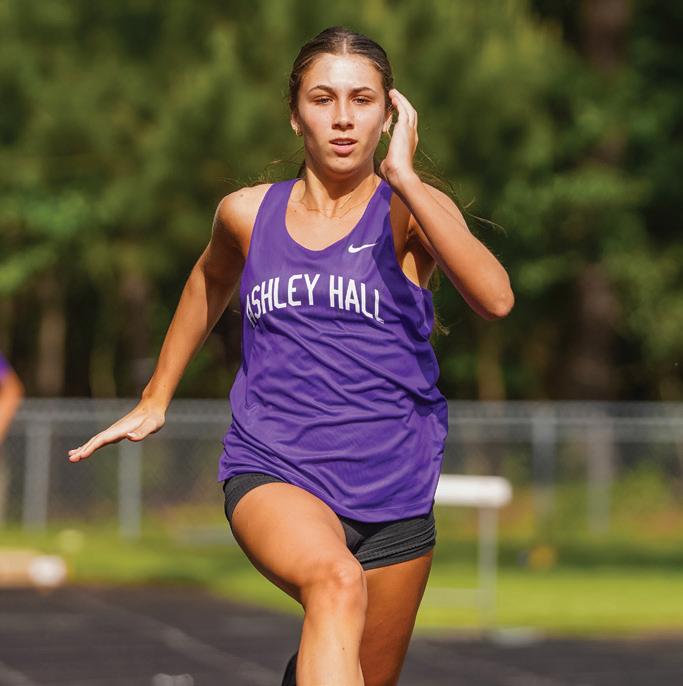
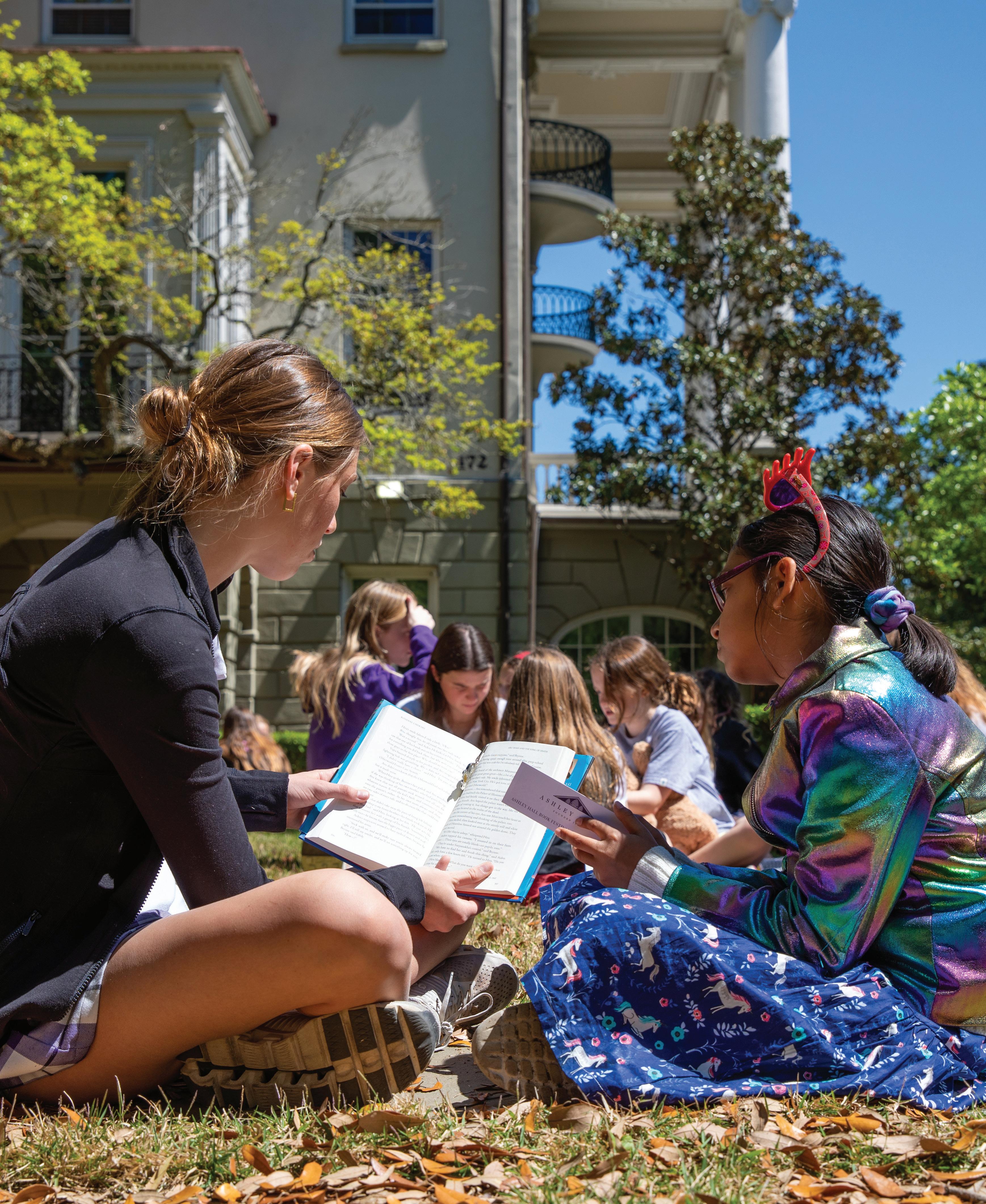
This School is for us all. Our campus is a place to step into, a foundation on which to stand, and sacred ground from which to leap into the future.
— ANNE T. WESTON, PH.D. ’73
At the core of all we seek to accomplish at Ashley Hall is our mission, one that was crafted in 1909 by the School’s founder Mary Vardrine McBee: to produce educated women who are independent, ethically responsible, and prepared to meet the challenges of society with confidence. For over a century, generations of alumnae have been a manifestation of that bold mission – including myself.
Since 1909, the world has changed. Our mission has not. A record number of students call Ashley Hall home because we continue to lead boldly, and this year has been no exception. In our thriving Early School program, which has nearly doubled in size in the past four years, we have transformed our outdoor spaces to be an extension of our indoor classrooms to enable daily nature-rich learning explorations. You can read about this in Learning Without Limits. Lower School scientists have moved into a new space as well: a state-of-the-art STEAM Lab designed to accommodate collaborative science lessons and experiments. We have expanded our focus on student life, and most notably have dedicated more personnel resources to addressing the health and wellness needs of all of our students. I’m excited for you to learn more about our programming in Supported Every Step of the Way
Off campus this year, Upper School students visited the United Nations Headquarters in New York City as a part of a new signature travel program; this is featured in United for Change. Closer to home, ninth grade students explored Crab Bank, a local seabird sanctuary, to study the impact wildlife habitat preservation has on the future of migratory shorebirds. This collaborative educational field trip was led by none other than a remarkable Ashley Hall alumna about whom you can learn more in Art Meets Science.
Now more than ever, it is imperative that we realize Ashley Hall’s mission in the context of the world in which we live. Our graduates will require knowledge in the future that we can only imagine today. To prepare them, we must teach students not what to think, but how to think, and we must support them in developing discerning minds and compassionate hearts.
We will continue, with deep purpose, the sacred work of education at Ashley Hall – with our eyes set firmly on the future.
Anne T. Weston, Ph.D. ’73 Head of School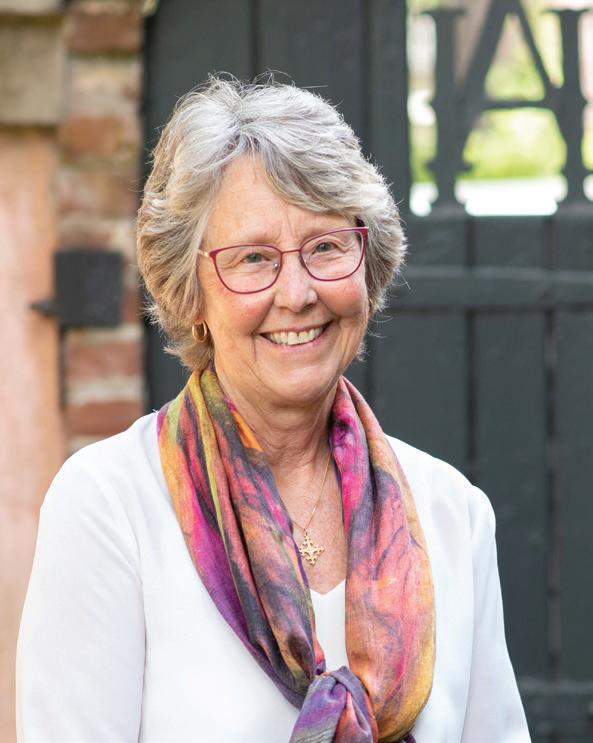
This year, sixth graders were given the opportunity to put their STEAM skills to the test during a new semesterlong tech course centered on woodworking. Co-taught by Intermediate Program STEAM teacher Kiki Sweigart and Special Projects Manager for Operations Ben Buckley-Green, the 40-minute weekly class tasked students with building a three-legged wooden stool.

“The goal is that every student leaves with an appreciation for the work, patience, and joy through a project that introduces all-new skills using new tools,” Sweigart says. “With so much time spent on the computer watching how-to videos, this project was meant to allow students to build a stool from a simple set of instructions and the most natural resources.”
“At the root of carpentry is geometry and math,” BuckleyGreen says. He created design instructions for students to follow throughout the course with a focus on continuity. Work that was not completed one week was continued the next, and modifications were made to keep the class engaged in the hands-on work as well as its academic relevance.
“The original concept of this workshop was to grow a program in the Intermediate Program that could become the genesis of a larger woodworking program for grades K-12,” Buckley-Green says. “Our choices of tools and projects can be adapted, whether it be for Lower School students who are learning new skills or Upper School students who are developing more advanced skills.”
Sixth graders were not the first students to build stools on campus, despite this course being a new Ashley Hall offering. Buckley-Green and Sweigart, who is also the Program Director for Horizons at Ashley Hall, led a similar class last summer for students attending Horizons, an all-girls academic enrichment program.


“I was looking for a unique hands-on project that the Horizons rising sixth grade class might try after seeing how well the Ashley Hall fifth graders enjoyed boat building,” Sweigart says. “I thought, ‘How can we move these skills further to more students?’”
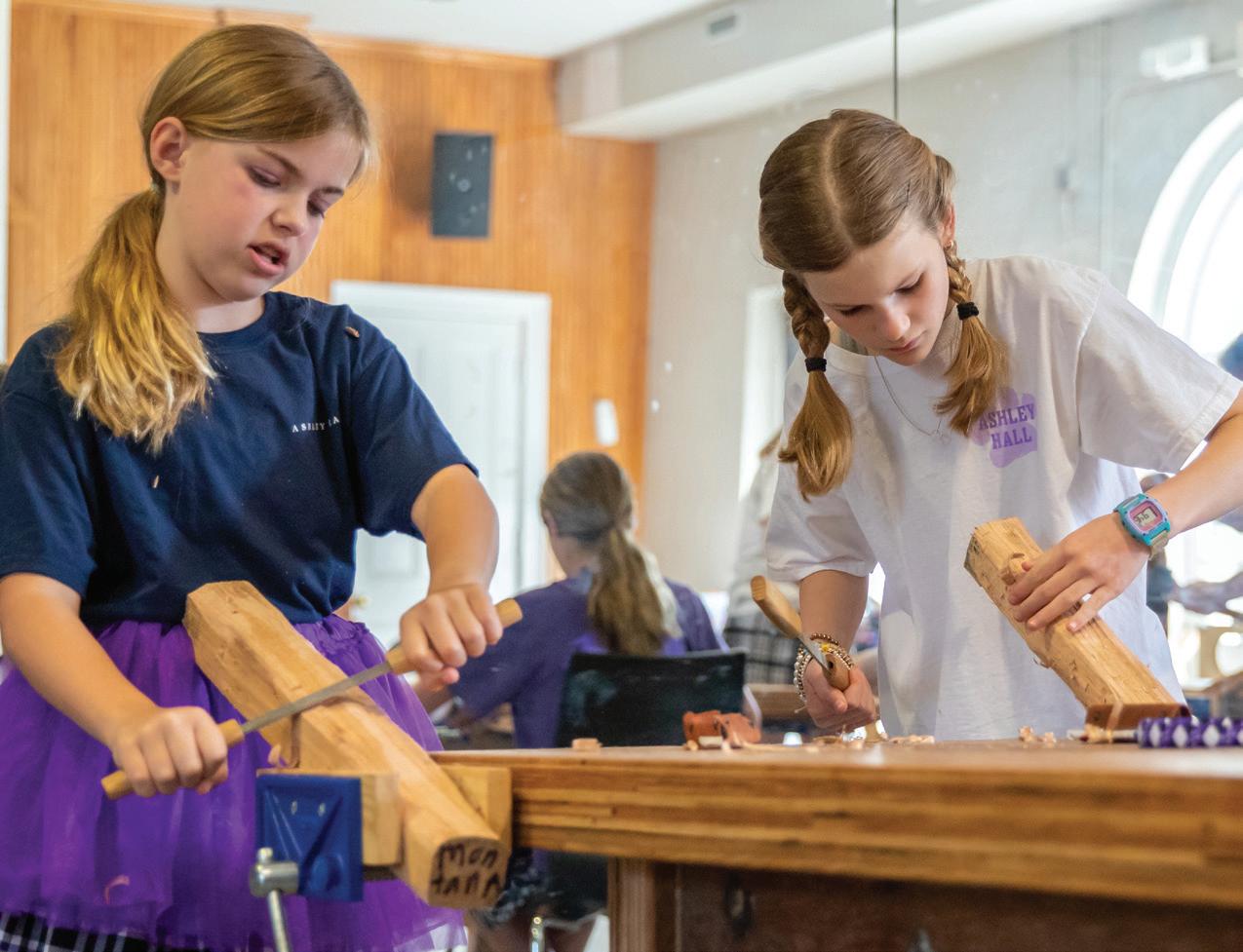
Together, they created a 6-week course for Horizons students to process raw dimensional lumber into a stool using hand tools. “We quickly both learned how much they looked forward to each woodworking session, along with the progress they made,” Sweigart says. “With that idea and knowledge, we launched the proposal do the same course with this year’s Ashley Hall sixth grade class.”
Horizons at Ashley Hall is an award-winning academic and enrichment program serving female students from under-resourced communities in Charleston. Learn more at horizonsatashleyhall.org

Through woodworking, students discover that they need to put time and physical effort into each and every class session for the result that they desire.
– KIKI SWEIGART, INTERMEDIATE PROGRAM STEAM TEACHER
As soon as children can walk, they should start swim lessons, according to experts at Step into Swim, a water safety initiative that provides grants for learn-to-swim programs in communities across the country. Why? Because if a child can walk, that means they can also run toward water, and knowing how to swim could save their life. That’s why every Early School class visits Madren Pool at least once a week for a swim lesson led by Aquatics Director Missee Fox ’73 and swim teacher Cassidy Rindge. Here are just a few of the fun phrases Fox and Rindge use to teach the youngest students at Ashley Hall how to swim:
When an instructor says this phrase, swimmers dunk some part of their head under the water and “make it disappear.” It could be their whole head, an ear, or their lips – all of which help them get more comfortable being underwater.
This hand placement prepares swimmers for a glide position when kicking their feet under or above water. “What kind of sandwich will you make today?”
“What kind of ice cream would you like to have today?” an instructor may ask to have swimmers practice curving their hands into scoop-like shapes. This position helps them pull themselves through the water in a freestyle fashion.
“Hands up to the sky, and squeeze your head with your arms!” This instruction prepares swimmers for diving by putting their arms in a streamline position.

“The 21st century requires deep problem solving and creative thinking skill sets. Ashley Hall students who take sculpture and 3D-art are learning to imagine, make predictions, calculate, respond to results, persevere, experiment, analyze, and reflect. The artistic process requires each student to develop technique, discipline, creativity, empathy, and accountability. In the study, students not only seek solutions but also pose their own questions.”
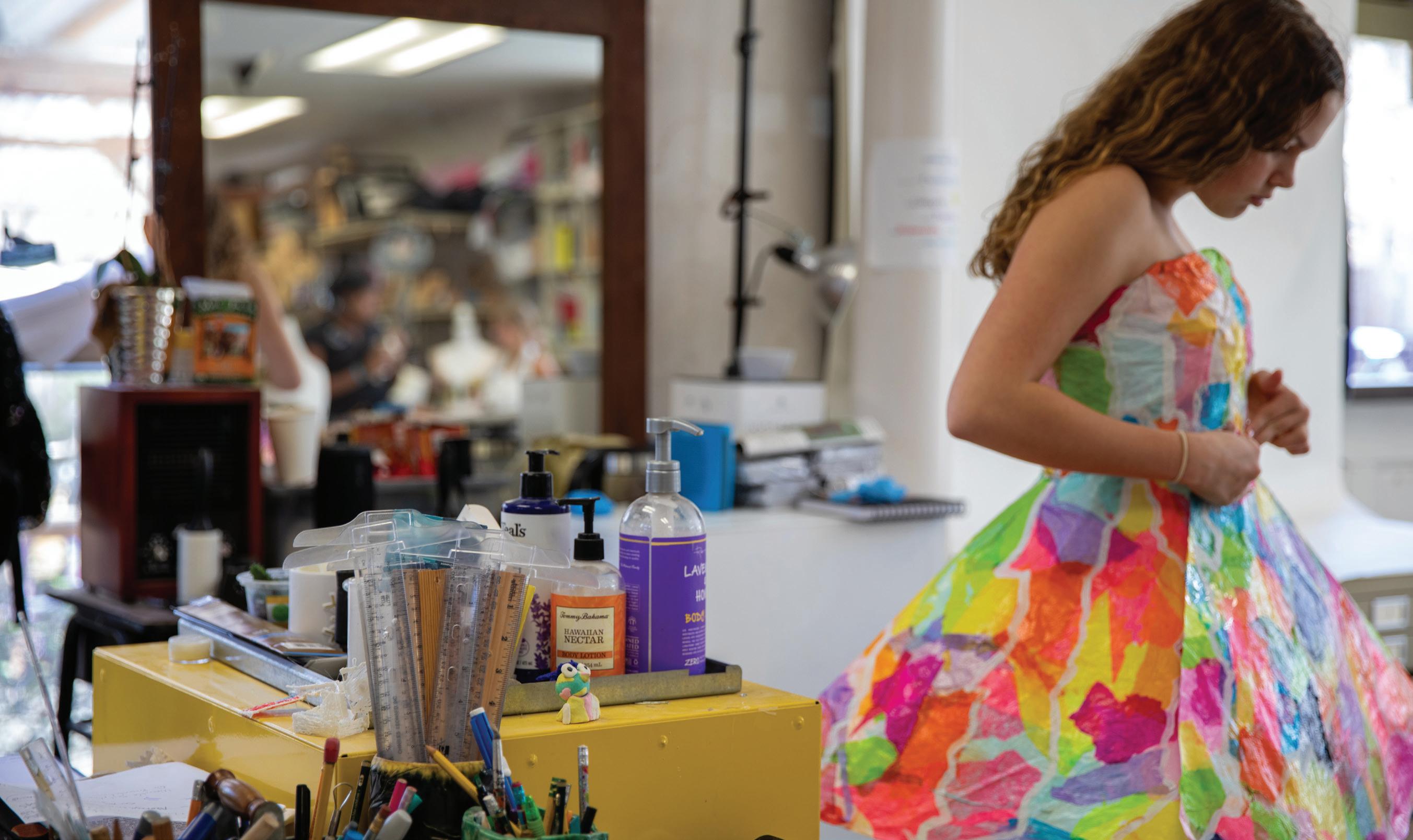
 – NANCY LANGSTON,
DEPARTMENT
VISUAL ARTS
CHAIR
| Top: Each year, Nautilus 3D-artists team up as models and designers to construct a piece of wearable art, like this papier-mâché dress worn by Maya Opoulos ’27. Their final exhibit comes in the form of a fashion show for their Upper School peers and teachers.
Photo by Liz Regalia | Bottom: Two underwater explorers sculpted by Pierce Wilson ’23 which were presented during this year’s 2D and 3D Art Exhibit in Davies Auditorium in May showcasing the work of AP art students.
– NANCY LANGSTON,
DEPARTMENT
VISUAL ARTS
CHAIR
| Top: Each year, Nautilus 3D-artists team up as models and designers to construct a piece of wearable art, like this papier-mâché dress worn by Maya Opoulos ’27. Their final exhibit comes in the form of a fashion show for their Upper School peers and teachers.
Photo by Liz Regalia | Bottom: Two underwater explorers sculpted by Pierce Wilson ’23 which were presented during this year’s 2D and 3D Art Exhibit in Davies Auditorium in May showcasing the work of AP art students.
In March, Ashley Hall announced that Elisabeth Lavin-Peter will step into the role of Upper School Director beginning in July. Here are four facts to know about her:
Elisabeth comes to Ashley Hall after 16 years of living and working in Singapore at the Overseas Family School (OFS), an International Baccalaureate School.
A graduate of Connecticut College with a master’s degree in Literature from Tufts University, Elisabeth loved her experience as an English teacher before becoming an administrator.
Elisabeth was a founding team member of Global University Counsellor Connect, an annual conference created for international university counselors across Southeast Asia.
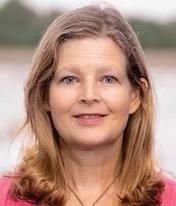
As a family, Elisabeth, her husband Hugh, and their daughter Aurora have spent many summers on Sullivan’s Island, so they know the Charleston area well and are thrilled to return!
At the end of the 2022-23 school year, Ashley Hall said farewell to Lower School faculty member Lee Tamblyn and Intermediate Program faculty member Melanie Gibson, two educators who, combined, dedicated over four decades to its students.
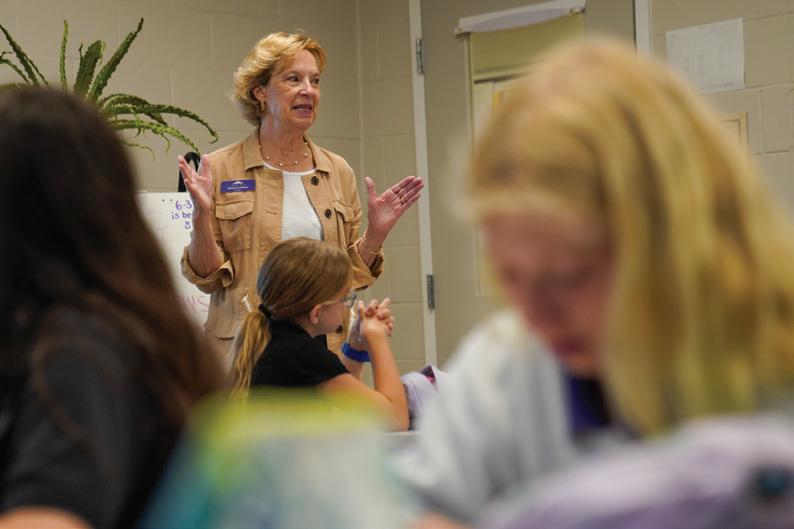
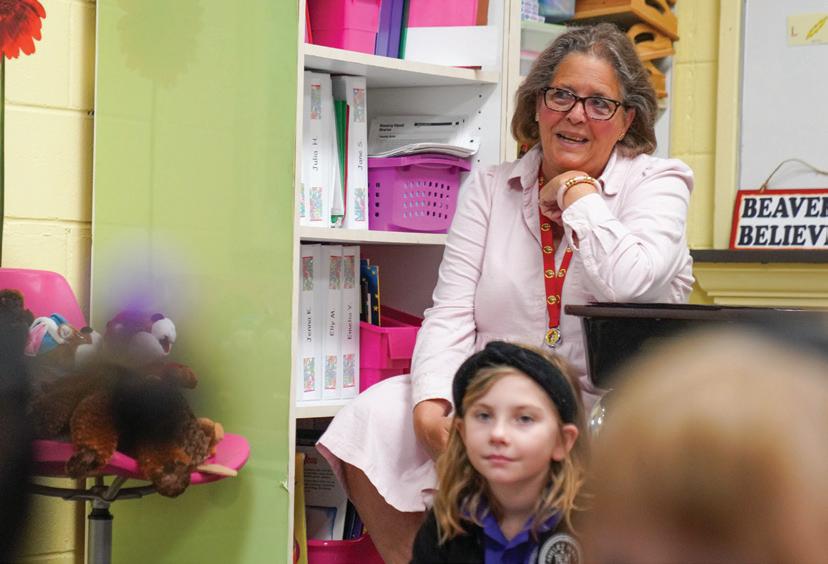
Tamblyn has been a teacher in Charleston for 39 years. In 2000, she joined the Ashley Hall community where she has taught first and second grades. When not in Pardue Hall, Tamblyn could be found on the sidelines of Panther Athletics games as a statistician for volleyball as well as basketball, and her daughter, alumna Katy Burton, graduated with the Class of 2009. “The most treasured memories over the past 23 years are being part of my students’ families – and not for just one year,” Tamblyn says. “It’s a very special privilege to teach siblings and then to watch all of these children grow up around us and graduate as strong, confident young women.”
Gibson began her teaching career working with first grade students. Thirty-four years later, she is retiring with sixth grade students at Ashley Hall where she has worked since 2002. During her tenure, she has taught social studies, reading and language arts, and the humanities, a program she is proud to have developed for sixth grade students. When recounting the top things she feels lucky to have had during her career as a teacher, Gibson puts her passion and love for teaching, caring teachers and administrators, a supportive and loving family, students who love learning, and Ashley Hall at the top of the list.
For nearly a decade, Ashley Hall has housed educational beehives through The Bee Cause, a non-profit that helps organizations install and maintain their own observation hives. In 2020, the pandemic threatened to shut down the School’s bee program. But now it is thriving again, thanks to Lower School faculty beekeepers Elizabeth Flowers and Meghan Ward.
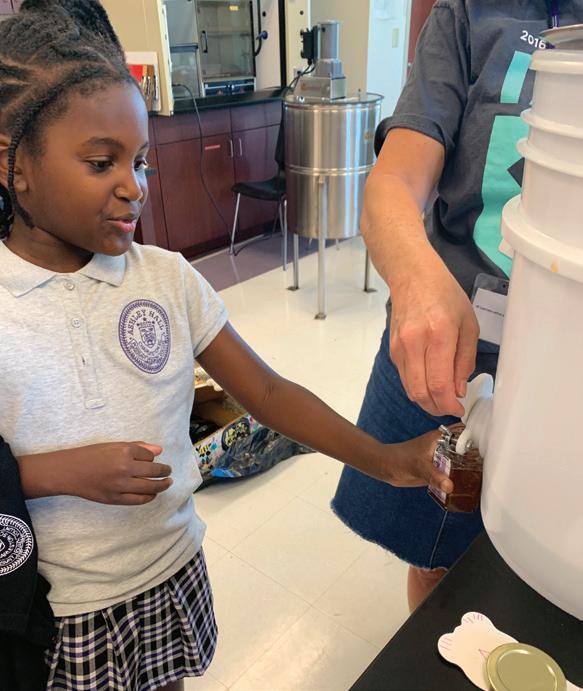
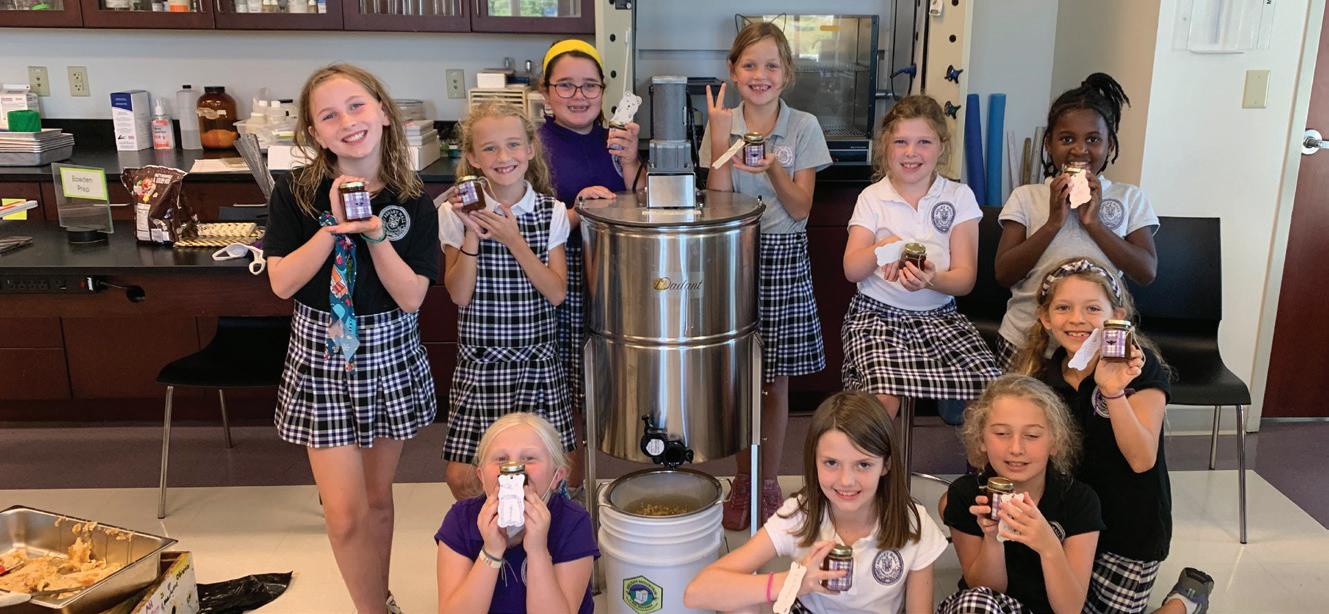
“Bees are critical pollinators and are in trouble,” Ward says. “Their populations are down, and we hope through education we can help our students become stewards for the bees.” Currently, there are three working Langstroth beehives on the roof of Jenkins Hall. Here, students in all divisions suit up to watch Ward and Flowers open these stacking rectangular boxes to reveal removable frames where the bees build honeycombs.
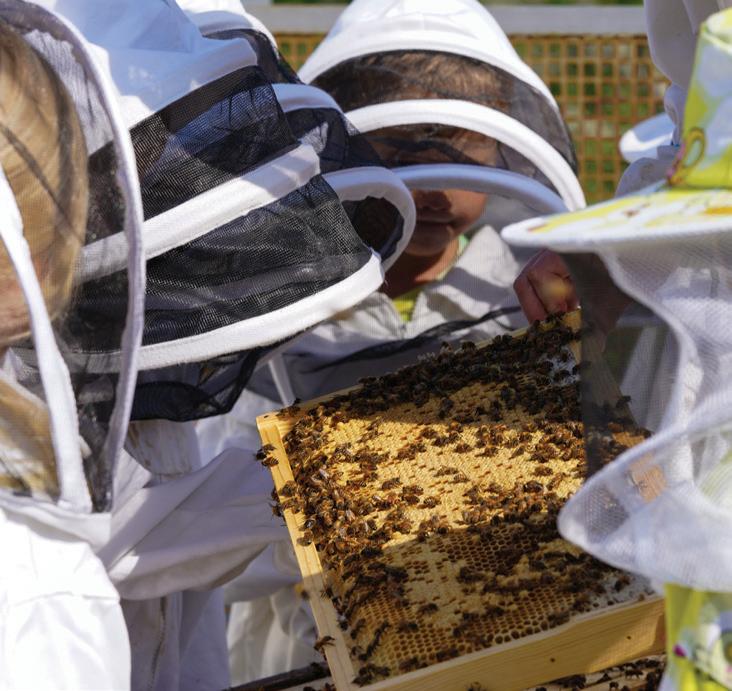
Ashley Hall also has two observation hives, the first located in the Lower School STEAM Lab and a second in the Ross Early Education Center, which was installed in April. “Observation hives are challenging to maintain and keep healthy, but they are a valuable way for students to watch the complex workings of a honeybee hive up close day to day,” Flowers says. “Children become absorbed in the wonder, and it opens the door for us to teach them about stewardship of our planet.”
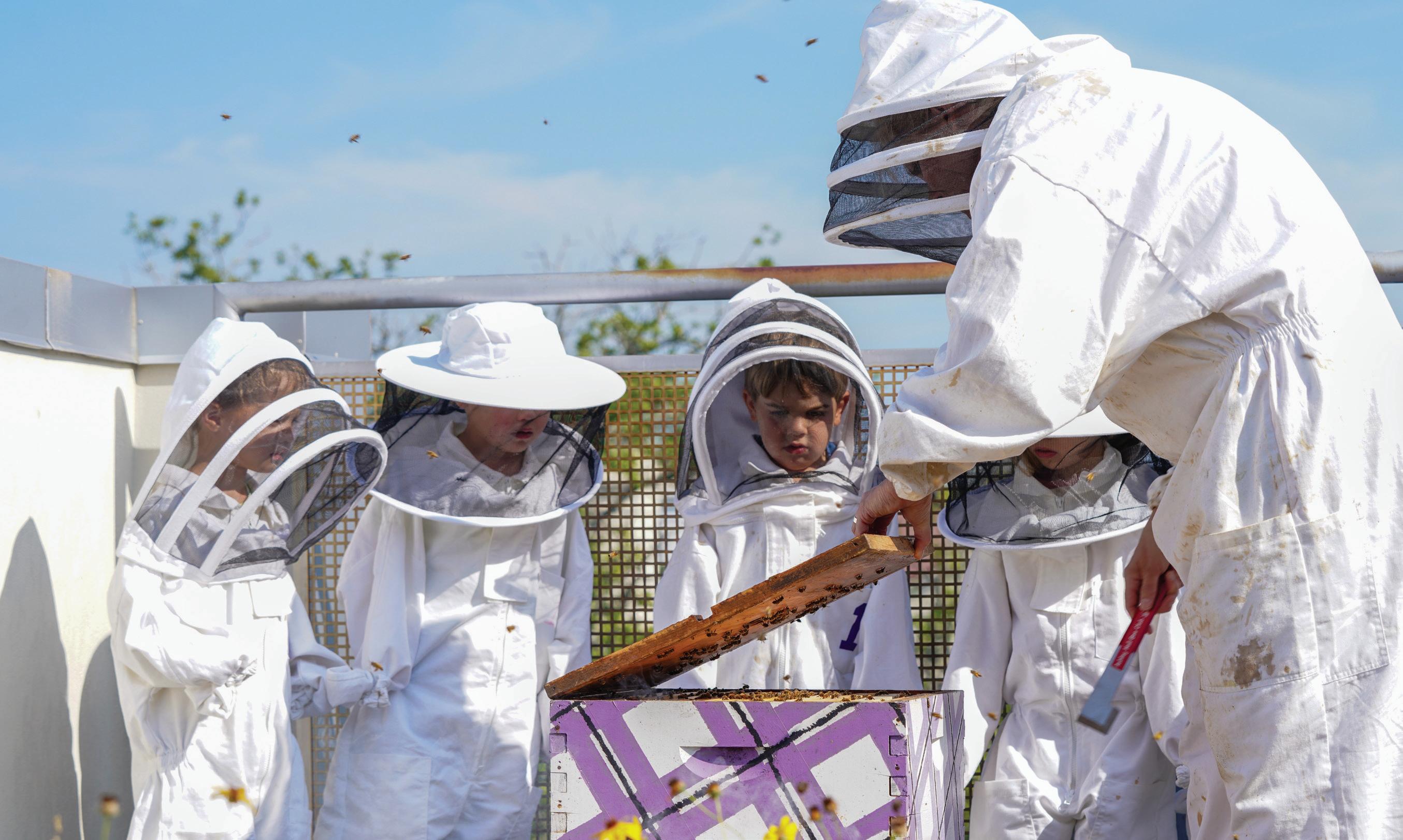
Anyone who thinks they are too little to make a difference has never met a honey bee…| Top: Lower School faculty beekeeper Elizabeth Flowers opening a Langstroth beehive on the roof of Jenkins for Early School students. Photo by Brian Principe | Left: Early School students studying how bees build honeycomb. Photo by Brian Principe | Right: Vanedjina Snyder ’32 using a honey extractor to separate honey from honeycomb.
Last fall, Ashley Hall launched CUBS, the School’s first ever youth sports program. Led by Assistant Athletic Director Christian Alcantara, the program is an expansion of Ashley Hall Athletics and designed to teach fundamental skills and PQV spirit to students in grades pre-kindergarten through fourth. “It’s so important for kids to explore athletics at a young age,” Alcantara says. “It’s also been amazing to see the social dynamics that are naturally created by giving kids another opportunity to connect outside the traditional school day. At CUBS, they are surrounded by kids in their grade that may not be in their class, so it’s a great opportunity to grow socially.”
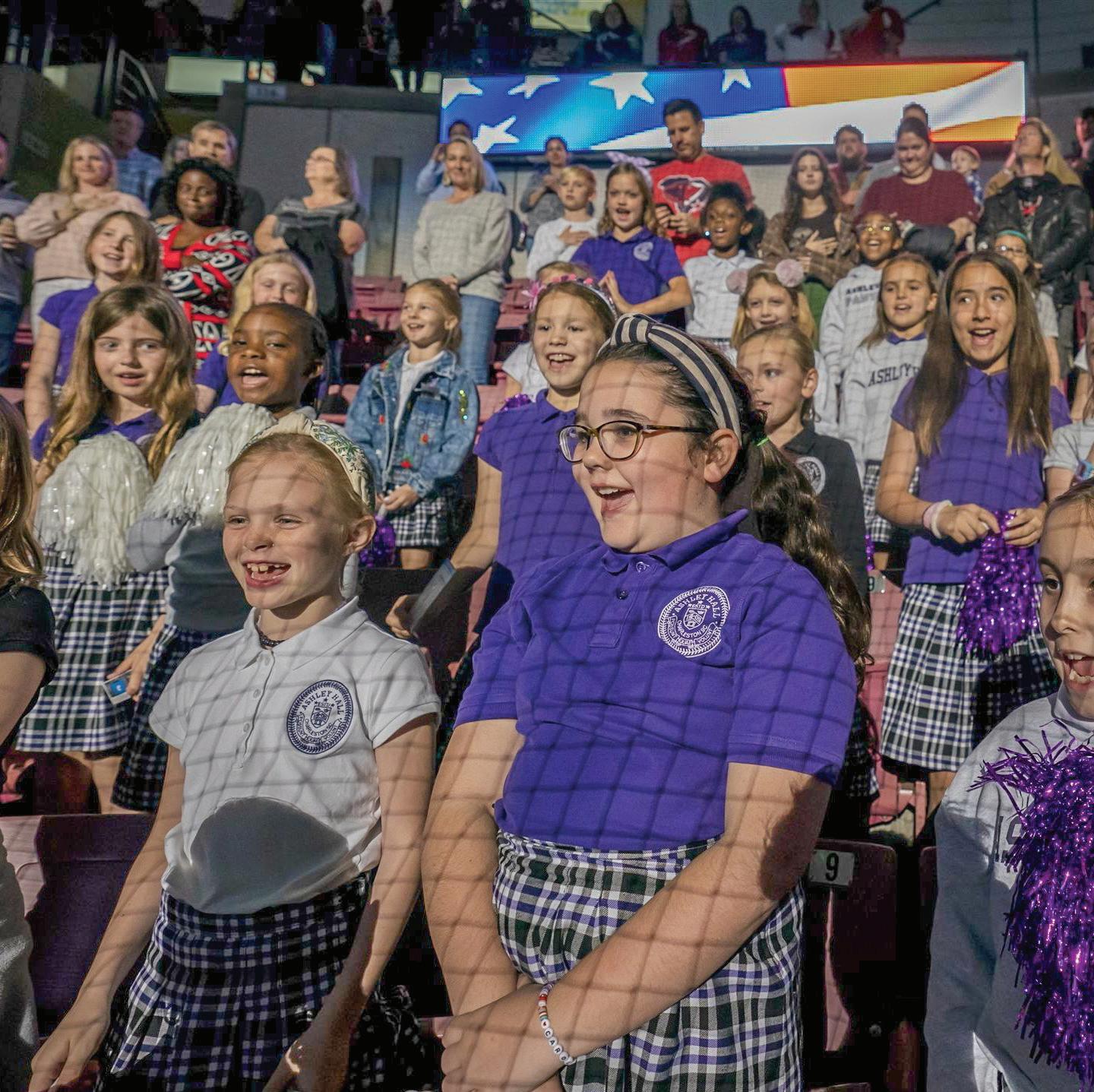
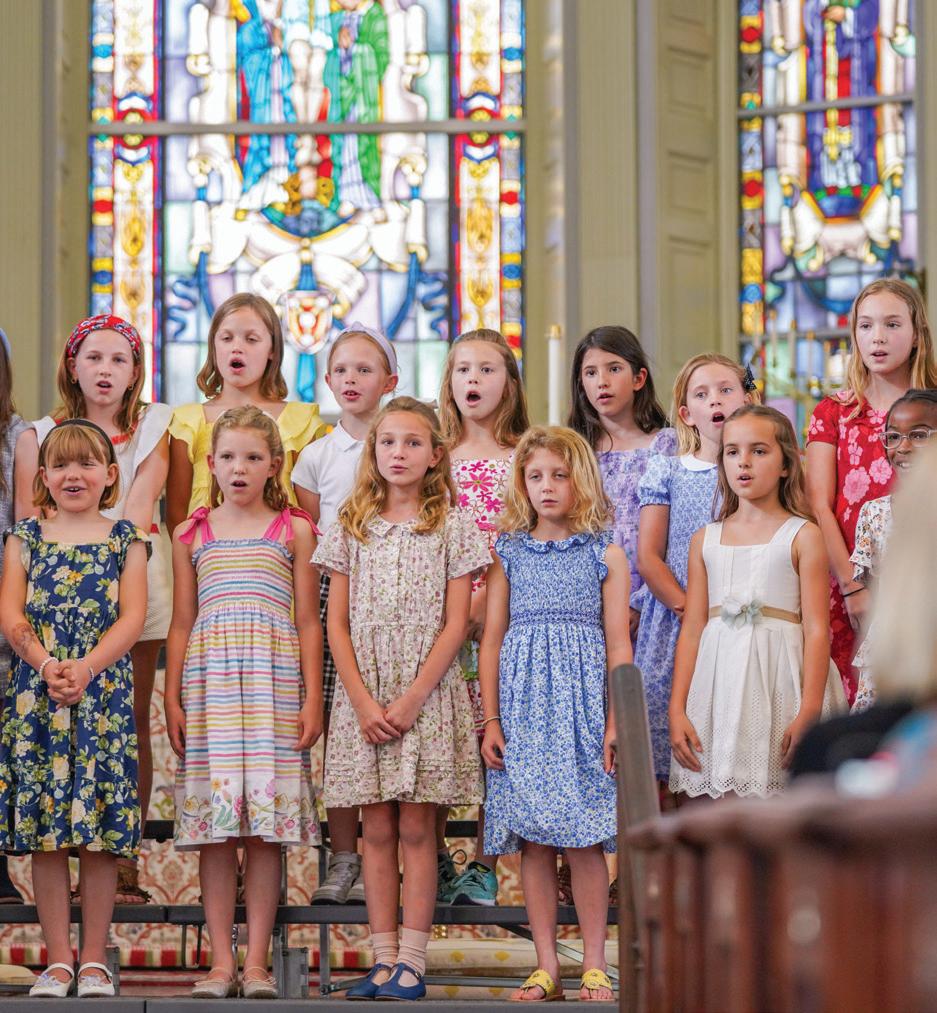
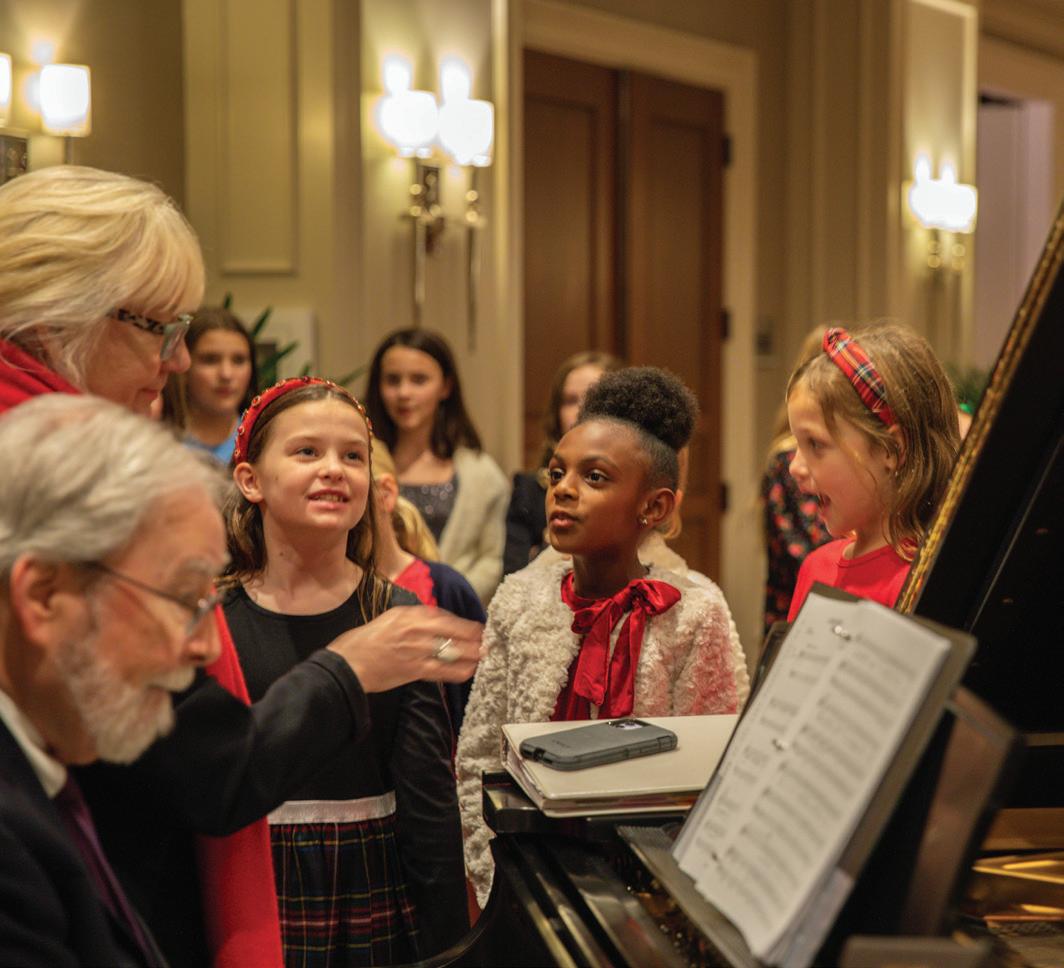
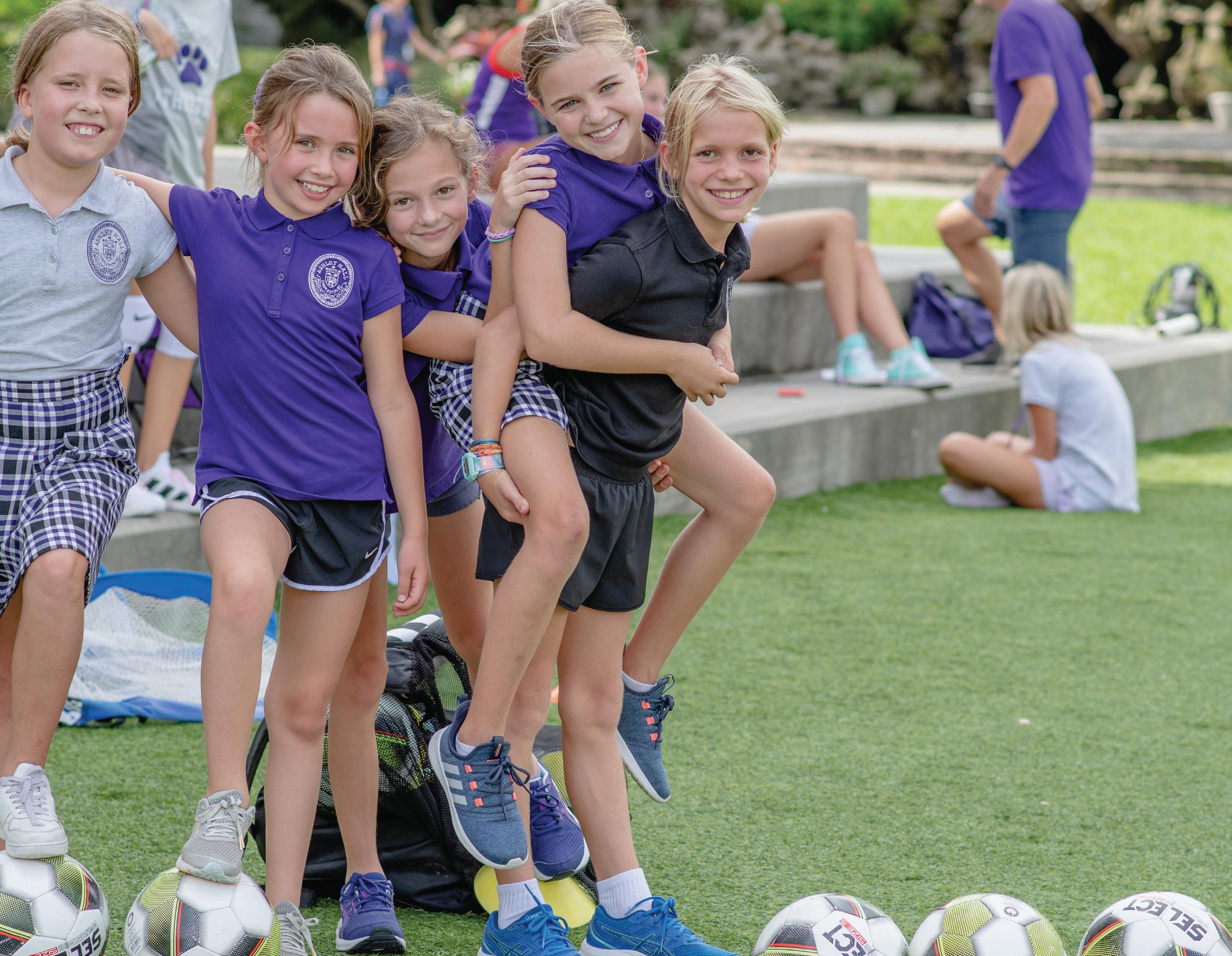

Research shows that the best way to improve students’ vocabulary and grammatical skills is by reading. There is also evidence that reading for pleasure increases general knowledge, cultural awareness, and insight into human nature and decision making.
Knowing the long list of benefits that comes from reading, Upper School English teacher Leslie Rowland-Yeh began an independent reading program at Ashley Hall in 2020. She, along with English teacher Nana Westbrook, carved out 10 minutes every class period to give their seventh and eighth grade English students time to read a book with only one rule: the title wasn’t assigned, but selected by students.
“Teachers developed book lists each quarter that students could choose from,” Rowland-Yeh says. “Those lists included titles that were thematically related to what we were doing in class, but also represented a span of difficulty, style, genre, and characters. There was always a classic, a graphic novel, and a nonfiction title on the list.”
From stronger writing samples to more books being checked out of the library, Rowland-Yeh has seen nothing but positive effects since the start of the program. So this year, the entire Upper School English department adopted the initiative to expand independent reading into ninth through eleventh grade English classes. Upper School Literacy Coordinator Chris Hughes also introduced “free reading” during her senior seminar class for twelfth grade students.
“The girls have such joy and enthusiasm for singing that it’s a gift to the community to share it,” says Loretta Haskell, Director of Caroline’s Carolers, Ashley Hall’s choir for students in grades 2-4. “It’s also affirming to the girls to know that they have something special to offer at public events with their singing.” This year, for the first time in the choir’s history, Caroline’s Carolers received invitations from Hotel Bennett to sing for its patrons during the busy holiday season and the Charleston RiverDogs to perform the national anthem. “The girls love getting out and being ambassadors for Ashley Hall, as well as making memories together at these special events,” Haskell says. “We will continue to entertain any invitations to sing that come our way!”
DID YOU KNOW? Ashley Hall’s choir for Lower School students is named for former Headmistress and music lover, Caroline Pardue.

“My juniors were allowed to choose any book by an American author because American literature is the focus of eleventh grade,” Rowland-Yeh says. “Students also swapped and shared books, and they asked me for recommendations. Independent reading time also serves as a brain break and stress reliever – a bit of quiet time in a hectic school day. I always read at the same time and share what I’m reading as well.”
The minimum number of books Upper School English students read this year for pleasure. Here are a few titles they finished:
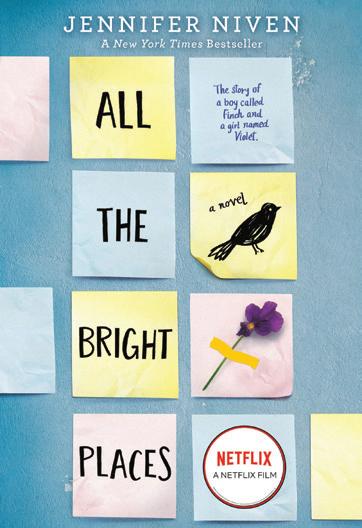
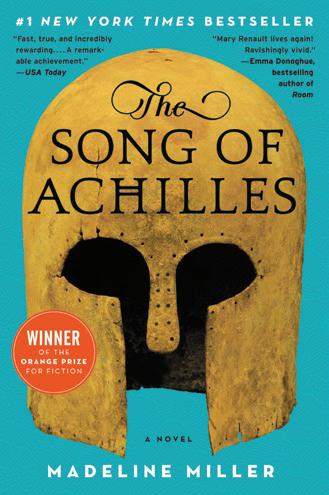
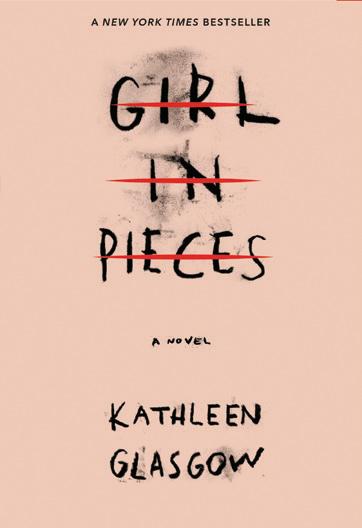
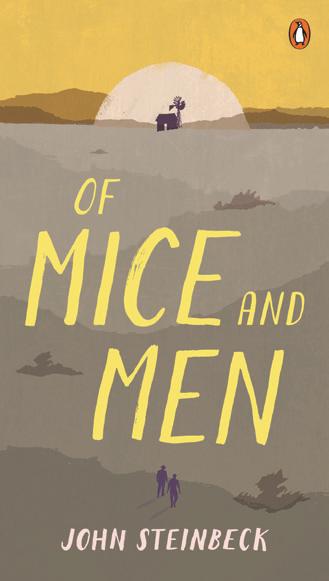

Achieving your full potential begins with a better understanding of your needs. That was the topic of conversation during a school-wide event in February which brought Ashley Hall together for a special exercise. Prior to the event, Upper School students discussed the importance of self-care through the lens of gender equality in small groups. Then they paired up with Lower School students to share how liking, loving, and knowing yourself can set them up for success. With the help of their big sisters, little sisters then wrote a postcard to their future selves with advice and reminders that would help them on their journey.
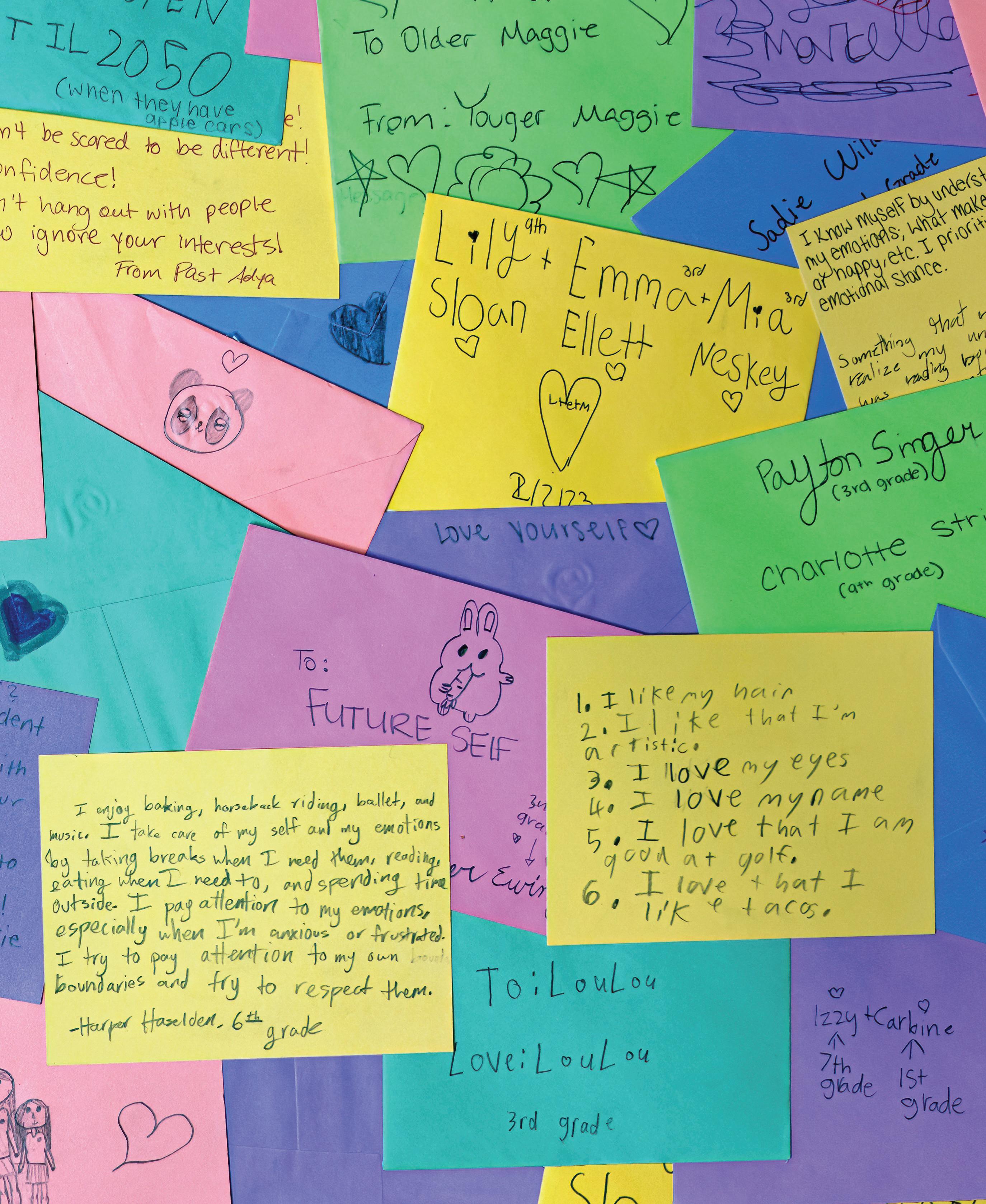
From worldly to intelligent, discerning to compassionate, there are many traits that every Ashley Hall student and alumna can proudly claim. But there are two in particular that just may evoke more pride than all the rest: Purple or White.
For over a century, Ashley Hall students have been split into two teams to inspire school pride, and of course, some friendly competition. Now, for the first time in history, educators have officially joined in the Purple and White team tradition which dates back to 1917.
“We felt that getting teachers and staff involved would help raise school spirit by giving everyone ownership as a Purple or White,” says Department Chair for Physical Education Jodie Runner who led the initiative. At the start of the school year, teachers drew a purple or white piece of paper at random to determine their fate. Then they kept their new team color a secret until the Upper School pep rally on October 13 when Head of School Anne T. Weston, Ph.D. ’73 announced that every Ashley Hall educator is now officially a Purple or White.
Students contribute to their team by earning points through academic and extracurricular activities and competitions. The team with the most points at the end of the year is awarded the coveted Team Cup. As Purples and Whites, Ashley Hall teachers and staff will participate in different challenges, as well as skill competitions during future pep rallies.
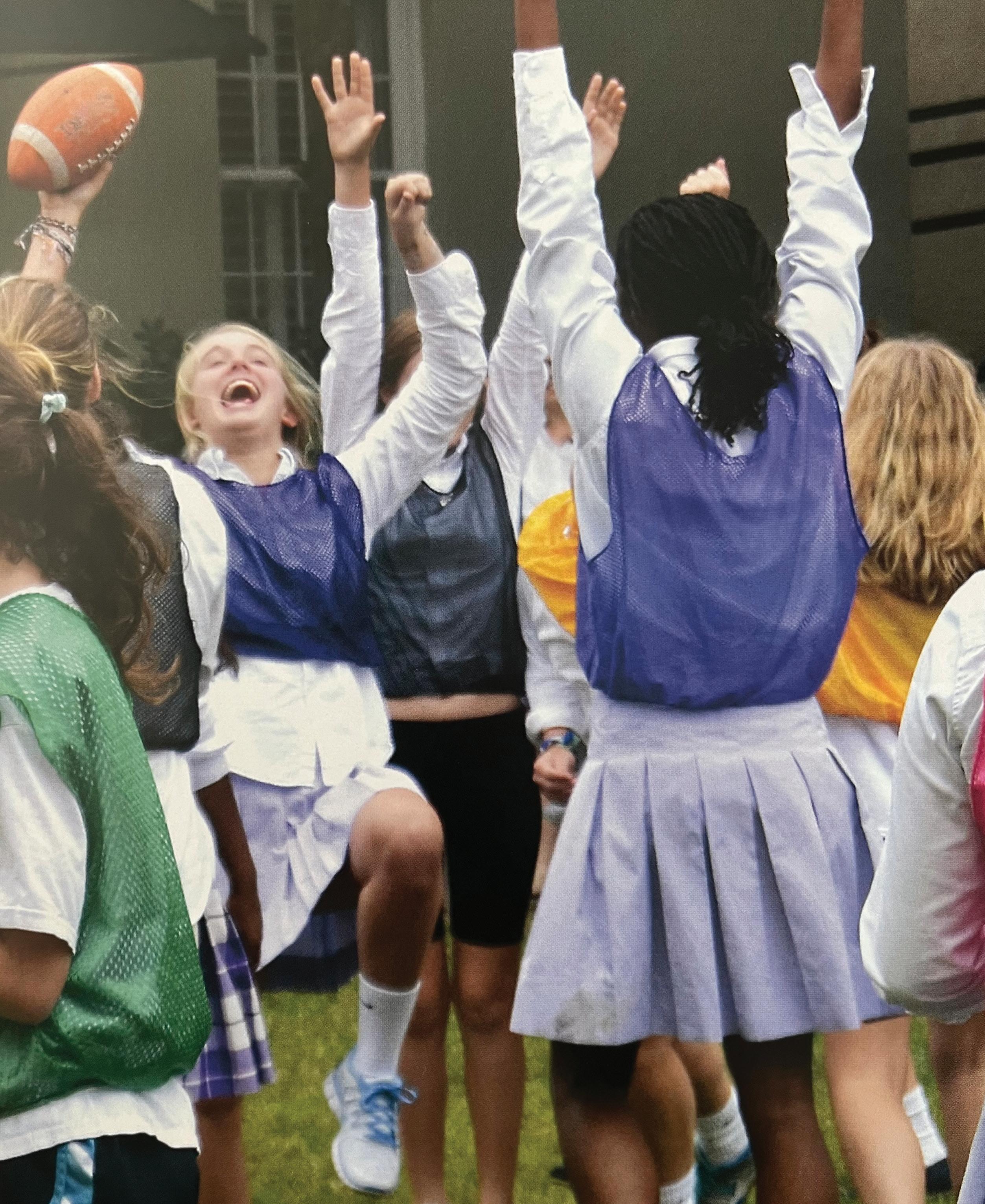
DID YOU KNOW? Former First Lady Barbara Pierce Bush, Class of 1943, was a proud Purple! Another alumna to follow in her footsteps? Head of School Anne T. Weston, Ph.D. ’73 was captain of the Purple team and was Co-First Honor Graduate of the Class of 1973!

STRENGTH TRAINING PROTECTS JOINTS FROM INJURIES, MAINTAINS MUSCLE TISSUE, AND IMPROVES OVERALL HEALTH. HERE’S HOW IT’S CHANGING THE LIVES OF ASHLEY HALL ATHLETES.

It’s 6:14 a.m. and the moon is still up.
Even though their sports season is still five months away, student-athletes planning to play for Ashley Hall in the fall are on campus. One by one, they make their way to the turf to join a huddle around strength and conditioning coach Beatrice Puiu. She’s pacing back and forth.
“Are you still sore from Monday?”
Puiu asks with her hands in the pockets of her jacket. You can see her breath in the cold. A resounding “yes” echos out of the darkness. “Good. Take a lap.”

FACT: Studies show that after a strength training session, endorphin levels are increased by more than 60 percent leaving athletes feeling rejuvenated and even euphoric.

In the fall of 2022, Panther Athletics launched a new year-round program to offer off-season and pre-season strength training for student-athletes in grades 9-12, as well as in-season training to complement regular practice schedules. Sessions take place before and after school, and are required to attend for athletes who participate in tennis, volleyball, cross country, golf, basketball, track and field, soccer, lacrosse, sailing, and swimming.

“The difference is remarkable,” says Athletic Director Franny Slay ’80 who has been coaching athletes at Ashley Hall for over three decades. “With the start of the program, athletes are 2-3 weeks ahead of where they normally are when they start the season now. They are not having to get in shape; they are ready.”
“Our strength and conditioning program covers the entire body,” Puiu says. “The main goal is for each athlete to get stronger, more powerful, and more explosive.” Workouts are designed to cover the needs of all athletes, plus sports-specific needs separately. But it’s important to note that strength training is not the same as weight lifting or bodybuilding.
According to Mayo Clinic, light resistance training and controlled movements are best for strengthening young muscles, tendons, and areas of cartilage that haven’t yet turned to bone (growth plates). An emphasis on proper technique and safety is also important. With this in mind, the majority of strength training exercises in Puiu’s program utilize athletes’ own body weight and free weights.
Sessions start with a 10-15 minute warmup which usually includes sprints, arm circles, squats, calf raises, lunges, and
stretches. Then athletes will grab a pair of 5-, 10-, or 15-pound weights to start a circuit, a combination of three or more exercises that will be completed back-to-back with very little rest in between.
“The circuits are very intense,” says Kylie Wojdyla ’26, a volleyball player who has now participated in the program during two pre-season sessions. “You’ll do each workout for a short time, but you don’t stop. You just keep going.” Circuits vary each workout, and Puiu keeps count by either reps or time performed. These are a few exercises that show up in a circuit:
• 75 burpees
• 150 lunges with free weights
• 100 kettlebell swings
• 60 seconds of of lunges with twists
• 60 seconds with sumo squats with calf raises
• 60 seconds of sumo squats
• 100 crunches
• 100 reverse crunches
• 90 sit-ups
Sound intense? It is. But it comes with its rewards. When asked if she had a favorite part of an early morning strength and conditioning session, Wojdyla didn’t hesitate. “That’s easy: The end,” she says with a laugh. “We normally end with an ab circuit, then a little stretch, and you’re done. It makes me feel so strong after. I love it.”

ACCORDING TO THE NATIONAL STRENGTH AND CONDITIONING ASSOCIATION (NSCA), CREATING A STRENGTH AND CONDITIONING PROGRAM LED BY A QUALIFIED PROFESSIONAL IN THE HIGH SCHOOL ENVIRONMENT CAN BENEFIT STUDENTS IN A NUMBER OF WAYS, INCLUDING:
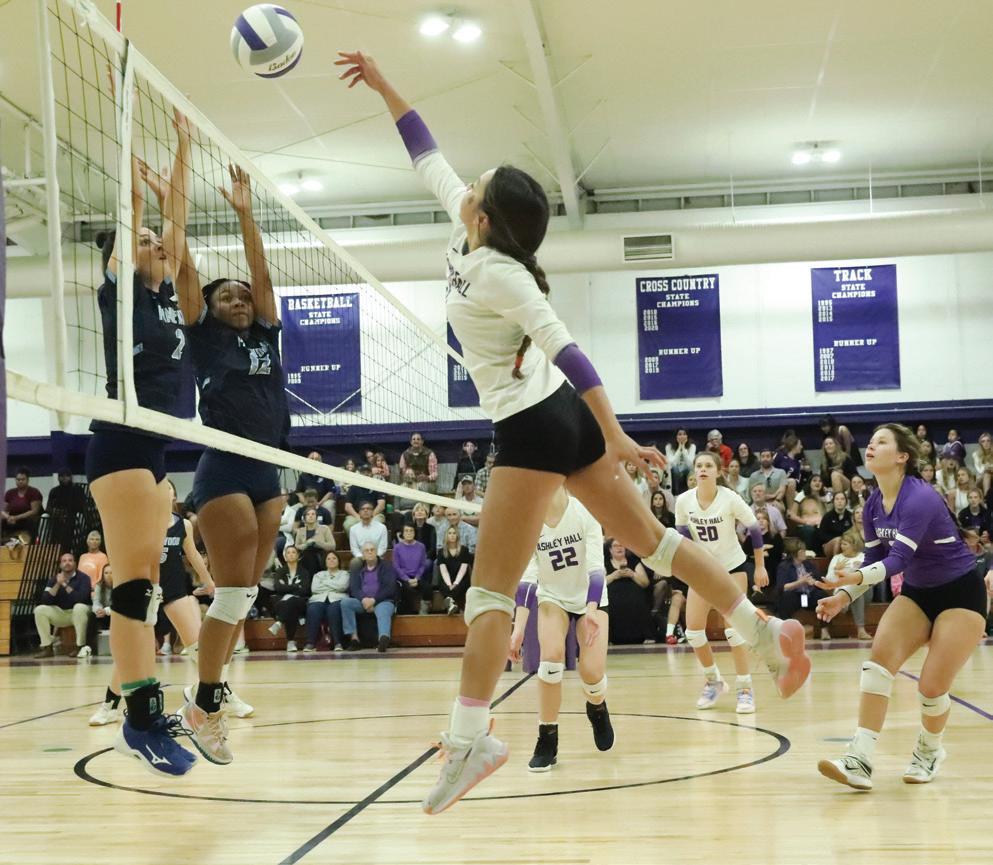
Reduce injuries: Stronger athletes are much more resilient to injuries. Period. Strength training is an effective way to decrease the likelihood of injuries by strengthening muscles, tendons, and even the ligaments and bones. It also improves coordination and balance.
Improve long-term athletic development: A qualified strength and conditioning professional understands the many variables that go into designing age-appropriate programs that will promote continued positive results in the future.
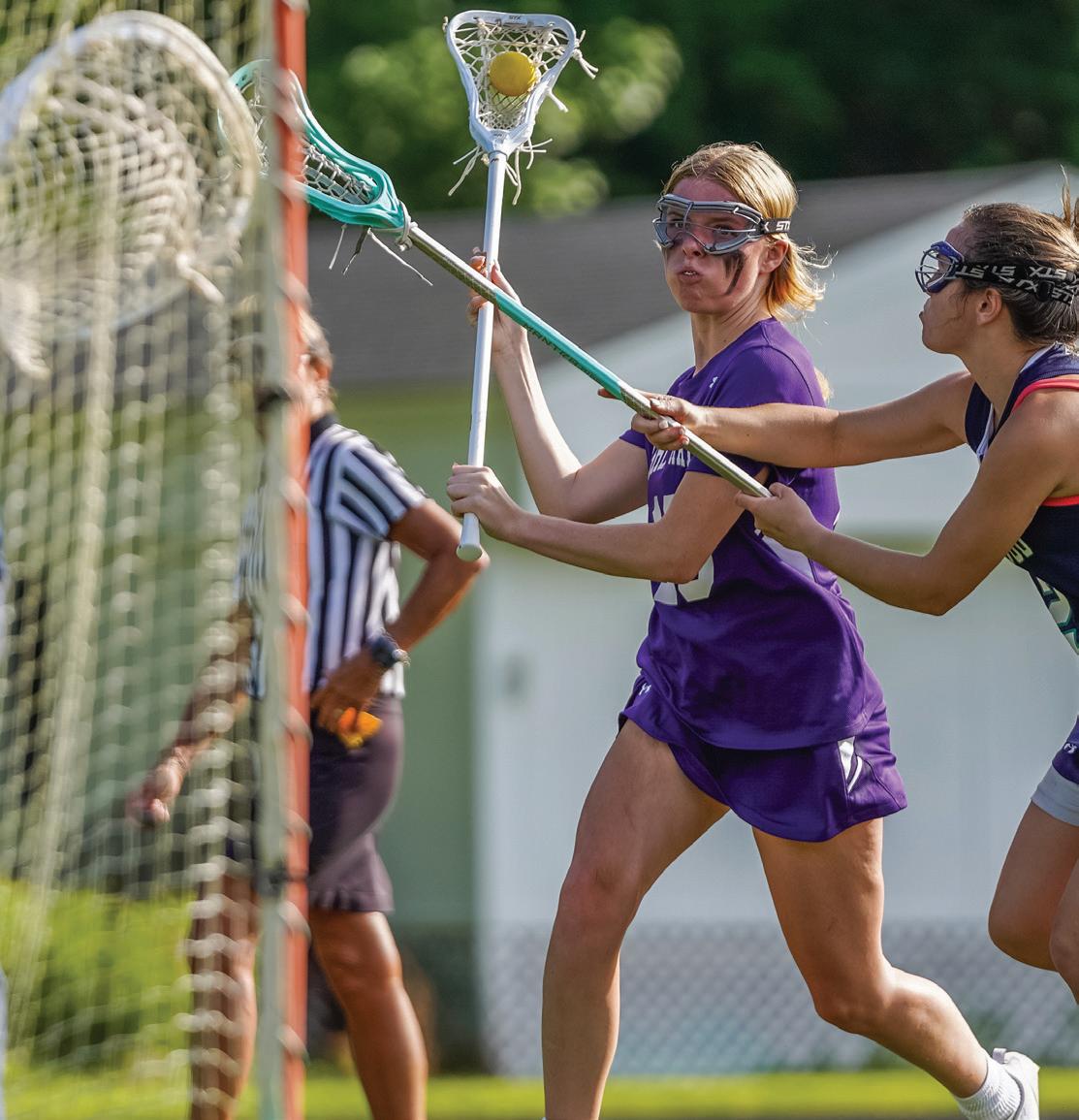
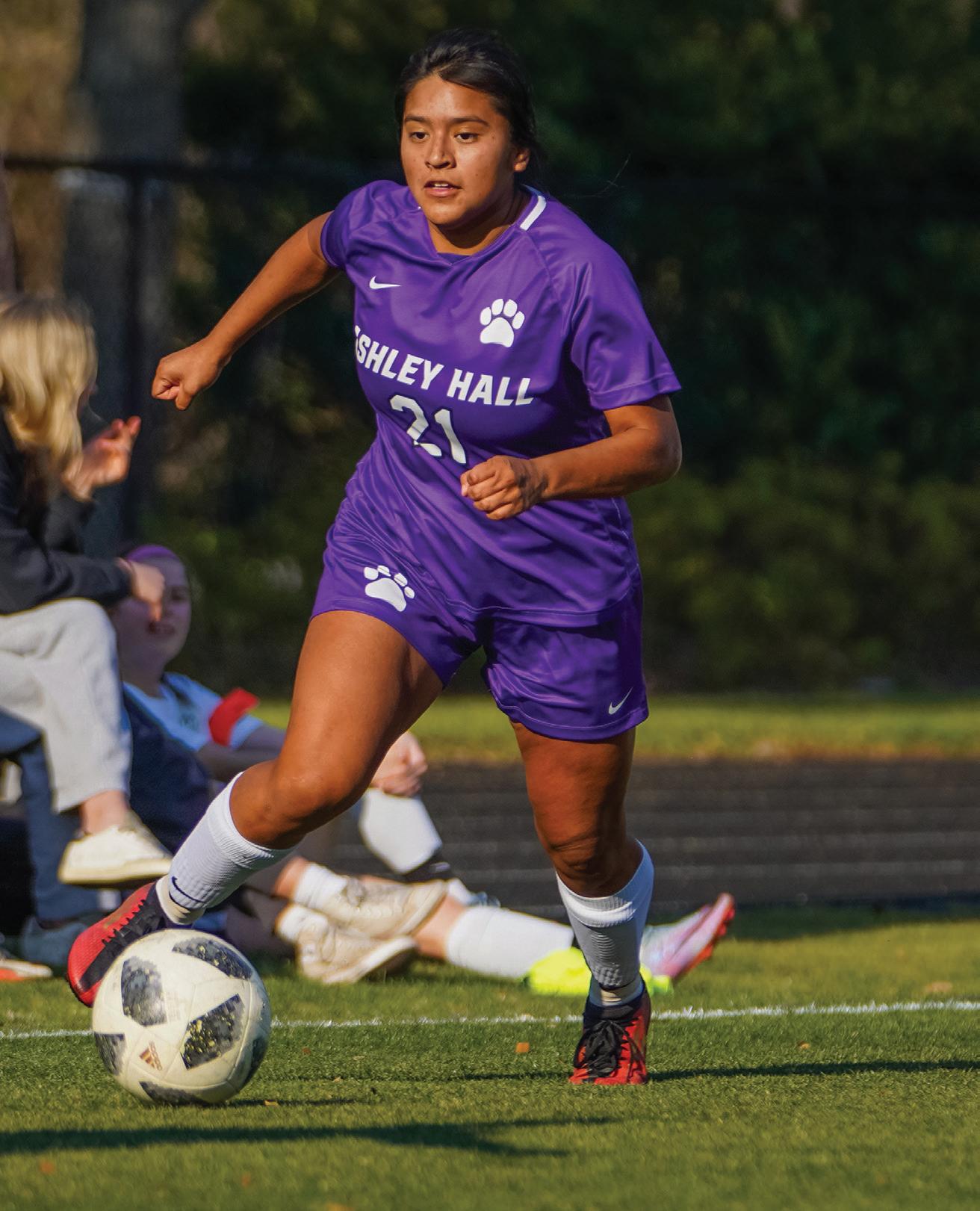 1.
1.
Improve performance: Athletes who participate in a well-designed strength and conditioning program may be faster, stronger, more powerful, and move more efficiently during competition.
Improve confidence: Athletes who invest time in strength and conditioning tend to develop confidence through desired changes in their body composition and the knowledge they gain of how to prepare their body for competition.
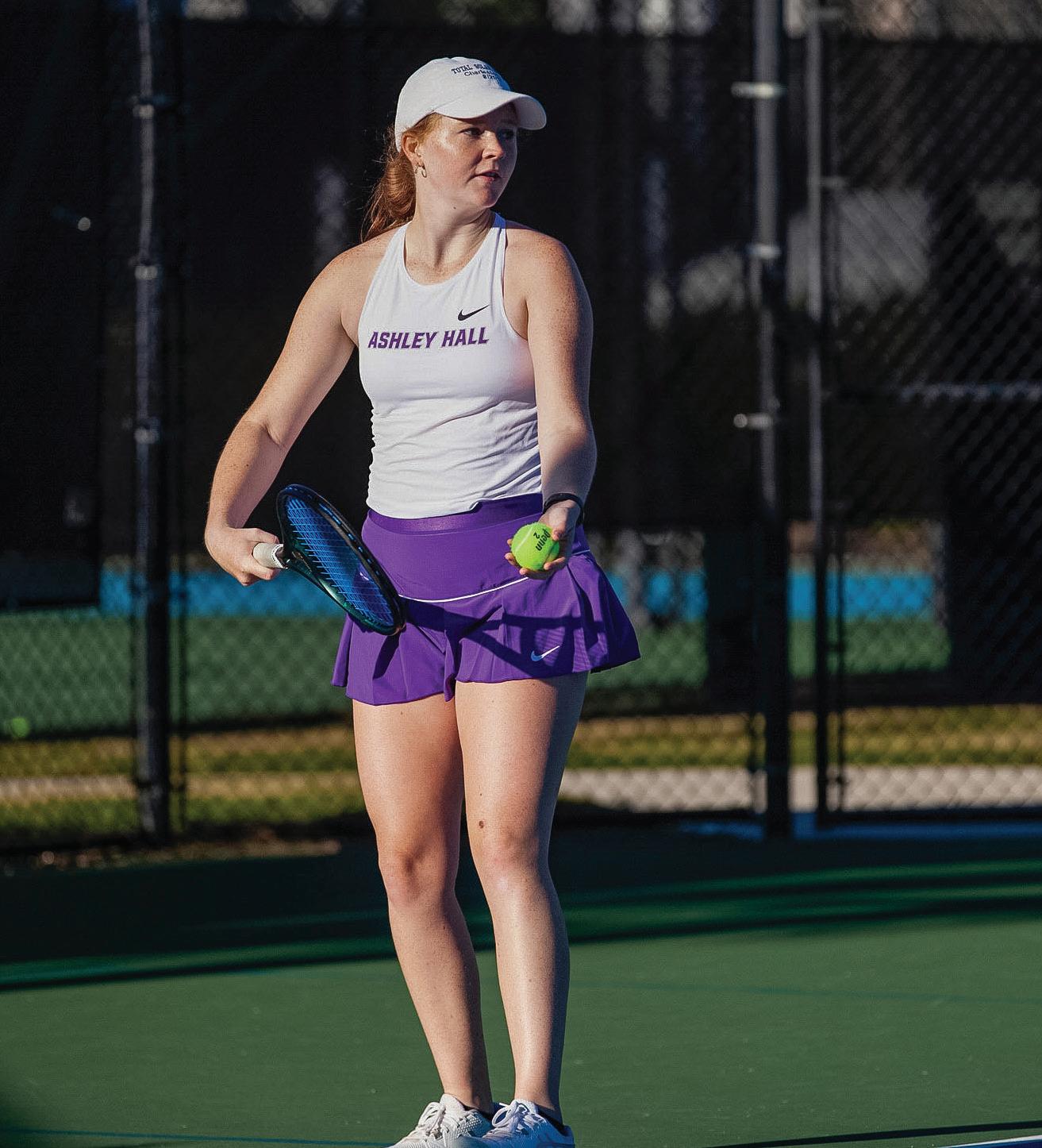

Improve overall health: In addition to increasing muscular strength, power, and endurance, regular participation in a youth resistance training program may positively affect mental health and alleviate many adverse health-related conditions.

 3.
4.
5.
| Clockwise from top center: Dia Timko ’25. Photo by Brian Principe | Isabelle Grek ’26 and Zy Jenkins ’27. Al Samuels
Photography | Mary Ella Prendergast ’23.
Photo by Nichole Sloan | Maclane Applegate ’25.
Photo by Brian Principe | Kennedy Atkins ’25.
3.
4.
5.
| Clockwise from top center: Dia Timko ’25. Photo by Brian Principe | Isabelle Grek ’26 and Zy Jenkins ’27. Al Samuels
Photography | Mary Ella Prendergast ’23.
Photo by Nichole Sloan | Maclane Applegate ’25.
Photo by Brian Principe | Kennedy Atkins ’25.
Somewhere over the rainbow…
That iconic melody was the first thing the audience heard when the lights went out before the first performance of Ashley Hall’s original production of The Wizard of Oz. The piano overture, played by the show’s accompanist Anna Brock, set the tone for a familiar story. But how it would come to life in Davies Auditorium on March 3, 2023, no one could have guessed.
Last spring, the announcement of the School’s Girls With the Will global education theme came just as Performing Arts Department Chair Aimee Phelan-Deconinck was searching for a musical for her students to perform. At the time, she had a notebook full of yellow Post-it notes, all with the name of a play and a protagonist to consider.
“The word ‘will’ danced in my imagination,” Phelan-Deconinck says. “I broke it down, wrote out all of its definitions, and I asked

myself what it means to have ‘the will.’ The will… to what?” As she rearranged her Post-it notes, they suddenly resembled a yellow brick road. In a light-bulb moment, she knew she’d found her heroine.
“What I loved about Dorothy is that her will is warm and flexible, making her able to consider the needs of others,” Phelan-Deconinck says. “She can change. She grows, and she can grow because she can let other influences come in. That doesn’t take her off her course, but it’s a will aimed toward creating a better community.”
With the story chosen, the Performing Arts Department set out to reimagine The Wizard of Oz for Ashley Hall to fit our time and our students.

Seventy-one student performers. Three sold-out performances. One original production that paved the way for what’s possible at Ashley Hall.
To transform Davies Auditorium into the flats of the Kansas prairies, Phelan-Deconinck enlisted the help of the real-life wizards at Innovative Event Services, a professional lighting, sound, video design, production, and installation company. Together, they focused on the use of projected images for scenic backgrounds and livestream video feeds to create a feeling of “new-fashioned nostalgia.”
“What interested me, from a technical perspective, in producing The Wizard of Oz, was the play’s relationship to the film as a primary source for many of us,” Phelan-Deconinck says. “With a good amount of distance in our collective memory, it opened up possibilities for situating The Wizard of Oz narrative in different media.”
Projection screens lined either side of the auditorium to display different backdrops for Dorothy’s journey to Oz, including bright green pastures, ominous dark skies, and, of course, a technicolor rainbow. The show’s technical team also utilized the method of live streaming to give the audience alternate views of the performance.
As for the stage, there were multiple. Chairs were turned to face the center of the auditorium to create half-moon audiences on either side of a wide aisle where the ensemble danced, the yellow brick road magically appeared, and Toto was carted away by the Wicked Witch. The light booth located at the back of the space was transformed into Dorothoy’s farmhouse making set creation needs minimal aside from a wooden house on wheels that spun in the tornado that would send Dorothy on her journey to Oz.
The cast of The Wizard of Oz included over 70 students in grades 5-12. The ensemble alone, which included nearly 40 performers, held six different parts throughout the show
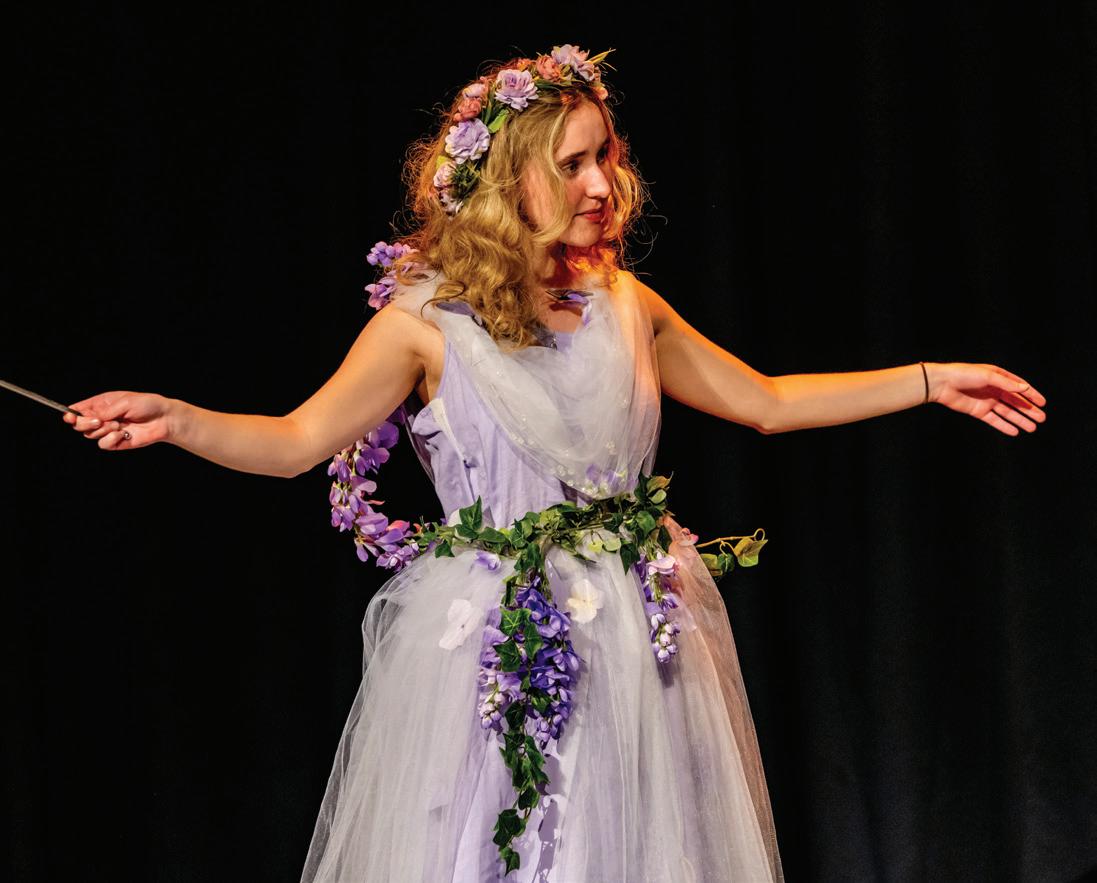


I saw this as a great opportunity to bring contemporary production standards to our students within a classic piece of theater to illustrate the many possibilities available to them for storytelling.
– AIMEE PHELAN-DECONINCK, DIRECTOR AND CHOREOGRAPHER OF THE WIZARD OF OZ| Top: Munchkins Mila Tang ’29 and Hartley Bennett ’29 | Middle: Wynn Staples ’24 as the Wicked Witch | Bottom: Lizzie McGinnis ’23 as Glinda
Playing Dorothy in The Wizard of Oz was a dream I’ve had ever since I was a little girl. I grew up watching the movie and singing ‘Somewhere Over the Rainbow.’ This was a big opportunity for me because it gave me a chance to bring Dorothy, a cherished iconic character, to life for everyone. This was also a big step for me in my musical theater career because it is something I would love to pursue in the future. Playing Dorothy is something I know I will cherish forever.
– ELENA HOLLISTER ’26including the memorable munchkins and jitterbugs to the captivating winged monkeys and Ozians. “Our ensemble, the lifeblood of the play, worked very hard on a steep learning curve to get their costume changes perfected,” Phelan-Deconinck says. They had a total of six throughout the evening, and this magical mix of both faculty and students kept the audience on the edge of their seats from one scene to the next. But the wonder and surprise created by the cast went far beyond a single performance.
From the start, Phelan-Deconinck envisioned casting three Dorothys in The Wizard of Oz, one from the Intermediate Program, one from the Nautilus program, and one from the Upper School. “Dorothy is an every-girl growing up in a rapidly changing world which is influencing her identity and shaping her sense of purpose,” Phelan-Deconinck says. “Who is she at different ages? How does she interpret challenges? Dorothy is not meant to fit into a single mold.”
In turn, each of the three performances of The Wizard of Oz starred a different lead actress. As Dorothy, the show featured seventh grader Vera Galvan ’28 on opening night, fifth grader Rosalyn Bailey ’30 in Saturday’s matinee, and ninth grader Elena Hollister ’26 for the closing performance.
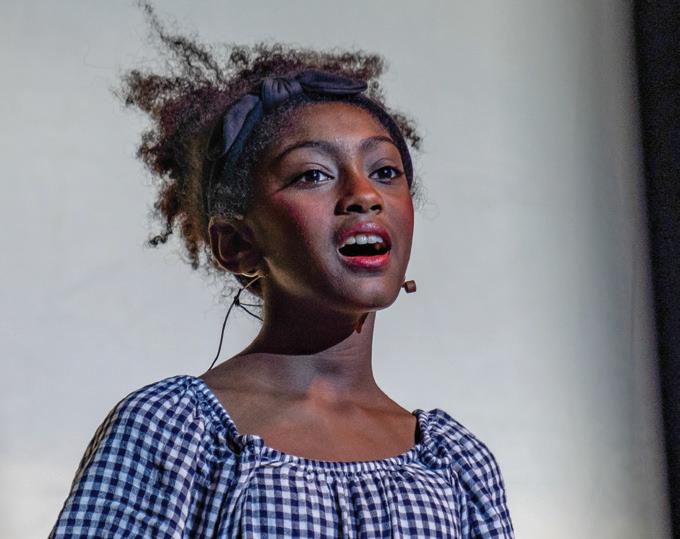


Students in grades 5-8 tried out for the musical during an in-class audition unit created by Phelan-Deconinck. The unit focused on defining the skill set needed for each character, then finding the performer with that set of skills. The aim was to make the audition process inclusive and accessible and to let each performer bring their individual abilities, experiences, and views to the stage.
“When practicing, all of us saw a clear difference in the way we portrayed the character,” Galvan says of becoming Dorothy. “Elena, the oldest, conveyed Dorothy as a young woman with much knowledge of the world and more adult perspective of her problems. When Elena and I saw Rosalyn perform, we both saw a younger Dorothy. This would be logical as the gap in grades was major for us. All in all, being able to see the different ways that the two portrayed Dorothy helped me to refine my lines and acting.”
For Hollister, being one of three Dorothy characters not only enhanced her acting skills, but her leadership skills. “Being the oldest Dorothy out of the three of us was an amazing opportunity for me to work on my leadership skills because I knew I had two wonderful girls that I had to be an example for,” Hollister says. “The three of us got super close. I view them as my younger sisters, and I will always have a very special place for them in my heart.”
The opportunity to connect with students in different grades created a sense of camaraderie within the entire cast. “My favorite part of being in The Wizard of Oz this year was getting to act as a mentor to the fifth and sixth graders,” says Wynn Staples ’24 who played the Wicked Witch. “It was so cool, and it made me feel so honored knowing
that they looked up to me.” And it’s safe to say that mentorship went beyond those involved in The Wizard of Oz this year.
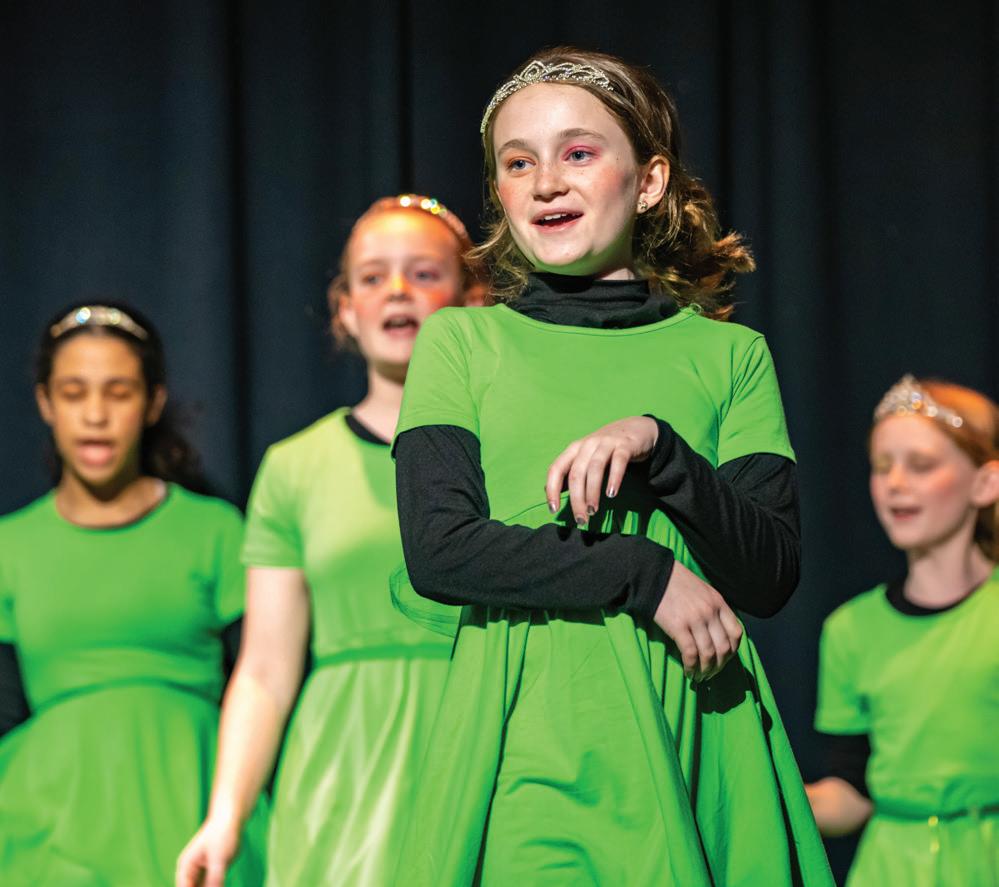

After the matinee performance, cast members took the time to meet with audience members and fans outside Davies Auditorium. Students excitedly waited in line for autographs full of admiration for the actresses and the characters they portrayed, no doubt being able to see themselves in both.

“We are both similar,” says Bailey of Dorothy whom she played on Saturday. “We both have a little dog, we’re both girls, and we both will always help others on our journey through life. We both have ‘PQV power.’”
“Dorothy sees the potential in everybody, and that I think speaks to goodwill,” Phelan-Deconinck adds. “Not just my will or strong will, but Dorothy’s strength of will is that it’s goodwill, and then success happens – success beyond what she had imagined. The other side of the rainbow is just her with a bigger point of view.”

A fter months of studying maritime history and navigation with Upper School faculty member Roscoe Davis, Ph.D., 12 members of Ashley Hall’s Offshore Leadership Program sailed out of Portsmouth, Virginia last October for a week-long voyage at sea – not as students, but as crew.
Aboard the Liberty Clipper , a 125-foot tall ship, they split into groups to maintain the vessel according to a traditional three-watch system. Members of A-Watch, B-Watch, and C-Watch worked around the clock, through good weather and bad, rotating through daylight shifts from 5-8, 8-12, 12-4, and 4-8, and night shifts from 8-11, 11-2, and 2-5. They also took turns standing at the helm as junior watch officers, responsible for keeping the compass needle steady and directing their crewmates to carry out boat checks every hour, on the hour. Then they carefully filled out the ship’s log to keep the Clipper on course for the duration of their sail across the Chesapeake Bay, into the Atlantic, around Cape Hatteras, and into Charleston Harbor.
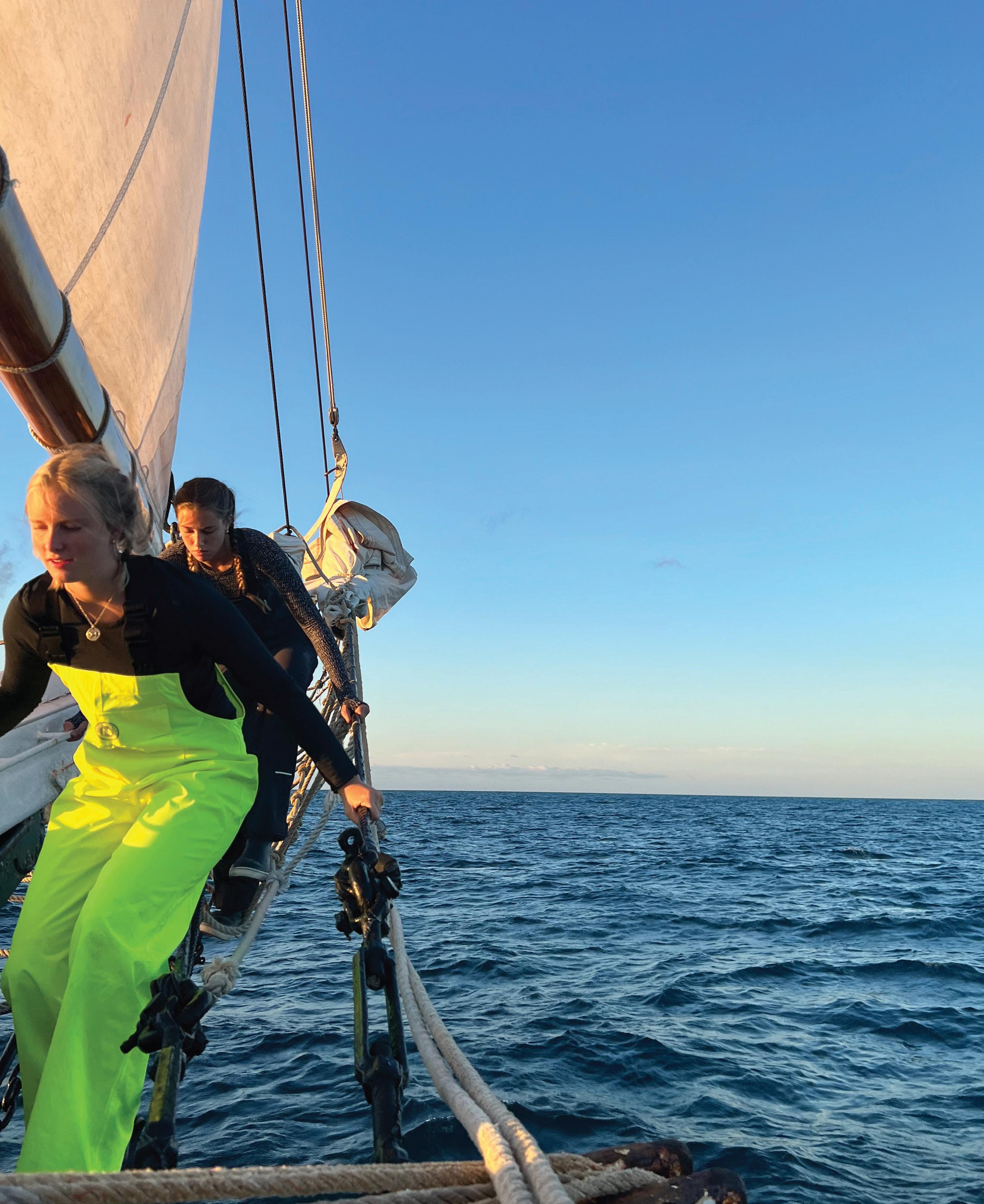 | Left: C-Watch crew members Pierce Wilson ’23 and Eliza Groat ’24 prepare to tack at the end of a sunrise watch.
| Left: C-Watch crew members Pierce Wilson ’23 and Eliza Groat ’24 prepare to tack at the end of a sunrise watch.
OFF DUTY: Students are required to journal on a daily basis while at sea which will aid in their final assignment for the course: a 5-page self-reflection essay about their experience. “You are the main character in this journey,” Davis tells his sailors each year. “And all great stories depict a character who goes through a transformation.” Whether it’s overcoming seasickness, facing fears of the unknown, or falling in love with sailing, every student returns with a tale to tell.
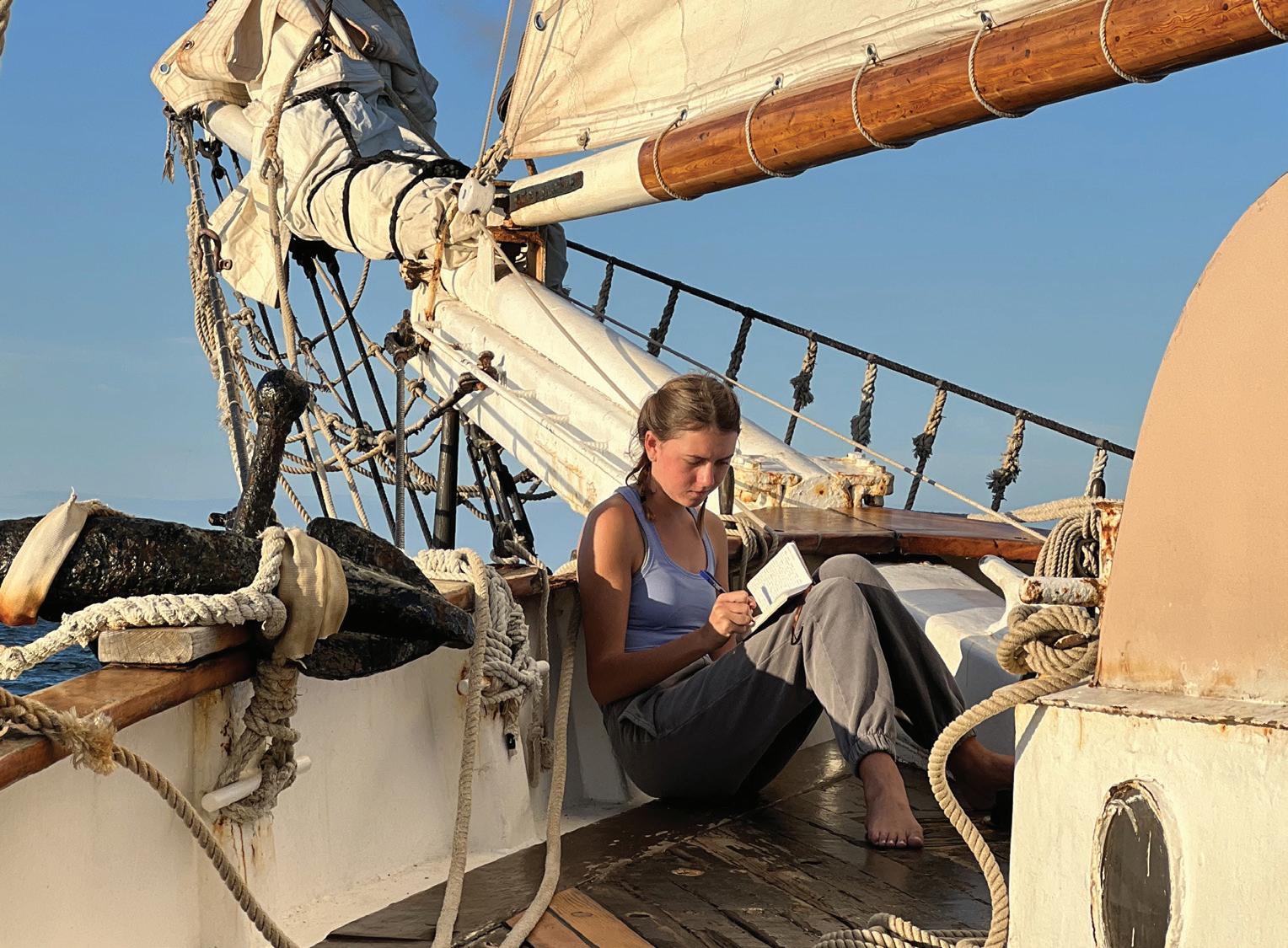
While sailing the LibertyClipper , Ashley Hall students and faculty chaperones were taken under the wing of the ship’s full-time crew, which included a captain, first mate, watch leaders, deckhands, an engineer, and a cook. While sailing is still primarily a male-dominated profession, there were two professional female sailors on this year’s crew – a first in the program’s history.
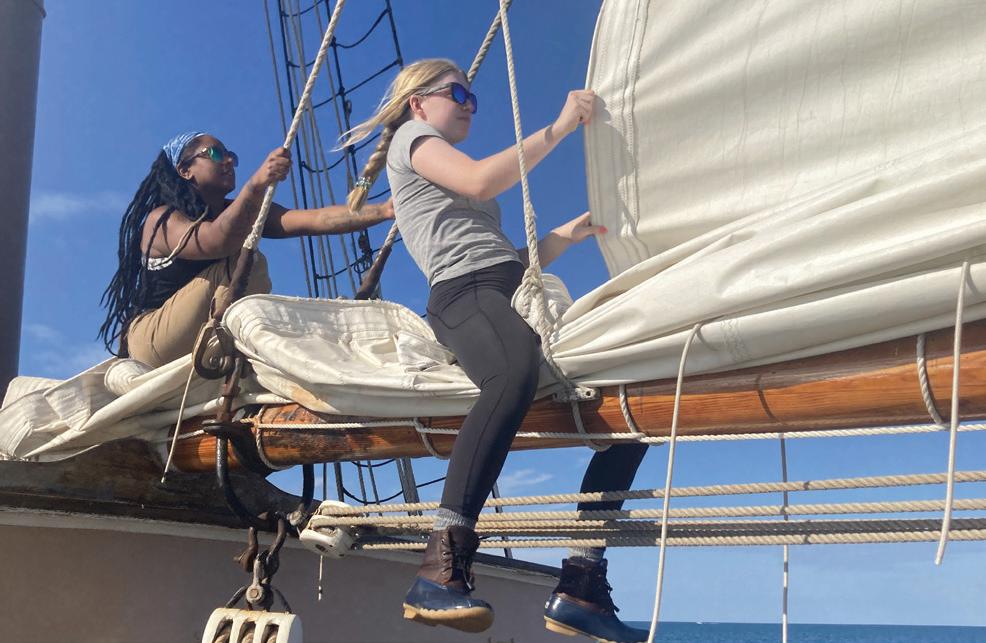
Ashley Hall Travel Programs are proposed annually in a manner similar to an academic course. Here are the planned trips for the 2023-24 school year:
FALL 2023
MODEL U.N.
Williamsburg, Virginia | Grades 9-12
LOUISIANA BAYOUS AND BYWAYS
New Orleans | Grade 12
BUILDING BRIDGES NOT WALLS
New York City | Grades 10-12
SPRING 2024
OFFSHORE LEADERSHIP PROGRAM
Eastern Seaboard | Grades 9-12
NAUTILUS STEAM TRIP
Orlando, Florida | Grade 8
FRENCH LANGUAGE IMMERSION
Quebec, Canada | Grades 6-8
MODEL U.N.
Washington D.C. | Grades 9-12
NIGHT WATCH: It’s nearly impossible to tell who is who during a 2 to 5 a.m. watch aboard a tall ship in the middle of the ocean. Crew members hide under the hoods of their jackets to keep warm and turn into dark shadows while on deck. The only light allowed during this shift must be filtered through a red lens to preserve everyone’s night vision.

AMALTHEA SCHOLARS PROGRAM
Spoleto, Italy | Grades 8-10
SPRING BREAK SPORTS AND SERVICE TRIP
Jamaica | Grades 9-12
SUMMER 2024
FRENCH LANGUAGE IMMERSION
Morocco | Grades 9-12
Interested in signing up? Contact Global Education Coordinator Jonathan Perkins at perkinsj@ashleyhall.org
Counselors Katie Neighbours, Lyndsey Bowles, and Jennifer Vaughan have over 50 years of combined professional experience. Here’s how they recently restructured the counseling department at Ashley Hall to serve their students even better.

Every week, Ashley Hall counselors Katie Neighbours, Lyndsey Bowles, and Jennifer Vaughan leave their respective corners of campus to meet as a department. Between them, they work with students in kindergarten through twelfth grade. Despite their daily conversations with students being different, they come together each week to share resources, advice, and current trends they’re seeing in both the news and the School’s very own hallways.
While it may seem small, Ashley Hall’s counseling department is now the largest it’s ever been with the addition of Bowles, the team’s counselor dedicated to working with students in grades 5-8, who joined at the start of the 2022-23 school year. Prior to her arrival, Neighbours worked with grades 7-12 for eight years, and Vaughan with grades K-6 for six respectively. “Last year, we both noticed we felt stretched very, very thin in terms of trying to meet the needs of all our students,” Neighbours says.
“I think the pandemic highlighted a lot,” Vaughan adds. “The rise of depression and anxiety among kids is now not only very much in the news, but also on people’s minds. It was a really rough time for a lot of our students and continues to be. Some kids were out of school two or more years – talk about the emotional-social development missed during that time.”
In fact, according to data from the Centers for Disease Control and Prevention, in 2021, more than a third of high school students reported they experienced poor mental health during the COVID-19 pandemic, and 44 percent reported they persistently felt sad or hopeless during the past year.
“We are lucky that Ashley Hall has always prioritized the emotional and mental health needs of its students through supporting a robust wellness program,” Neighbours says. “Now, it has expanded its counseling department to give our students more resources. I’ve heard so many students say that the relationships they have with faculty here is the best thing about our School. We are just another extension of that strength. Our students know that they’re surrounded by supportive, caring adults, and they can reach out for help when they need it.”

This year, Neighbours worked with grades 9-12, Vaughan worked with grades K-4, and Bowles settled into her new role serving the middle grades. The ability for each counselor to focus on a smaller cohort of students has been a game changer.
“The social and emotional needs of students at each stage of development are so different,” Neighbours says. “In turn, they require different types of support. You can think of it as a progression: When students are younger, they’re naturally very self-focused and should be. Starting with early adolescence, they become more aware of their self in relation to their peers, which is both good and bad. Then in high school, the goal of a counselor is really to empower them to make good decisions and recognize that they can have an impact on the greater world.”
Here, in their own words, Vaughan, Bowles, and Neighbours take us through the different needs of their students to shine a light on how to best support them at every stage of development.
PARENTS AS PARTNERS As counselor for grades kindergarten through fourth, I probably involve parents more than the others simply because of the age of my students. Being partners with families as much as possible is very important because you need to work as a team with the teacher and the parents. This is a little
It’s all about development.
Each developmental age has so many unique changes to face and things to overcome and grow through. It’s never harder in one grade or another, it’s just about recognizing they are different.
– LYNDSEY BOWLES, ASHLEY HALL MIDDLE GRADES COUNSELOR
different because when they get older, it is more important for the child to feel like there’s a sense of confidentiality. In kindergarten, first, second, even third and fourth grade, however, they tell their parents everything.
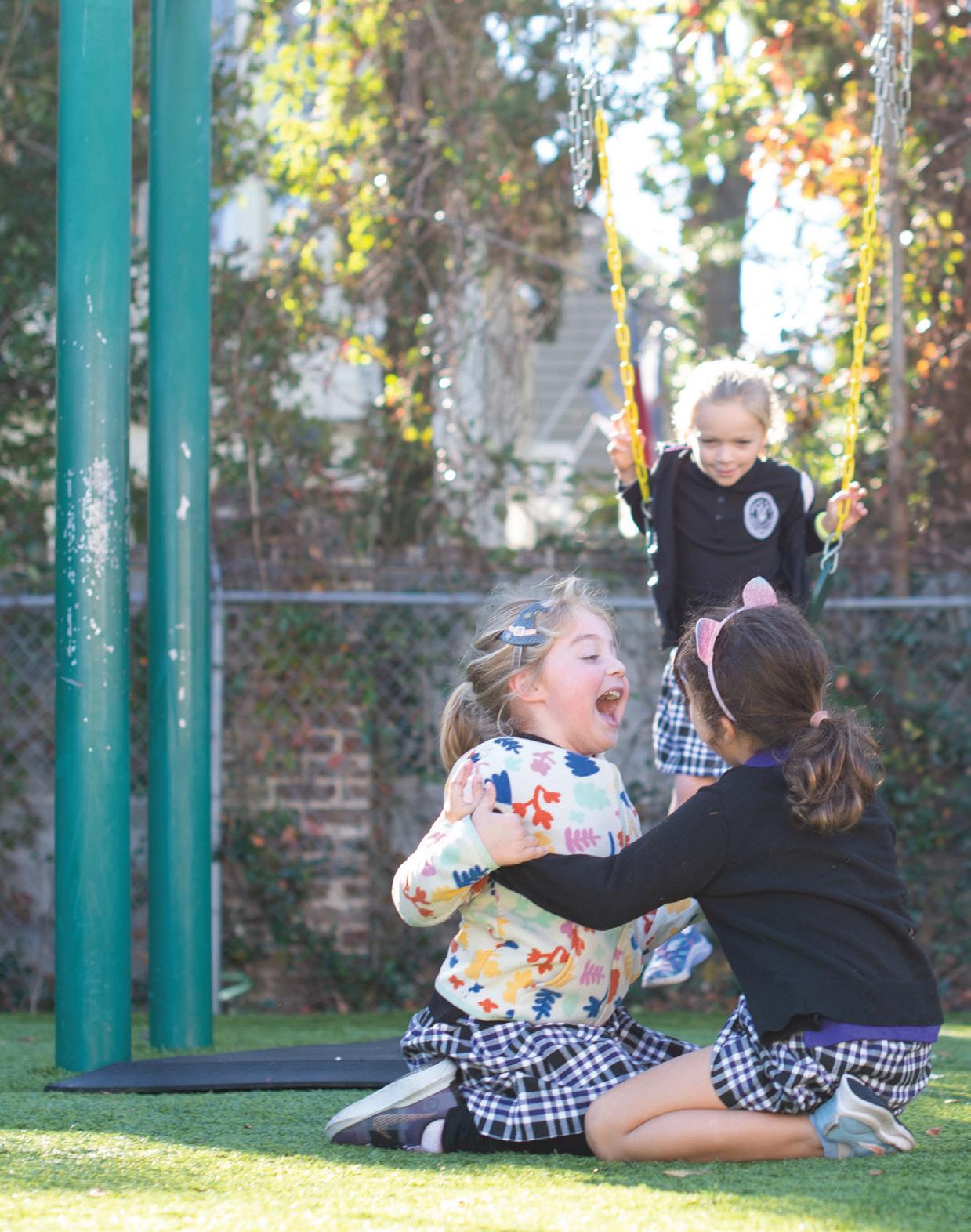
FOCUS ON SOCIAL I would say that one of the biggest things I deal with is problem solving with friendships. For a long time, social issues were always first in terms of prevalence and second was anxiety. During the pandemic, it was anxiety and then social, but partly it was because they couldn’t socialize with one another. But now it’s kind of flipped back. Anxiety now comes second to social issues and shows itself with perfectionism and the anxiousness that it brings in the lower grades.
BUILDING BLOCKS My students are still learning the very basics of problem solving. They still need a lot of guidance and help with that. So for example, I don’t even start talking about the difference between tattling and speaking up until second grade because they are just developing those skills. And they do develop them. Then, when they get to middle school, they start to develop them in context. So they may have learned a skill in second, third, or fourth grade, but it’s different when they have to use it with a friend in middle school.
GROWING PAINS During the middle school years, everything’s just rapid – rapid changes physically, emotionally, socially. Since the growth is so rapid, nobody can quite keep up. It creates some difficulty with emotional regulation for the students and those who are trying to support them, whether that be the faculty or the parents, so bridging that gap of understanding is important.
AIDING INDEPENDENCE When students move into those middle years, they have this extreme desire for independence from adults. They turn to peers more than they do to adults, yet they’re not quite cognitively or emotionally ready to manage the new situations they will face. So, they need guidance, and that’s why devoting time to grow relationships with students as a counselor is a priority during these influential years.
OVERCOMING INSECURITY Research is very strong supporting the fact that at the onset of puberty, female self-esteem and selfconfidence just bottoms out. There’s a big gap that exists between boys and girls in that regard. But when it comes to my wellness classes, the level of openness, honesty, and vulnerability is immense compared to

my previous experiences at coed schools. We can go places much deeper than I once could because while they are insecure, they feel they are in a room full of people who are their equals. Regardless of it being at a historically single-gender school, that is truly the culture that we’ve been able to cultivate at Ashley Hall, and it’s crucial to foster it in the middle grade years.


SET VALUES With physical and hormonal changes in puberty, insecurities spike which then makes students ask: What are my values? Suddenly, they are comparing themselves to everyone else. In ninth grade, they’re still struggling to figure it all out. In tenth and eleventh grade is when you really see them take on a different maturity. Within the wellness class that I teach, which is a required course for high school students, we do a values exploration in the first unit. It’s the foundation, and it encourages them to reflect: What things are really important to me and what do I really care about? Then we circle back to that always when we talk about healthy communication, boundary setting, and peer pressure. It all comes back to your values.
TEAMING WITH TEACHERS In the Upper School years, I get mostly self-referrals – students coming into my office to talk. But I also attend teacher meetings and so every once in a while, a teacher will raise an observation and ask me to check in on a student. Counselors are really a team with teachers. Between us, we kind of all know what’s going on with pretty much all our students. That’s one big benefit of being in an independent school – it’s hard to slip through the cracks. As counselors, we also have the opportunity to meet with teachers and administrators and come up with a plan of how to best support students.
MENTAL HEALTH SUPPORT As expected in any school, some of what I see in high school is more serious. The older the person, the bigger the problems. They can manage so many things on their own at this age, like friendships and social conflicts, because they’ve gained the skills. I get some of that, but I also get a lot of larger mental health concerns where students are feeling overwhelmed or stressed. Sometimes it may require outside intervention, but I think we see issues before they get extremely detrimental. That’s truly the benefit of having multiple counselors on campus – students always have a resource readily accessible to ask for help; then we can help manage from there.

As teachers in Ashley Hall’s Reggio Emilia-inspired Early School, we facilitate our students’ learning through a variety of means –providing them with natural materials, planning activities based on their interests, and asking open-ended questions. We do all of these things to create an environment that is stimulating and engaging for each child. What setting is more exciting than the outdoors?
Creating an outdoor space that provides structure, yet is openended and flexible, will give our youngest learners the means to explore, initiate their own learning, construct knowledge, and the ability to create a lasting relationship with the natural world.
Welcome to our new outdoor classroom.

Experiences from the pandemic led Early School faculty to focus their professional development on creating a proposal for an Early School outdoor classroom to be built on campus.
There is no computer program that can replicate the smell of the grass after the rain, the tickle of butterfly feet, or the breeze as clouds float across the sky. Outdoor learning experiences like these are impossible to fabricate, and so are their benefits.
Studies show that exposure to nature is beneficial to the cognitive, physical, and emotional development of all students, regardless of age. Outdoor activities naturally help young children in particular develop essential motor skills like coordination, agility, balance, and dexterity. Being outdoors also encourages young children to take risks and builds self-confidence and resilience.
Today, more than ever, children need opportunities to connect with nature. To foster this connection, students in the Early School have been taking field trips to Ashley Hall’s Johns Island Campus since 2017. Fondly known as the Nature Retreat, this space was created by faculty, including our Early School Atelierista Wendy Robbins, who saw the need for our students to spend more time exploring the natural world. In 2020, however, the pandemic would temporarily halt our nature excursions.
“I truly believe learning to teach well happens in context and through conversations with colleagues. In 2021, I participated in a nature-based professional development program at the University of Delaware Lab School. Over the past 10 years, I have also visited several forest schools around the country, where children spend their entire day outdoors. The outdoor classroom offers so many wonderful opportunities for language and literacy development, whether it’s through dialogue about the natural world or by providing a wondrous, textured, and dynamic habitat for imaginative play. In the outdoor classroom, I have witnessed some of the richest learning and most beautiful discoveries take place.”
When we returned to campus, many teachers were grappling with uncertainty. But to our surprise, the new year exceeded all our wildest expectations because we spent a lot of time outside. The children played joyfully uninhibited outdoors, expressing their thoughts, their ideas, their understandings, and their fears in a myriad of different languages. They ran, climbed, jumped, and tested the limits of their strong bodies. They splashed in puddles with abandon. We frequently visited the beloved Ashley Hall Bear Cave, listening to the sounds of nature by the reflection pond, collecting natural treasures, and observing patterns in nature.
That year challenged us all to be better teachers–to listen more and talk less, and to truly let the children lead. That challenge, as well as the rapid growth of the Early School, sparked renewed interest in building an engaging outdoor learning environment for our Early School students on Ashley Hall’s campus.

Under the leadership of Early School Director Diane Fletcher, we set out to feed the needs of our students and our thriving program, which has nearly doubled in size in the past four years, by intentionally creating a new space – an outdoor classroom that parallels the experience teachers offer each and every day indoors.
In October 2022, Nature Explore, a nonprofit program that is part of the Dimensions Educational Research Foundation, visited Ashley Hall to develop a comprehensive and practical design for a sustainable and nature-rich outdoor classroom. The goal of the Nature Explore program is simple: help make nature an integral, joyful part of children’s daily learning. Through their certification program, their team helps educators create an array of defined outdoor spaces
Children are innate scientists who love to experience new sights, scents, sounds, and textures.

that support the developmental needs of young children and provide opportunities for children to explore with a multitude of open-ended materials.
Nature Explore experts met with Early School parents, teachers, students, and administrators to gain perspective of our collective vision. During their visit, they listened and brainstormed with us, and they also conducted a workshop to train all our Early School educators on the importance of nature and its positive impact on learning as well as how to create open-ended provocations for children to discover. From there, we worked collaboratively with an outdoor classroom designer and education specialist to turn our dream into a reality.
As of March 2023, the N.E. Miles Early Education Center at the College of Charleston has the only certified Nature Explore Classroom in the state of South Carolina. Our new space is slated to be recognized as the second as we have successfully incorporated the program’s national standards. But it was also important to us to honor, celebrate, and highlight the history and traditions of Ashley Hall when creating our new space.
Our School’s founder Mary Vardrine McBee was known for her gardens and her green thumb. During her tenure at Ashley Hall from 1909 to 1949, plants bloomed all over campus. We wanted the campus to abound in full bloom once again with rows of garden beds that community members could cultivate with native plants that invite pollinators. We sought to create a place where
we could inspire children to be thoughtful conservationists and stewards of the land they call home for perhaps some of the most formative years of their lives.

In February, the Early School hosted a panel discussion of “Nature’s Last Hope” by Douglas Tallamy. It was an inspiring evening of discussion around native plants led by faculty members and parents, and it inspired us to plan our first ever Ashley Hall Planting Week. For this special event, children created personalized invitations to their families to invite them to our School to plant a variety of native plants in our newly established garden beds.
Most importantly, we wanted our outdoor classroom to be a space with endless possibilities for connection – connection with nature, connection with one another, connection with the larger community, and cross-curricular connections that reflect the Ashley Hall learning spiral. Its evolution, just like nature, will continue to change and flourish over time as long as we nurture it.
Our outdoor classroom is a metaphor for life’s journey of observing the evolution of change, problem solving, and celebrations. It will be forever evolving, hour by hour, year by year, generation by generation.
– DIANE FLETCHER, EARLY SCHOOL DIRECTOR
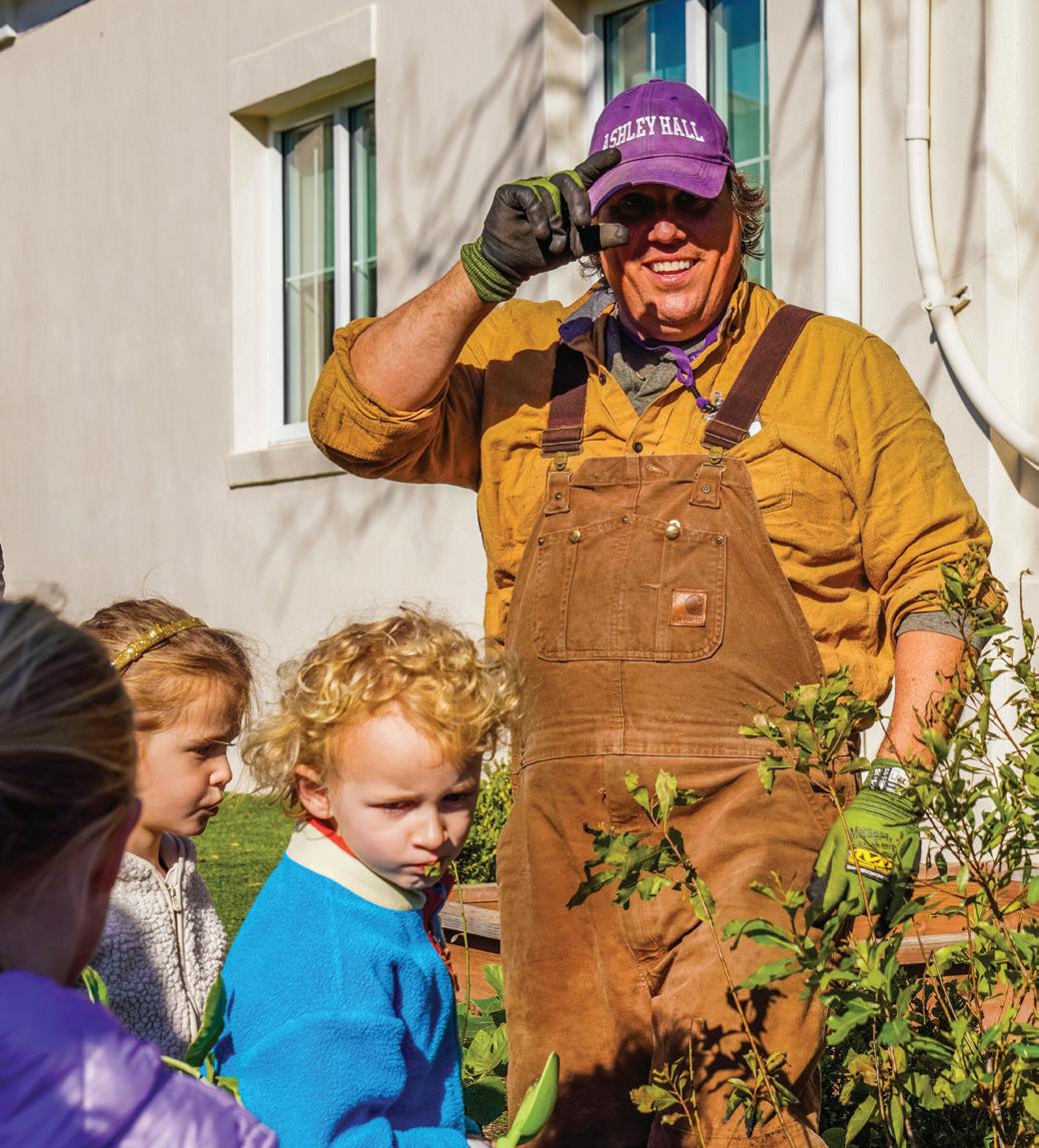
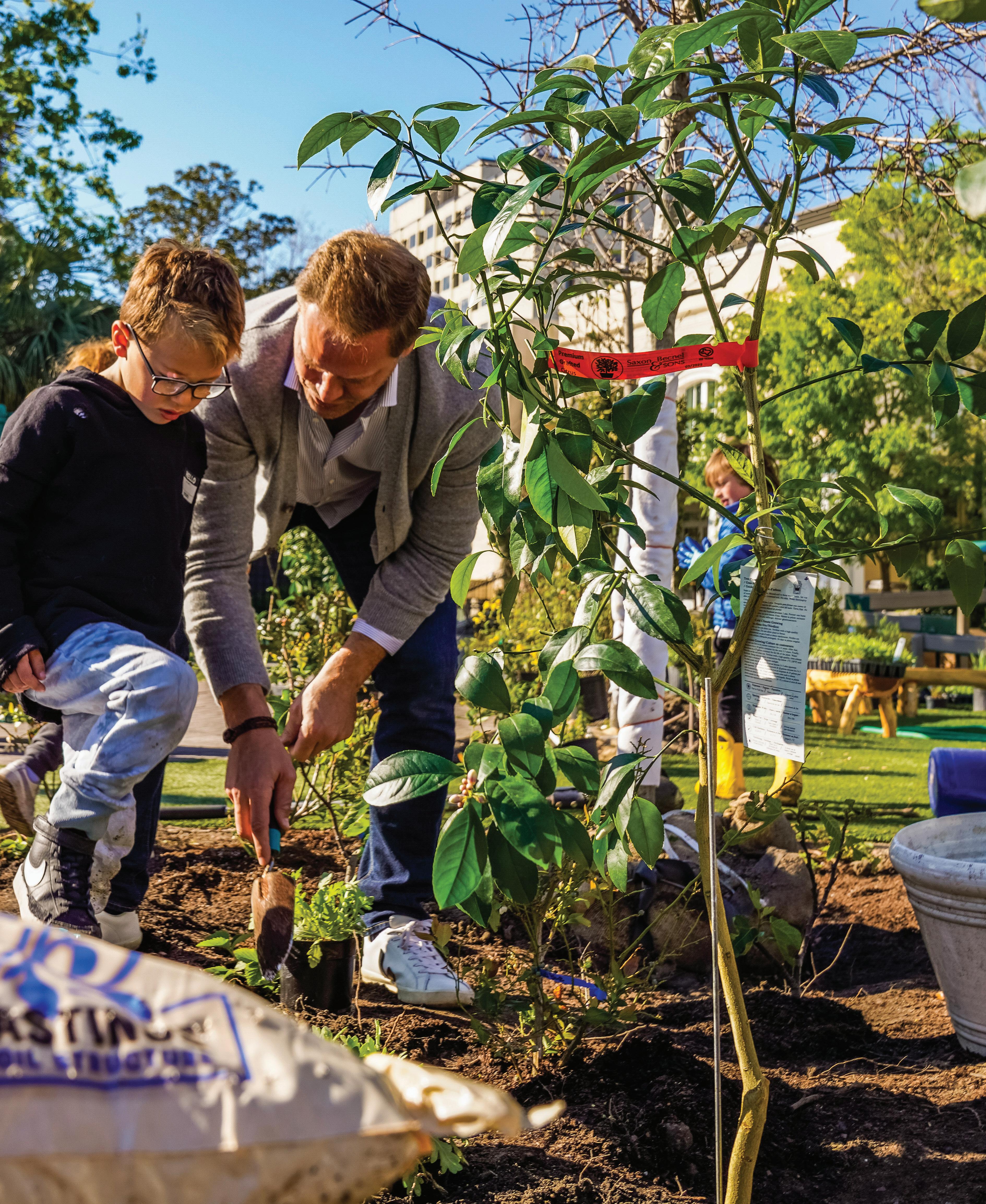
In March, Early School students and parents spent five sunny days planting over 400 plants outside the Ross Early Education Center to complete its new native plant garden. Led by Special Project Manager for Operations Ben Buckley-Green, they placed everything from tall trees to edible herbs into the ground. But every plant had one thing in common: It was selected by a student.
Each class submitted plants they wanted to see in our garden. From there, Buckley-Green carefully culled through requests and ordered plants suitable for our campus with similar traits. “Their list became our garden.” Here are just a few plants that now call the Early School’s new outdoor classroom home:
“Little pink plants”
Whirling Butterflies, Gaura lindheimeri
“Blue flowers with butterflies”
Bee Balm, Monarda fistulosum
“Sparkly trees with sparkly stars”
White Fringetree, Chionanthusvirginicus
“Fuzzy flowers”
Splitbeard Bluestem, Andropogonternarius
picture 1)
PAVERS/BLUESTONE (OPTIONAL)
picture 2)
PAVERS/BLUESTONE (OPTIONAL)
TEXTURES AND COLORS
picture 3)
TEXTURES AND COLORS
INSTRUMENTS AND SCARVES AREA
PAVERS/BLUESTONE (OPTIONAL)
STUMP SEATING
SENSORY TABLE
PAVERS/BLUESTONE (OPTIONAL)
TEXTURES AND COLORS
PLANTINGS

STRUCTURE FROM WILLOW
picture 7)
A designated entryway makes every space easily accessible, so we can welcome all divisions into our ever-evolving creative outdoor workspace.
SAND (picture 8)
FOR SOIL
DEPTH
Sensory play is all about feeling, touch, and texture. It encompasses everything from playing with water and molding mud to dumping sand and digging in the dirt.
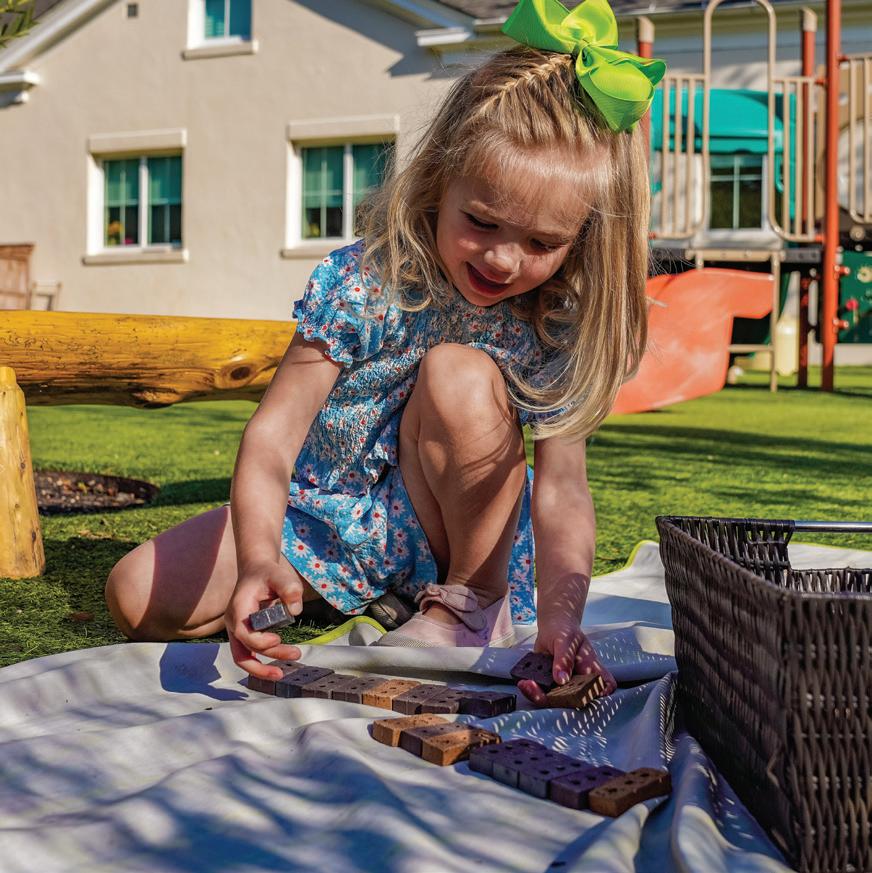
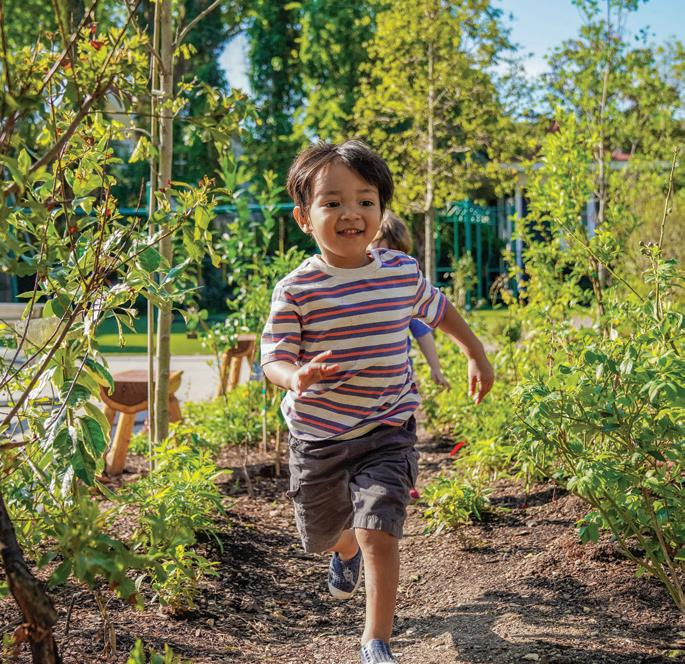

In our gathering area, teachers and students can focus on setting intentions for how they will spend their time in the outdoor classroom.
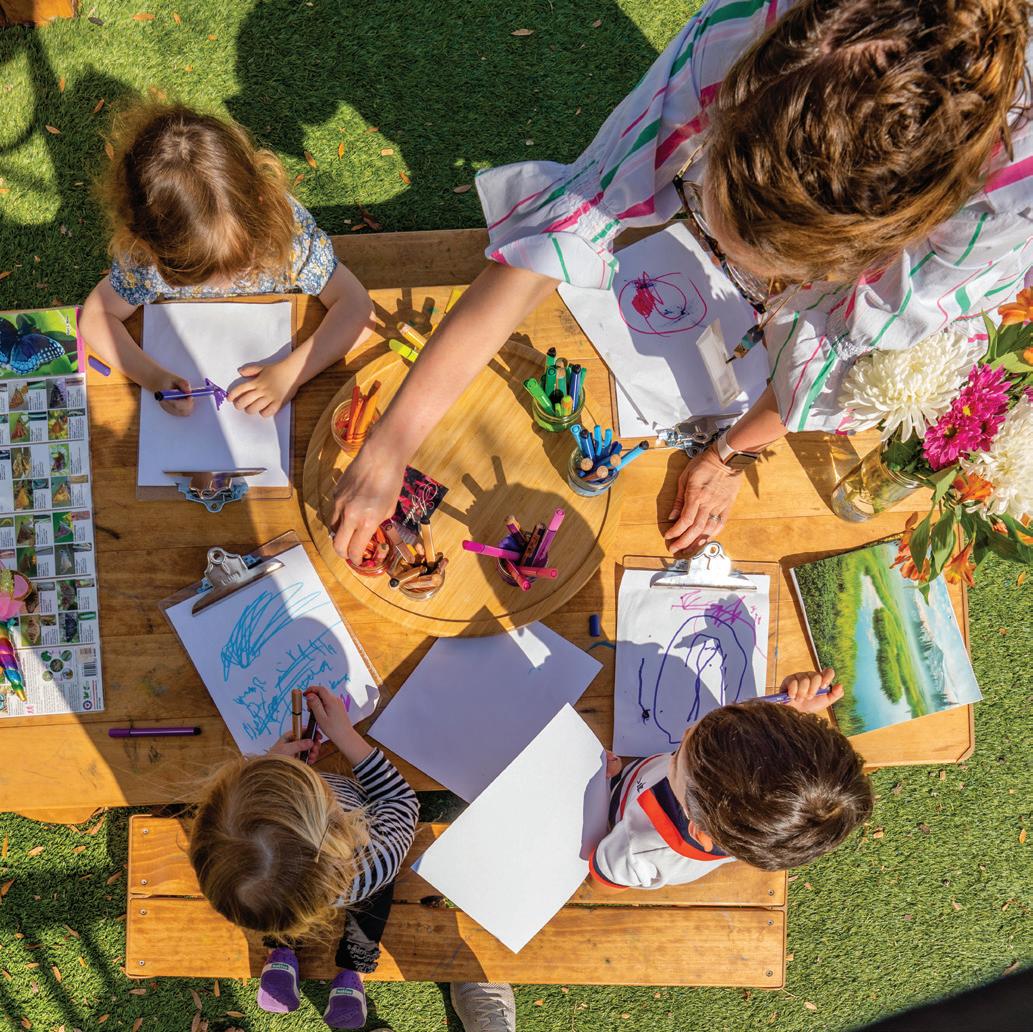
• CASCADE WATER TABLE (picture 9)
In order for an outdoor space to be considered a certified Nature Explore Classroom, it must include twelve defined areas that are designed for open-ended exploration and discovery. Overall, these spaces are fluid, and while they are geared toward our youngest learners, they really can be enjoyed by children (and adults) of all ages.
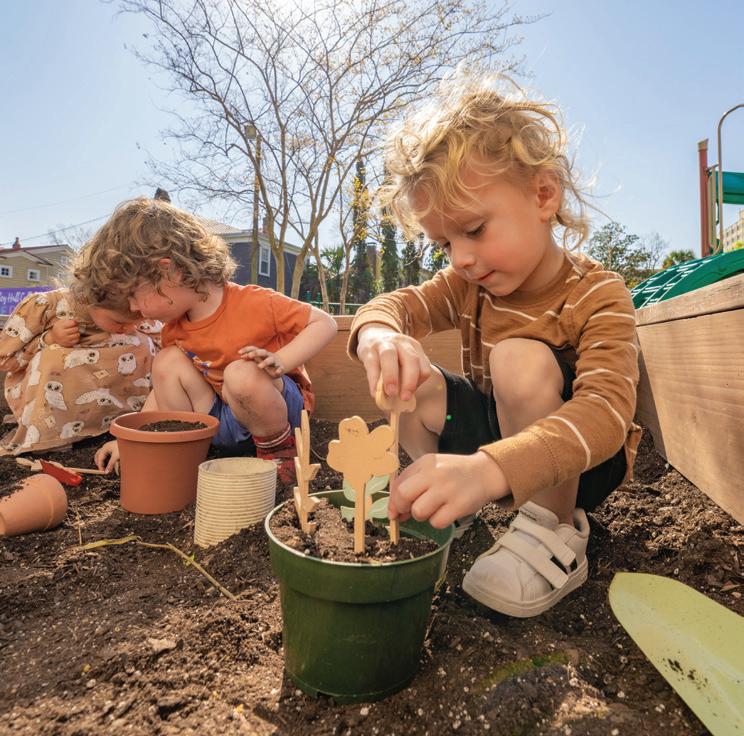
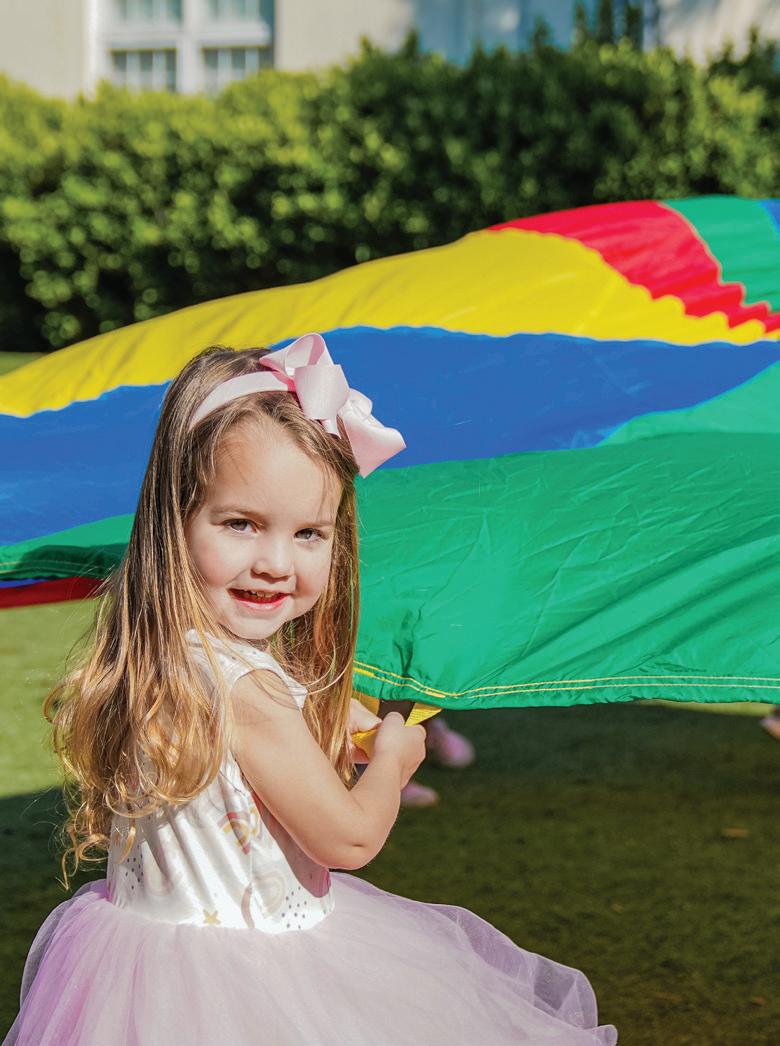

• STORAGE UNIT
• PLANTS WITH VARIOUS TEXTURES AND COLORS
• ADD HOSE BIB
J L M
RETAIN OPEN LAWN FOR PROGRAMMING
K
• REMOVE PORTION OF TURF
• ANCHORED NATURAL LOG PERIMETER
• STORAGE UNIT (OPTIONAL)
• ADD LOCAL PAVERS/BLUESTONE (OPTIONAL)
• GIANT TREE COOKIES/LARGE LOOSE PARTS (picture 10)
• ADJUST LOCATION PER GUIDELINES
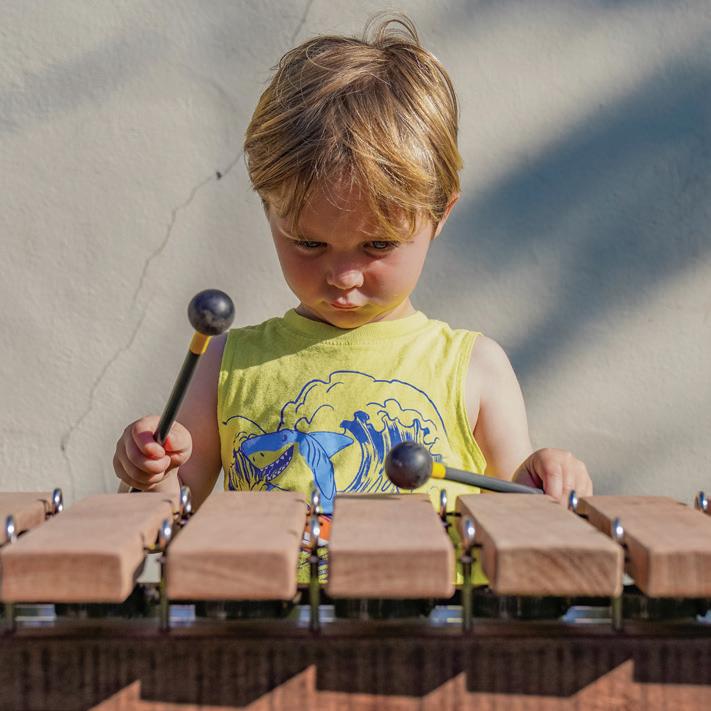
• ADD LOOP TO EXISTING PATH (picture 11)

There are 34 second graders lined up in the sun outside of the Lower School STEAM Lab. Inside, science teacher Meghan Ward hurries to finish dividing lab materials into a dozen different bins. Suddenly the door pops open.
“Can we come in yet?!” They’re early, but you can’t blame them. Once they walk through that door, they are no longer students. For an hour, they become inquisitive scientists.
Once a week since August, students in grades 1-4 have assembled in Ashley Hall’s brand-new 2,100-square foot STEAM Lab to complete a hands-on science lesson. By March, it’s safe to say everyone knows the drill. “I give them a challenge, minimal materials, just a little bit of time, and they have to problem solve,” Ward says. “Just watch,” she adds with a smile as she waves them in. “They are always ready to go.”

THE CHALLENGE: “Catch” a gas and show your teachers.
Each spring, second graders study states of matter. After a quick review of the properties of a solid, a liquid, and a gas, scientists were given their STEAM challenge: figure out how to make an invisible gas visible.

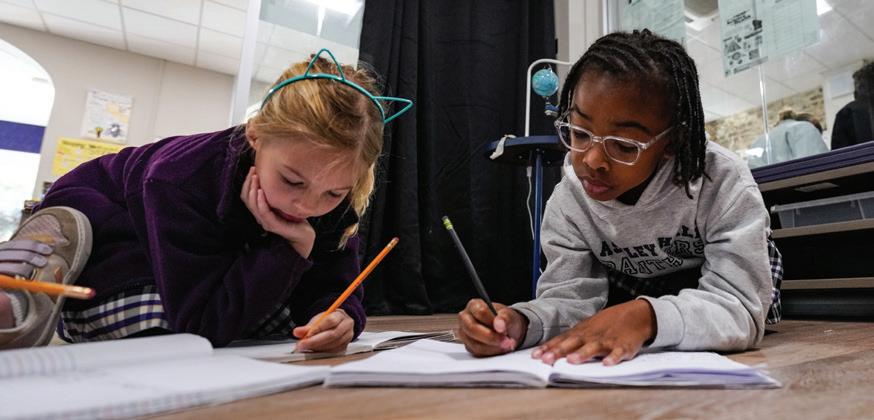
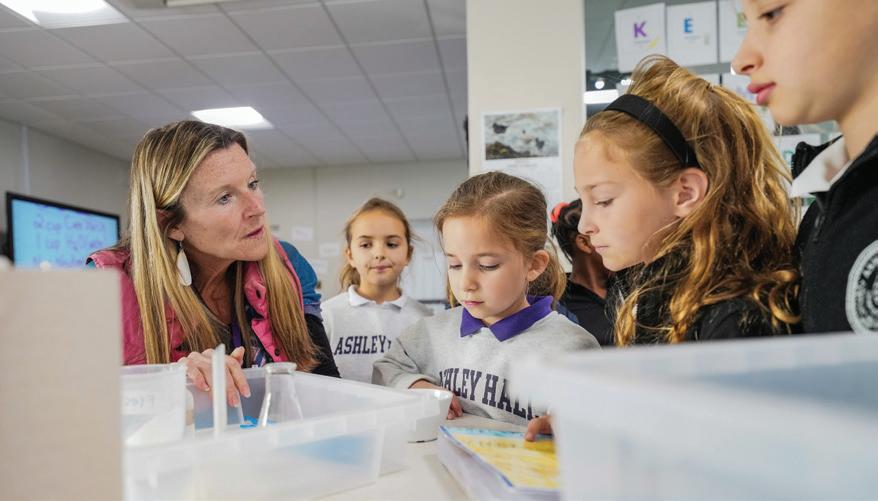

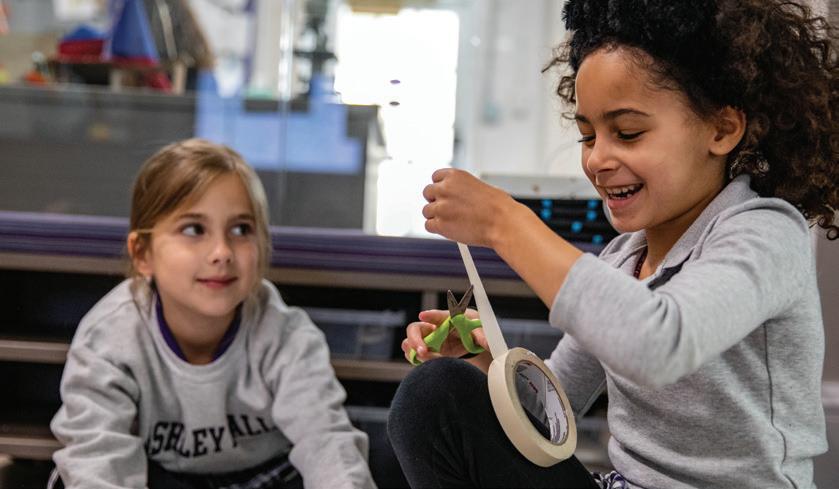
Using baking soda, vinegar, and some pretty fancy scientific materials, scientists split up into 12 teams to design a stepby-step plan of how they could mix a solid with a liquid to fill a balloon with a gas. Once their plan was approved by an adult, they received a bin with their materials and began to experiment.
The winning formula? Place baking soda in an Erlenmeyer flask, add a few drops of vinegar, then quickly place a balloon on top to watch it fill up with gas.
THE CHALLENGE: Create a trap that will attract a leprechaun, so he can lead you to his pot of gold!
First grade scientists got some exciting news the week before St. Patrick’s Day: trails of glitter left by sneaky leprechauns had been spotted around campus. To catch them, they were challenged to build a leprechaun trap.

Each armed with their own clipboard, scientists split up in groups of three or four to brainstorm. “We always have them begin the process by sketching their own idea, then they collaborate as a group and come up with one design,” Ward says.
With a single plan in place, each team got to work building with the materials available to them. “We’re going to glue together cardboard to make a box and lure him in with glitter,” explained Olivia Belgraier ’34. “Then put it at the Bear Cave to catch him!”
THE CHALLENGE: Make a model of the Charleston Peninsula to investigate the effects of pollution on our waterways.

“Has anyone ever heard the word ecology?” Ward asks her fourth grade scientists. Every hand goes up. “Well today, you are going to be ecologists, scientists who study the relationship between living things and their habitat.”
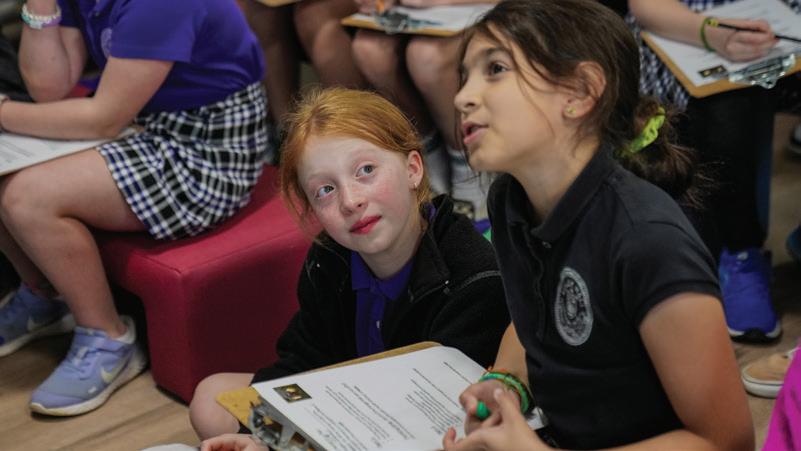

The group begins by thinking about how they all affect their own environment: the peninsula of Charleston. Then they split into teams and received a clear tray with a white tray nested at an angle inside. Using Play-Doh, they built a “plot of land” then covered it with “pollution” humans leave behind, including sprinkles for dog droppings and coffee grounds for topsoil. Then our ecologists made it rain – literally.
Each team poured water on their land and tilted their tray to see the pollution run off. Then they did it again, but this time, they added sponges to represent salt marshes. The result? Proof of just how important grasses and pluff mud are when it comes to protecting our waterways since they trap pollution.
THE CHALLENGE: Grow your own plant that produces oxygen and glucose.
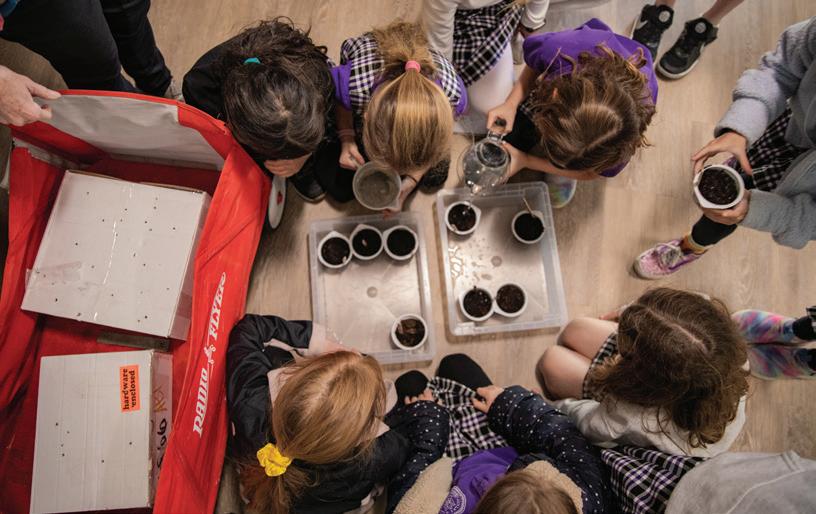
Scientists in third grade always start STEAM with an open notebook in their lap. “Photo means light,” Ward explains as her scientists put their pencils to paper to draw a diagram of a plant to illustrate the process of photosynthesis. “And synthesis means make. Make what?”
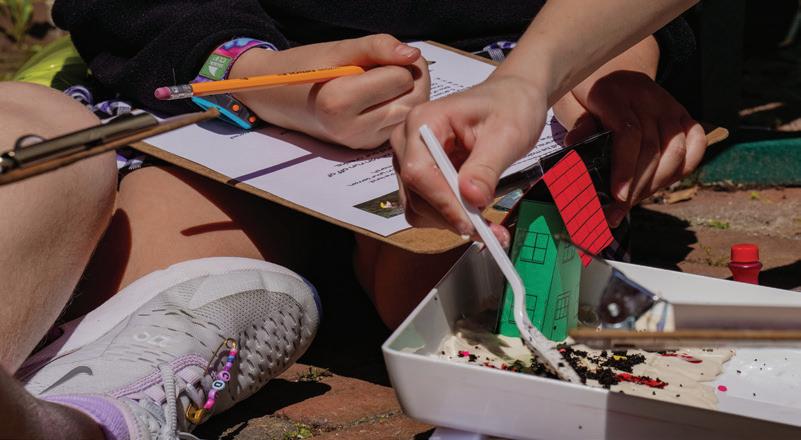
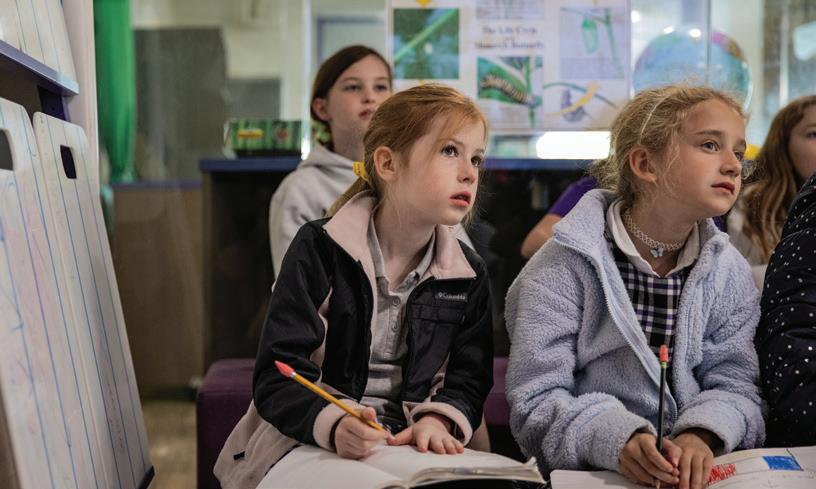
Next, they draw an arrow coming off their stems to show what plants make – glucose and oxygen – and arrows pointing toward their leaves to show what they need – energy, carbon dioxide, and water. “Now get ready for an advanced chemistry equation.”
Scientists copy down 6CO2 + 6H2O → C6H12O6 + 6O2 from the electronic chalkboard, then they close their notebooks to begin a long-term experiment that will turn their drawings into real-life plants. Each scientist received scarlet hibiscus seeds to sow in their own container, so they could watch it grow in the coming months.


My biggest goal is to just enrich the love of learning that’s already instilled in them. They love science. They bring us all kinds of things they find, and they wonder about nature. I want to encourage them to always see the wonder and be curious.
– MEGHAN WARD,LOWER
SCHOOL STEAMAND SCIENCE
TEACHERLEARN MORE ABOUT STEAM EDUCATION IN THE LOWER SCHOOL
To educate students about the importance of conserving shorebirds through habitat preservation, biologist and Ashley Hall alumna Katie Morrision ’13 recruited faculty and alumnae from her very own alma mater.
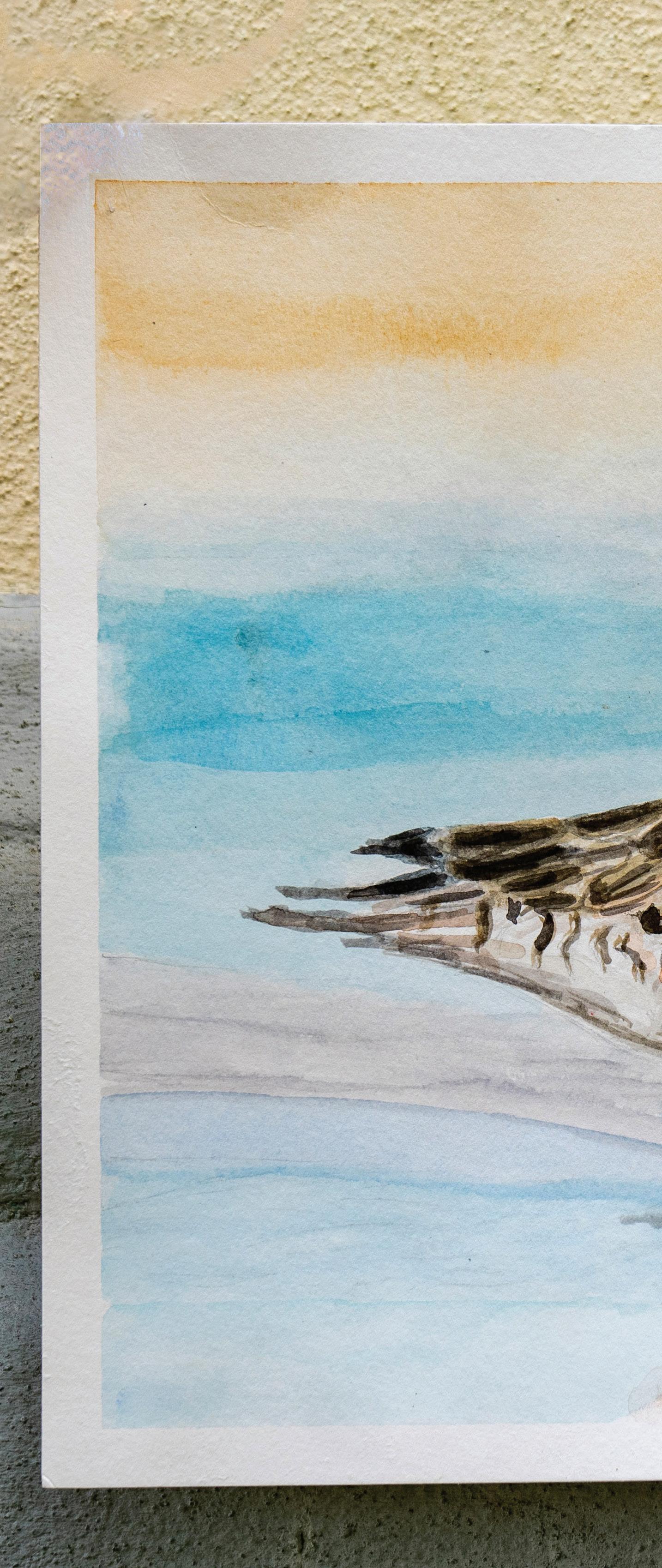
It all started with a bird.
When Katie Morrision ’13 began her master’s of biology research on shorebirds at Miami University, she was instantly fascinated by the small, but mighty, red knot.
“They have one of the most unique migrations out of any bird that comes to South Carolina because they are flying 18,000 miles a year,” says Morrison, who is the Director of Education at Coastal Expeditions, a Charleston-based outdoor adventure company that offers guided tours throughout the Lowcountry. In 365 days, the red knot can travel from the tip of South America all the way to the Arctic and back, making it one of the longest-distance migrant birds in the world. But the species is disappearing.
After graduating with a degree in environmental studies from Sewanee: The University of the South, Morrison spent time as a research assistant in Hawaii working with humpback whales and dolphins. She returned to Charleston in 2019 to work at the South Carolina Aquarium prior to moving into her current role at Coastal Expeditions where she oversees all their educational programs.
For her master’s degree, Morrison specifically studied shorebird education and the positive impact education has on protecting coastal birds. “Red knot populations are declining and need further protection,” Morrison says. “With their incredible story, it makes for a great bird to teach our community about how to protect shorebirds.”

Our primary goal was to have a global conversation about conservation. What better medium than art? It’s a universal language – a visual language that everybody can read and relate to.
— ALLISON BOWDEN, UPPER SCHOOL BIOLOGY TEACHER
In the summer of 2022, Morrison set out to do just that. She recruited students, faculty, and alumnae from Ashley Hall to be part of a collaborative shorebirds study entitled Migrating Together. The project aimed to connect Upper School students in Charleston with ninth graders in San Antonio Oeste, Argentina through studying the red knot – who just so happens to stop in both coastal towns along their long migration. “Studying shorebirds is a great way for students from different parts of the world to communicate with one another without having language be a barrier,” Morrison says.
Inspired by her mission, Ashley Hall visual arts teacher Raul Miyar and Upper School biology teacher Allison Bowden brought their two departments together for a single purpose for the first time in the School’s history. “Our primary goal was to have a global conversation about conservation,” Bowden says. “What better medium than art? It’s a universal language – a visual language that everybody can read and relate to.”
Together with Morrison and educators in Argentina, Miyar and Bowden created a cross-curricular project for ninth grade Biology and Foundations of Art students to allow them to study shorebirds through science and wildlife art, both in the classroom and on the water.

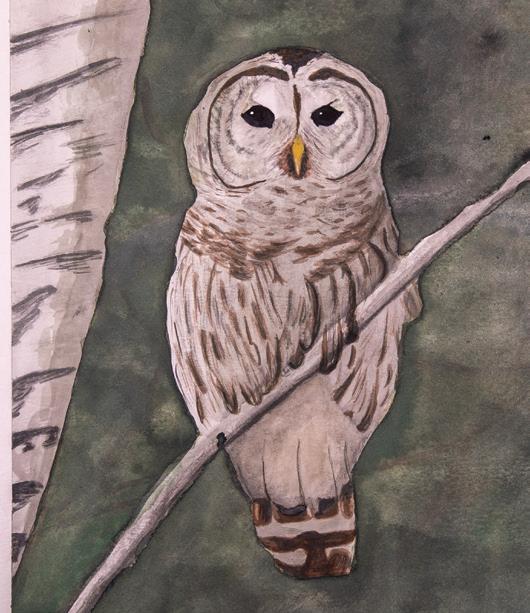
To kick off the Migrating Together project, Morrison and a biologist with Audubon South Carolina led a discussion with Bowden’s ninth grade biology students on coastal bird migration routes, feeding behavior, and the red knot’s unique life cycle and their tremendous
Wildlife photographer Cacky Rivers ’90 discovered her passion for birding later in life. “I have always been comfortable with a camera, and I have always known about birds,” Rivers says. “But it wasn’t until my father got sick that the two came together. He was an avid birder and even gave me a bird guide and a pair of binoculars for my college graduation. Little did I know this would become a huge part of my life near the end of his.”
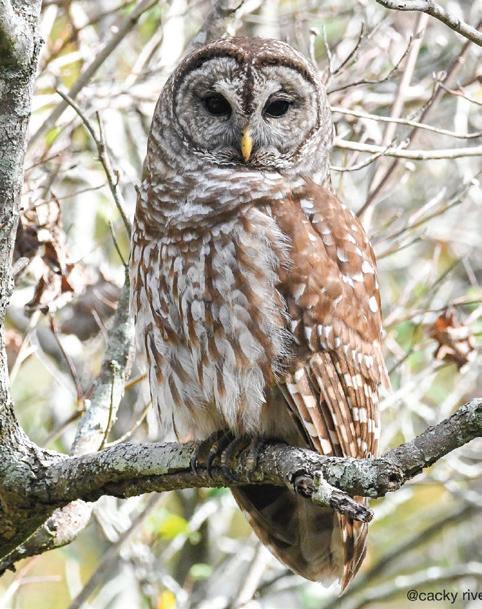
migration. “Katie put a lot of emphasis on the nesting habitat of Crab Bank here in Charleston, which pretty much disappeared due to the natural changing of the currents, storms like Hurricane Irma, and dredging in the harbor,” Bowden says. “Coastal Expeditions fought for Crab Bank to be restored, and now they have more species than ever nesting there.”
To introduce the project’s art component, students in Argentina met Fabian Pinasco, a local shorebird photographer and conservationist, and Ashley Hall students met alumna and bird photographer Cacky Rivers ’90. “I have been on several Coastal Expedition tours with Katie,” Rivers says. “She approached me on one of the whimbrel tours and asked if I would like to be a part of her Migrating Together project using my photography for the girls to draw from. I was thrilled because I believe in educating students on what’s going on in the bird world.”
“It was so cool to have these different generations of alums involved,” Bowden says. “Cacky spent an entire day with my classes sharing her photography. Her connection to the ornithological world is just tremendous.”
Through her photography, Rivers introduced students to a broad range of local shorebirds that would later inspire their own bird artwork. “Before seeing her photography, students really thought all the birds they saw on the water were the same,” Bowden says. “They just called them all herons or egrets. But the diversity of species they learned through Cacky’s photography enabled them to be able to name them when we got in the field.”
In Argentina, educators chose Bahia de San Antonio, a protected shorebird beach in the northern part of Patagonia, Argentina,
for their field study on shorebirds. Here in Charleston, Morrison chose the island of Crab Bank, which is home to thousands of migratory species. “Crab Bank is one of the areas where a lot of our shorebirds are going to come and stop and rest because there’s no development and it’s closed off from many people stopping on the island,” Morrison explains. Located at the mouth of Shem Creek in the Charleston Harbor, Crab Bank stretches 30 acres from end to end, and its preservation is crucial to the survival of coastal bird species. It is only accessible by boat, but luckily, Ashley Hall students have a connection.
On the first day of September, biology students boarded a Coastal Expeditions boat for a field trip, led by Morrison, to Crab Bank to work on their bird identification skills. They used binoculars to see the shorebirds more closely, then made a list of all birds they saw, using Morrison as a reference. “They also looked at them not just as individuals, but as groups of birds and their specific adaptations for that habitat they live in, which was fascinating to them,” Bowden explains. “Katie introduced the differences between shorebirds, pelagic birds, and wading birds in class, then they applied it once we headed out into the field.”
While it was the first time touring the waterways with an educational guide for most, there was one student who knew the drill: Annie Morrison ’26, Morrison’s younger sister. Last summer, Annie worked with her sister at Coastal Expeditions helping out on educational trips for kids. “I loved that the first year [of the Migrating Together project] could include my younger sister,” says Morrison, who plans to continue it with Ashley Hall next year. “She is always helpful in letting me know what students might prefer to learn more about.” And learn they did. “These birds are things they’ve seen their whole life,” Bowden says of her students. “But all of a sudden, when Katie was talking about them on the boat, it was like, ‘Oh, these are
Rivers began photographing birds for her father to keep his mind off of his illness. But what began as a hobby has now turned into much more. In November 2021, Rivers published Grounded in Flight, a photography book featuring more than three dozen bird species native to the Lowcountry. Perhaps the most breathtaking of her photographs are of birds soaring through the air, wings fully on display. “Photographing birds in flight is one of the biggest challenges I have faced,” Rivers says. “And I love a challenge!”
As a part of the Migrating Together project, Rivers shared her photography with students to introduce them to a broad range of local shorebirds. “Shorebirds are fascinating to watch as they all have different behaviors – how they feed, fly, and interact with each other,” Rivers says. Students then referenced photographs from her stunning collection of work, like the photo of the barred owl to the left, to create their own works of art. “Seeing my photos come to life with their art absolutely blew me away,” Rivers says.
keystone species. These are species that others rely on.’ I think it was a lightbulb moment for them.”

Back at school, students in both Charleston and Argentina then selected a bird they spotted from their field study that they would bring to life with paints and watercolors. Miyar connected with Carolina Perazzoli, the art teacher Morrison partnered with in Argentina, and they stayed in close contact with the goal of sharing each other’s work in the end.
“We ended up with a large variety of artwork because they chose birds based on their own preference,” Miyar says, who led the project for two classes of ninth graders. “They may have been drawn to that bird because of how it looks – its plumage, its shape – or its importance. It just had to appeal to them and be one they had studied.” Next, students chose a photograph to paint from. “A few students chose Cacky’s photography which was presented to them initially,” Miyar says. “Others researched online and worked from an image they were drawn to.”
With their birds selected, the students got to work on an intricate watercolor shorebird rendering. “I liked both the art and science parts of the project, but I think I like the art a little bit more,” Annie Morrison says.. “I really liked getting to see the red knot from a more detailed perspective.”
Students spent two months perfecting their life-like paintings, and once completed, they turned them into postcards to send to their partners in Argentina along with hand-written messages. Perazzoli’s students did the same. “By sharing both their art projects and field observations, all students gained a greater understanding on the importance of shorebird conservation,” Bowden says. “This global conversation reminds us how communication can help spread awareness and why it is important to protect these species.”
And it all started with a bird.
SHOP THE ARTWORK Every bird painted by students as a part of the Migrating Together project can be spotted in the Charleston Harbor. “This artwork is a tremendous honor to these organisms, and the pride the students have in this work made us want to let them have a bigger impact,” Bowden says. Inspired by spreading the word about our local shorebirds, Ashley Hall turned a select number of their watercolor renderings into stationery for the community to purchase. Scan here to shop.


The mission of the United Nations is to maintain international peace and security. Here’s how Ashley Hall educators use the work they do to cultivate globally minded citizens.
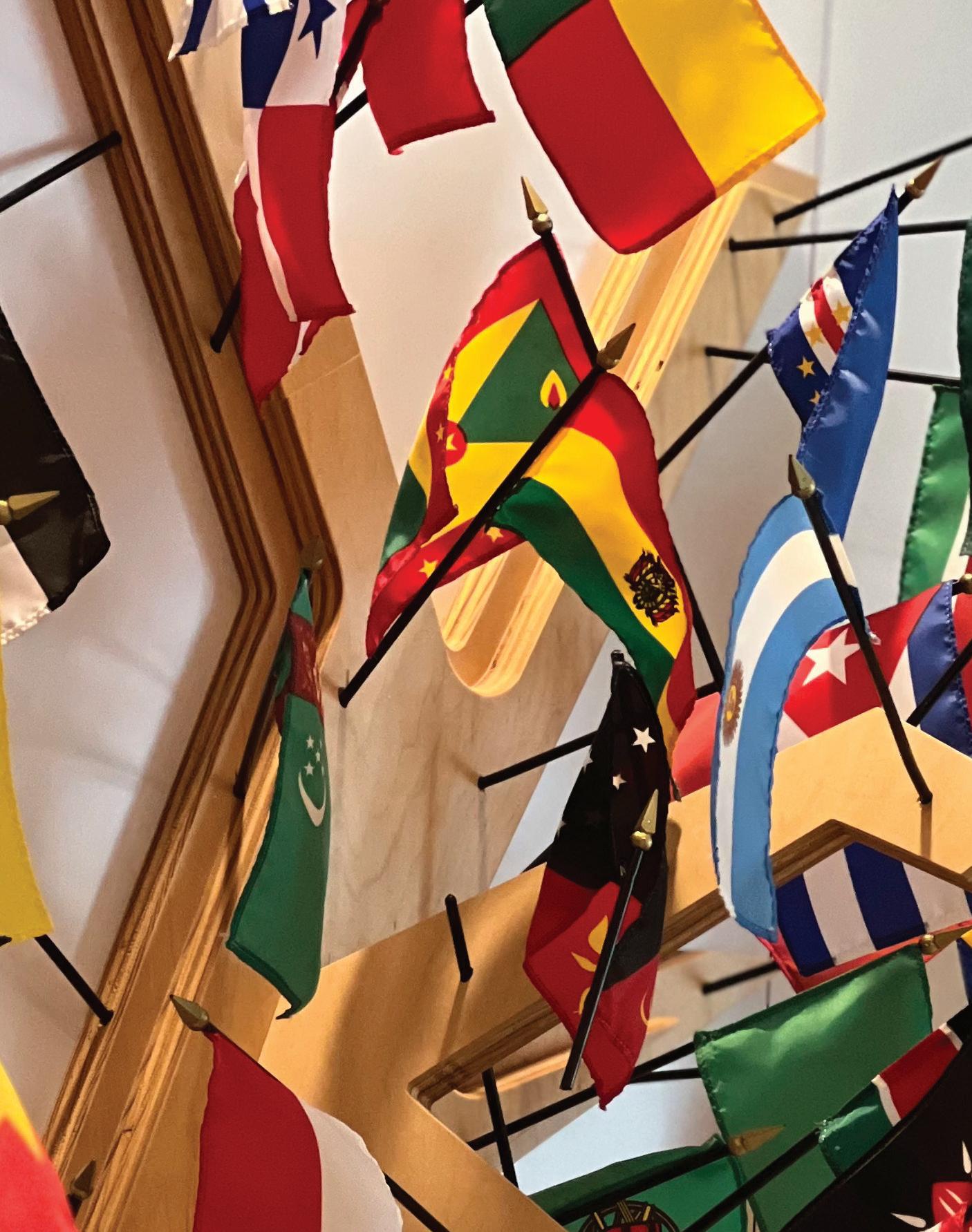

In 2015, government representatives met at the United Nations Headquarters in New York to adopt a global set of Sustainable Development Goals (SDGs). From ending poverty to protecting our oceans, their list of seventeen goals serves as a blueprint for a better world. It’s also the framework for Ashley Hall’s global awareness program which aims to support each student’s growing awareness of their role as a citizen of the world.
Each year, Ashley Hall makes a school-wide commitment to embrace a single SDG. This year, the Class of 2023 voted to focus the School’s global education theme on Goal 5: Achieve gender equality. Through classroom instruction, hands-on activities, and visiting speakers, students deepened their understanding of the intent of this goal, which is to empower all girls and women, while reinforcing the crucial role boys and men play in achieving these goals.
“One of the special strengths of Ashley Hall is that we can introduce programming that creates connections across all the grade levels,” says Global Education Coordinator Jonathan Perkins, who works with faculty to support curricular and extracurricular SDG-centered programming. “One area in which the global education program has grown this year is in its breadth of programming we were able to offer.”
In the Lower School, students took part in Women Who Persisted, a weekly assembly series in which teachers introduced women who have made a significant impact on society despite tremendous challenges. Sixth grade students did their own research on women who have made a difference throughout history and created posters highlighting their achievements, which are now hanging in Davies Auditorium. “To bring everything together, our end-of-year school-wide Girls with the Will celebration included a trivia contest about all these women,” Perkins says. “You could tell that the girls really internalized what they had learned.”
One of the special strengths of Ashley Hall is that we can introduce programming that creates connections across all the grade levels.
— JONATHAN PERKINS, GLOBAL EDUCATION COORDINATOR
Throughout the year, Upper School students attended multiple special assemblies featuring accomplished Ashley Hall alumnae from an array of different disciplines who led conversations about gender equality. During these panel discussions, they each shared details with students about their career trajectories, the challenges they’ve faced, and how they persevered to succeed. Panelists included:
• Masheed Rockwell ’02 | Owner & CFO, Rockwell Construction
• Jane Prevost ’06 | Financial Advisor, Synovus Bank

• Najeema Washington ’96 | Former Associate Director, Alumni Engagement & Career Services, College of Charleston
• Anna Outen ’13 | Assistant Solicitor, Ninth Judicial Circuit Court
• Chelsea Handegan ’07 | Owner, Chelsea Handegan Interior Design
• Ashley Holt Cohen ’08 | Emmy-nominated TV Producer
“It has been great to see the involvement from our youngest students to our soon-to-graduate seniors, and even alumnae,” says Perkins, who also helps coordinate travel programs that reinforce the power of having a global perspective, including Ashley Hall’s newest signature program to the U.N. Headquarters in New York.

As selected by the Class of 2024, next year’s Ashley Hall global education theme will be focused on Goal 2: Creating a world free of hunger by 2030. “Next year, we’d like to do even more on the community engagement front, especially with the greater Charleston community,” Perkins says. “With our focus next year on ending hunger, this will be a tremendous opportunity to expand upon our philanthropic efforts.”
| Opposite: Owner & CFO of Rockwell Construction
An important part of the vision of the U.N. Sustainable Development Goals is to create a world of universal respect for human rights and human dignity. In 1948, the Universal Declaration of Human Rights (UDHR) established 30 fundamental human rights for people in all nations that should be universally protected. Today, the Declaration holds the Guinness World Record as the most translated document, and it can be read in over 500 languages. Still, many Americans are unaware of their inherent rights as human beings.
On the 75th anniversary of the creation of the UDHR, Upper School humanities teacher Andrea Muti and Visual Arts Department Chair Nancy Langston collaborated to launch Ashley Hall’s newest signature travel program aimed to educate students on the enduring importance of protecting our human rights. In March, 15 students in grades 10-12 embarked on a four-day trip entitled Building Bridges, Not Walls to New York City, America’s quintessential melting pot and host of the United Nations Headquarters.
“Through this cross-curricular experience, students gain insight into the roles that the United Nations and artists play in supporting and fostering human rights and the human experience,” Muti explains. “In essence, they unite, empower,
and build bridges amongst individuals, communities, and nations.”
While in New York City, students visited the National September 11 Memorial & Museum, Ellis Island, the Rubin Museum of Art, the Metropolitan Museum of Art, and the United Nations Headquarters. They also visited the U.S. Mission for the United Nations where the group heard from U.N. staff members about how the UDHR is just as integral today as it was 75 years ago to the mission of the United Nations, which is to maintain international peace and security.
After witnessing themes of immigration, international relations, and terrorism, as well as how art can educate and be a catalyst for change and unity, students returned home and revisited the articles of the UDHR. Here, they reflect with a new point of view on how the protection of different human rights empowers us all.

ALL HUMAN BEINGS ARE BORN FREE AND EQUAL IN DIGNITY AND RIGHTS.
“In order to create an inclusive society, you need to have a voice from everyone. No culture, race, or ethnicity should be treated lower than another. While I was in New York, I noticed how diverse the people were. Walking around, there were so many different types of people expressing their cultures and beliefs. This is important because it shows how all together, so many people can create a peaceful society while still getting the same rights and freedom.” –
“I feel this is a motto that New York City lives by, and it is a huge part of what makes it so special. When we visited Ellis Island, it was extremely interesting to read the personal stories and individual hardships immigrants had to face in order to make it to a new country alive. The conditions of the ships they arrived in were awful, and many would die before making it ashore. However, when they arrived in New York City, they were granted rights which might have been unfamiliar to them: they were in control of their own lives.” – Faye
Bailey ’25“Whether it’s torture or dehumanizing actions of any kind, this one article is barely a sentence long, but it holds strong enough power to prevent any kind of inhuman actions to anyone. It gives me hope that the world will someday have peace because this article protects many lives. When reading it, I immediately think of the 9/11 Memorial & Museum, since the event was a sign of terrorism. However, I recently learned that after 9/11, the United States arrested and dehumanized many Afghans who they suspected to be Taliban simply because of how they looked. I wondered if this article could connect with not only terrorism, but that type of biased mistreatment. I’m a humanitarian, and I don’t like seeing any person in trouble. So for there to be a rule against torture and dehumanization proves to me that peace could be made in this world.” –
Kiki Trevino ’25“Because of the creation of Article 26, everyone regardless of their background, gender, race, and beliefs have a right to an education. Because of my access to an education, I was able to visit New York and learn about so many topics. When speaking with United Nations staff, we discussed the war in Ukraine and the importance of being informed and educated on current events happening around the world. Regardless if we are directly affected, it is our duty and responsibility to spread awareness, be well informed, and know how we can help. I think visiting the U.N. gave everyone a new perspective on how they handle difficult international situations and the difficult process of having to consider all perspectives of the people involved.” – Lavina Maybank ’24
NO ONE SHALL BE SUBJECTED TO TORTURE OR TO CRUEL, INHUMAN OR DEGRADING TREATMENT OR PUNISHMENT.
EVERYONE HAS THE RIGHT TO LIFE, LIBERTY, AND SECURITY OF PERSON.
EVERYONE HAS THE RIGHT TO EDUCATION.
For Mary Schweers, Ashley Hall is not a place where students just go to school. Nor has it simply been a place she has worked for the last 28 years. It’s a community in which she has grown both personally and professionally as an administrator, teacher, as well as a mother. When she retires at the end of the school year, she will leave behind not only a legacy of academic achievements and innovative studentdriven programming, but one of kindness.
Mary Schweers remembers her first day at Ashley Hall like it was yesterday. In 1995, she was hired to teach English and classics to seventh and eighth graders, and her classroom was on the second floor of Lane Hall, which is now the Student Life Center. Twenty-eight years later, that room is still her favorite place on campus.
“So much magic happened there,” Schweers recalls from her cozy second-floor office where she now serves as Director of the Intermediate Program and Nautilus Program. “It was the first room they put me in, and I stayed there for 13 years. We had so much fun doing Romeo and Juliet and Great Expectations, and I was so happy every day I went in there and saw those girls. I can still remember where they sat – it’s a perfect picture in my mind.”
But as much as Schweers loved the view inside her first classroom, the view from the windows was just as special. “My
daughter Morgan was a baby when I first started,” she says. “And from that room, I could look out of the window and I could see her coming in and out of the nursery which was there at the time. It made me so happy.”
From day one, Schweers’ passion for her students, colleagues, and her family were destined to be intertwined by Ashley Hall. Her daughter Gloria Morgan Widenhouse ’13 would go on to spend 18 years at the School, and the number of students and faculty members Schweers would impact only grew exponentially.

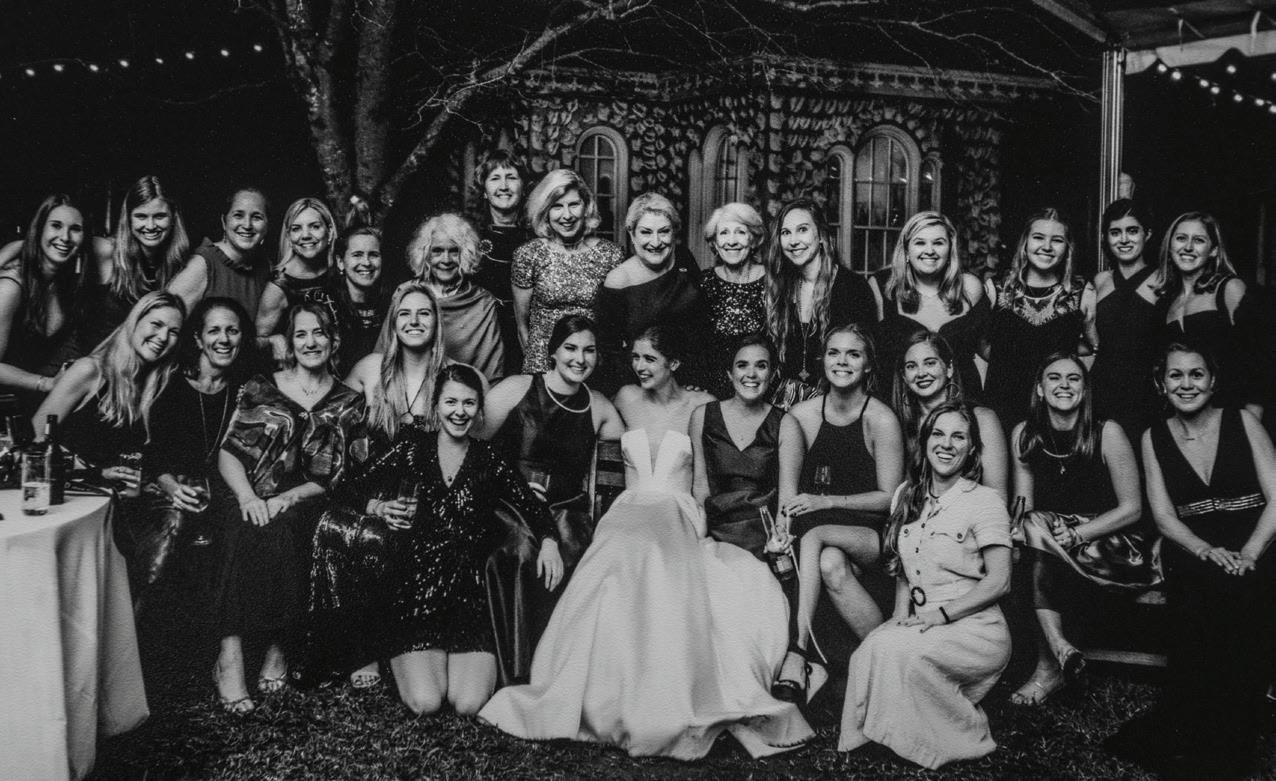
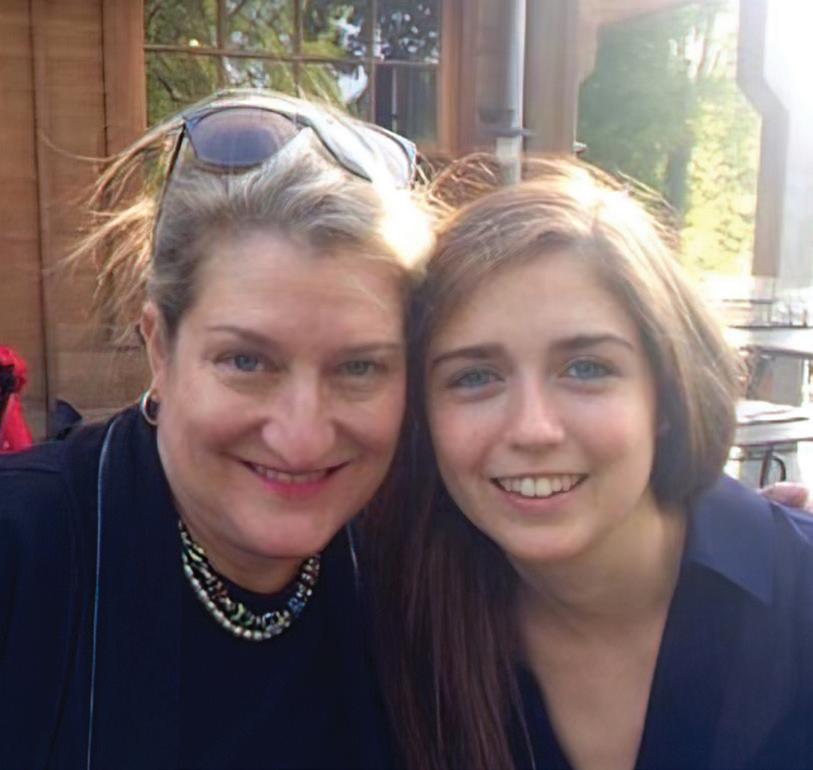
After teaching the middle grades for 13 years, Schweers became the head of the English department in 2007 and served as Assistant to the Head of School overseeing the School’s accreditation process. That next summer, she became the Director of Upper School.
“Mary and I have always shared a love for Ashley Hall and its students,” says Kelly Sumner who joined Ashley Hall in 2001. “Her daughter, Morgan, was in my kindergarten wellness class that first year, and I continued to be the counselor for the Class of 2013 all the way through to their graduation. As those girls were growing up, Mary and I were also growing in our leadership roles and eventually came back together as Upper School Director and Dean of Students.”
Together in the Upper School, Sumner and Schweers realized a need to better support their seventh and eighth grade students. They enlisted the help of Upper School English teacher Chris Hughes to develop Ashley Hall’s signature Nautilus Program, a department within the Upper School focused on creating a community for students in grades 7-8 during this crucial period of development.
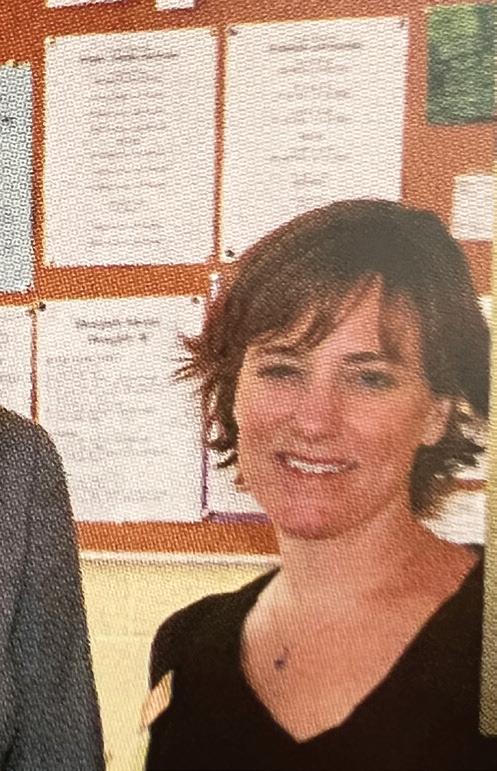
“As Upper School Director, Mary provided guidance, love, and support in all that I did,” Hughes says. “She also mentored me as I transitioned into the lead coordinator position for the Nautilus Program, and I worked under her tutelage. Additionally, and more importantly, we are friends. Her kindness, compassion, and understanding are unparalleled.”
While restructuring her department from a high level to better serve her students, Schweers continued advancing academics and signature programs at Ashley Hall steadily forward. In the classroom, she oversaw the introduction of the student-led Harkness method of teaching in the Upper School. “I think that method is incredible,” she says. “I’ve watched it teach girls how to communicate, how to think, how to analyze primary sources, and be prepared for discussions.”
Outside of the classroom, Schweers helped develop the Offshore Leadership Program with Upper School faculty member Roscoe Davis, Ph.D., sailing aboard the tall ship Westward from Charleston to Miami in January 2007. “This was a training voyage of sorts for people who would be affiliated with the soonto-be launched tall ship, the Spirit of South Carolina,” Davis says. “On account of her experience aboard the Westward,
Mary would serve on the committee of the newly established Offshore Leadership Program from 2007 to today.”
Her presence both on campus and off did not go unnoticed by her Upper School students. “Mrs. Schweers was a constant positive force during my years at Ashley Hall,” says Caroline Outten ’16. “She set a tone of joy that spilled over into all our classrooms and extracurriculars, and she showed up for her student body in a way that made us all feel supported and valued each day. No matter if it was during track meets, college applications, or course signups, Mrs. Schweers was always in our corner. She consistently provided a listening ear, guiding light, and encouraging voice for her students.”
Mrs. Schweers gave us the ability to go into the world with confidence and a voice. She went above and beyond her job title and made it a point to connect with each and every one of us which has had a lasting impression on her students.
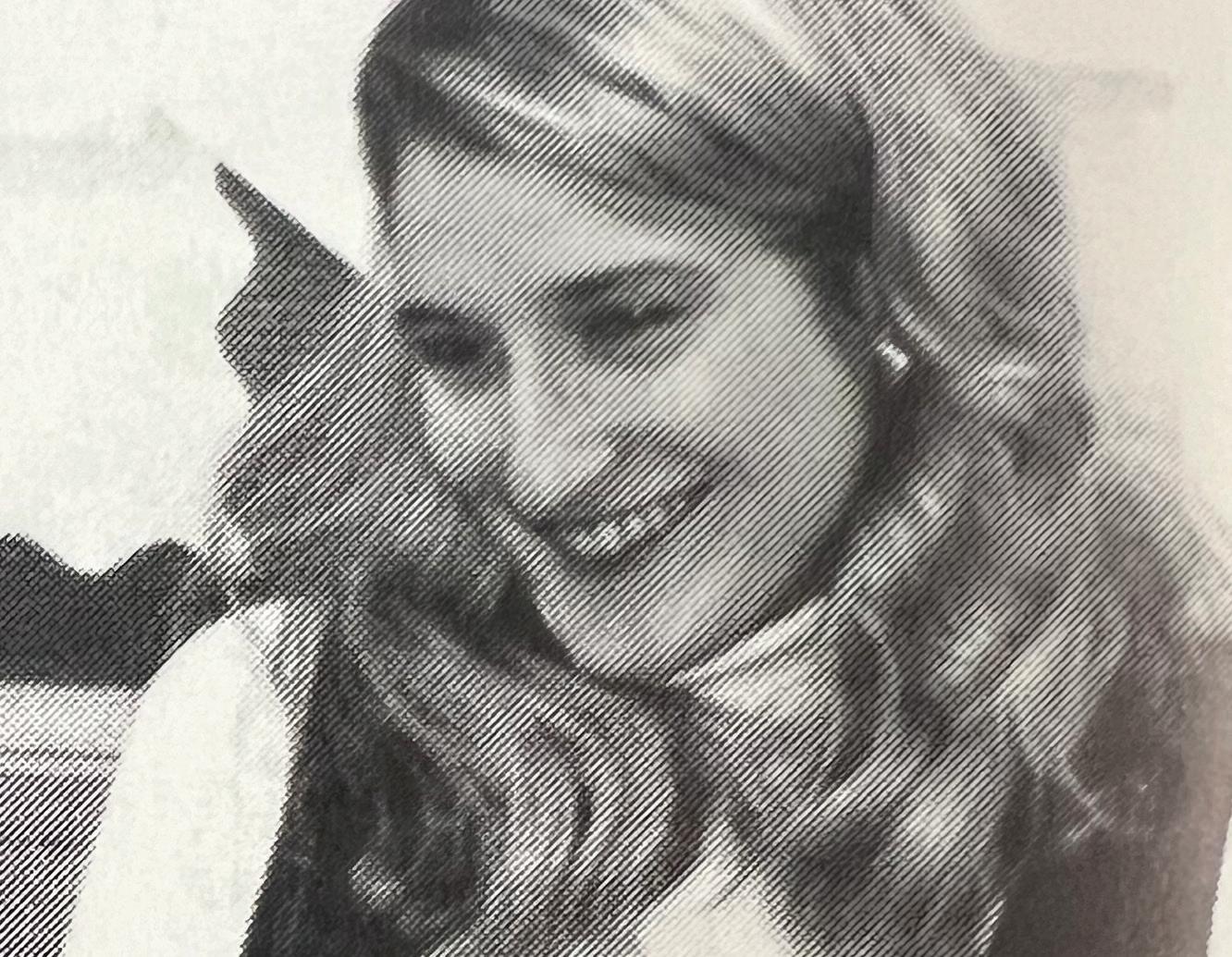 – CAROLINE OUTTEN ’16
– CAROLINE OUTTEN ’16
In the fall of 2018, Schweers returned to her middle-grade roots when she became the Director of the Intermediate and Nautilus Programs to oversee programming for grades 5-8.
“The changes that come with the fifth through eighth grade years are so exciting, and they are so important, especially for girls,” Schweers says. “There is a thread that runs through all the transitions they face, and it’s so fulfilling to watch the girls go through these critical years then into high school. Our programs
Ashley Hall becomes a part of your life. We learn, we work really hard, but we have a lot of fun doing it. We are all lifelong learners, so you never just give that up. Ashley Hall is always who you are.
–
are structured to meet their needs and where they are to help them grow so that they’re prepared.”
While her administrative roles shifted throughout her remarkable tenure, one thing has remained the same: how she has led both her students and faculty. “All in all, I have worked with Mary in some form or fashion for each of the twenty years I have been at Ashley Hall,” Davis says. “I think her greatest gift to every division she has led has been the strength and stability she brought both to the students and to the faculty during a period of many changes.”
“Her leadership always begins with thinking what is best for the students and what is best for Ashley Hall, no matter the situation,” adds Director of the Lower School Polly Kronsberg. “She is a principled leader who has led with compassion and kindness, and her mentorship has been invaluable to me. She is an inspirational role model for our girls and her colleagues.”
On July 1, 2023, Assistant Director for the Nautilus Program and an Upper School faculty member Alison Parks will step in to serve as Interim Division Director for grades 5-8. Schweers and Parks have worked closely over the course of the last three years as administrators.
“Mary always says, ‘Ashley Hall is not just a school you attend, but it becomes a touchstone for your life,’” Parks says. “That is how I feel Mary is for those who have worked with her. She listens, she mentors, and she supports. Working with Mary means that you are seen, heard, and respected, which establishes the tone for our community. She has become a touchstone to this campus. Even though she will not be physically present next year, her presence will remain.”
Since hiring her a decade ago as a classics teacher, Schweers has watched Parks grow from teacher to administrator. “She has everything it takes,” Schweers says. “The work ethic, emotional intelligence, and she is kind to the students, faculty, and parents. I feel so good about the Nautilus and Intermediate programs being in Alison’s hands. That’s why I can walk away.”
But their connection goes beyond school, as so many of Schweers’ relationships do. In a wonderful twist of Schweers’ Ashley Hall fate, Parks gave birth to her son on April 18, 2022 – the same day Mary’s daughter Morgan was born 27 years earlier. What’s more, Morgan, who is now a nurse at the Medical University of South Carolina, was in the delivery room to welcome Luca Parks into the world.
“One of the things that makes me the happiest is that Alison is going to have this office,” Schweers says, looking out of her second floor window in the Intermediate Program building at Early School students playing down below. “She’s going to be able to look out and see Luca when he’s here. She can watch him just like I looked out of my window from my first classroom and was able to see Morgan. There’s a little parallel there. I think it was meant to be.”
Committed. Mary has given her all to the life of our School. She has supported faculty members – often in ways they didn’t even know – and cared for students demonstrating a wonderful balance between setting expectations and demonstrating genuine care and love for students.
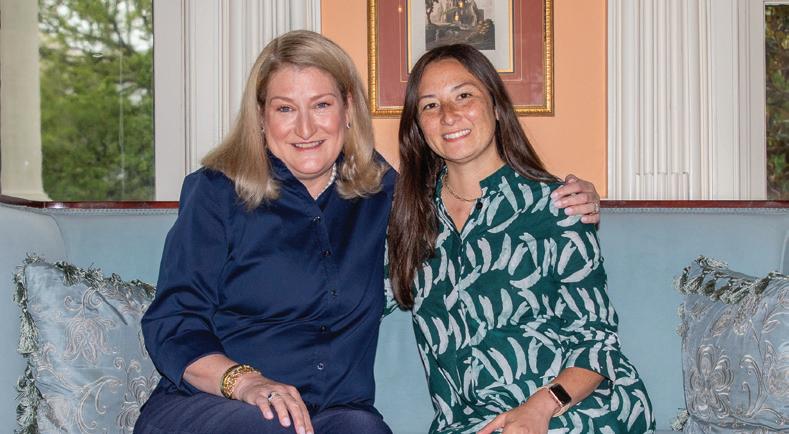 – AMANDA MURRELL, UPPER SCHOOL DIRECTOR AND DIRECTOR OF COLLEGE COUNSELING
– AMANDA MURRELL, UPPER SCHOOL DIRECTOR AND DIRECTOR OF COLLEGE COUNSELING
Classy. Mary has the gift of making everyone feel valued and heard. She listens before she speaks, and she is always fair and respectful in her responses. Even in tough and uncomfortable situations, she maintains her composure, never loses her cool, and she can always find a silver lining. She is poised and composed at all times – not to mention always dressed to perfection with the focus of her outfit always being her shoes!
– FRANNY SLAY ‘80, DIRECTOR OF ATHLETICSCompassionate. Mary cares deeply about Ashley Hall in every way – her students, her colleagues, and the School itself. This is evident everyday in everything she does. She lives the mission and expects the work that we do on campus to be driven by the purpose of preparing our students to embody her motto: ‘We prepare the child for the path, not the path for the child.’
– ALISON PARKS, ASSISTANT DIRECTOR FOR THE NAUTILUS PROGRAM AND UPPER SCHOOL FACULTY MEMBERHere, her colleagues reflect on the traits that come to mind when thinking of Mary Schweers.
Just weeks after the October 2022 release of her first book, Sweet Land of Liberty: A History of America in 11 Pies, award-winning food writer Rossi Anastopoulo ’13 returned to her alma mater to celebrate as not only a proud alumna, but a featured author in the Ashley Hall Writers Series.
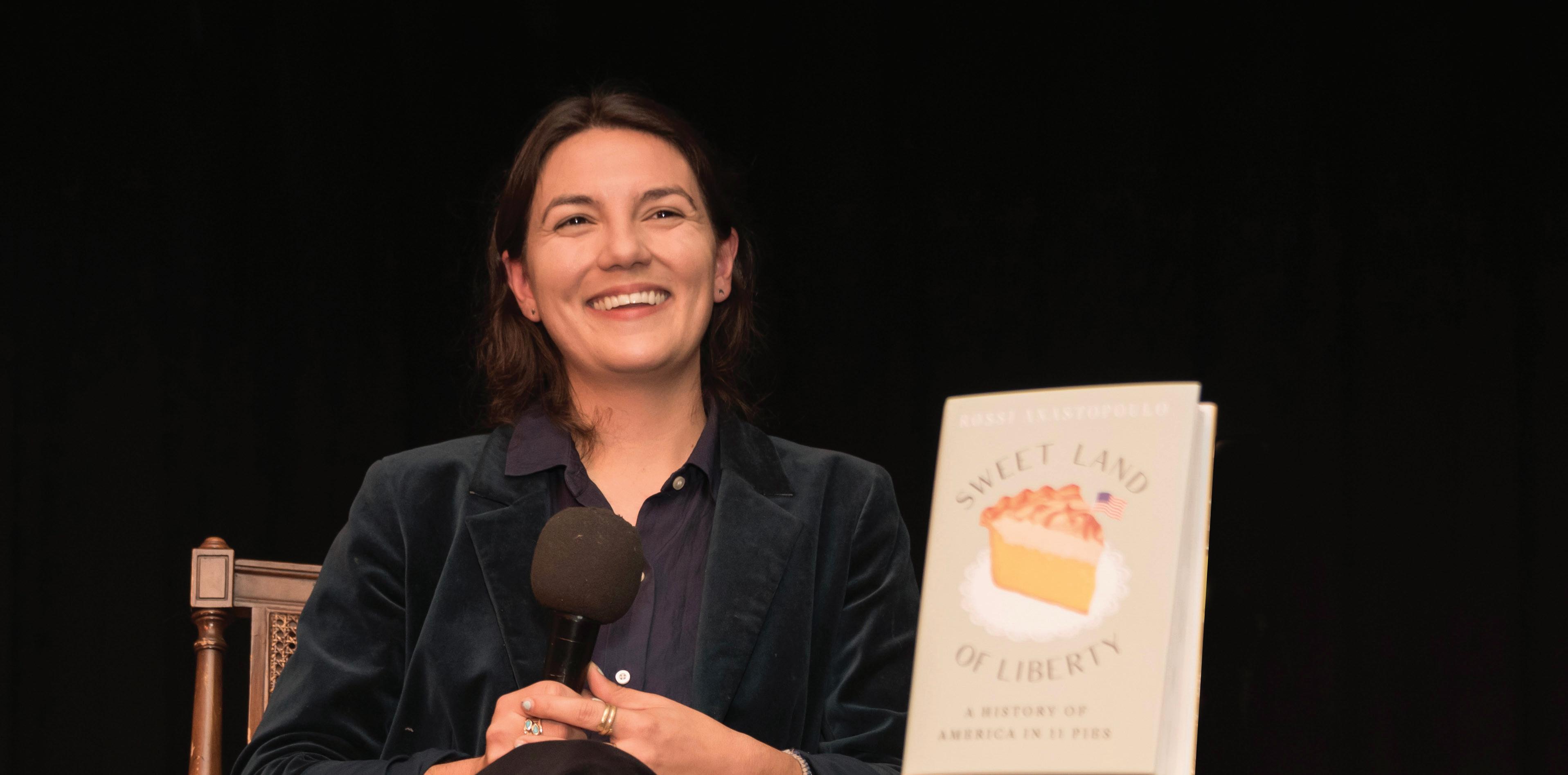
That’s the question Ashley Hall alumna Rossi Anastopoulo ’13 asked her food studies professor as a young MoreheadCain scholar at the University of North Carolina at Chapel Hill. And luckily, the answer was yes. Anastopoulo would go on to complete an in-depth research paper for the class on the anthropology of pie in the South through race, class, and gender. But little did she know, it would be the foundation for many more stories to come.
Now based in Los Angeles, food writer Anastopoulo is the blog editor for King Arthur Baking Company, and she has been writing about food for over a decade. Her award-winning articles have appeared in Bon Appetit, Garden & Gun, Food52, and more, and her first book, Sweet Land of Liberty: A History of America in 11 Pies, showcases her deep knowledge of food history. In the book, Anastopoulo explores some of America’s
My teachers shaped who I am, so in many ways, this book is because of them. Getting the chance to celebrate with so many of them is so special, as well as meeting new people who are just as excited because we share the same bond of Ashley Hall.
– ROSSI ANASTOPOULO ’13most-loved desserts through the lens of a historian, sharing fascinating stories about the relationship between iconic pies and our nation’s social and political evolution.
To celebrate the October 2022 release of Sweet Land of Liberty, Anastopoulo was invited back to Ashley Hall to be a featured author of the Ashley Hall Writers Series. While on campus, she spent two days sharing her passion for baking and writing with students and community members alike. “The déjà vu has been insane – in the best way,” Anastopoulo said of returning to the school she called home from third through twelfth grade. “It feels like a real full circle moment to be here at Ashley Hall where I first formed my passions which have – 10 years later – turned into a book.”
We sat down with Anastopoulo on the second floor of Rivers Library to learn more about her first book and the inspiration behind it.
When you graduated from Ashley Hall, did you know you wanted to be a writer?
RA: I definitely didn’t have food writing or even writing in general on my radar back then. I was actually so inspired by Mr. Muti’s Human Rights class when I was at Ashley Hall that I was thinking I was going to go into international relations so I majored in Global Studies at Carolina. I also ended up majoring
in Sports and Social Issues, which was a self-directed major, but it stemmed directly out of my Ashley Hall senior project during which I studied sports and the civil rights movement. I was so inspired by that project and Mrs. Hughes who directed it. So I guess I kind of followed along that same track of what I had fallen in love with at Ashley Hall when I left. Both those things directly shaped the majors I ended up doing, even if they didn’t directly shape the career I ended up having. But I do think studying sports and social issues definitely correlates to the food work that I’m doing now.
That’s interesting since they are so different. How so?
RA: My senior project provided a template for looking at a social phenomenon like sports or food, things that are so deeply ingrained in our society, and then kind of unpacking the deeper stories behind them – the characters, the people, and the social factors that shape why the sports scene might look the way it does, or why a dish looks the way it does. Grappling with people’s conceptions that certain topics should be apolitical, and challenging that a little bit is really what I did for my senior project. So like I said, I think it pointed me to where I am now.
RA: It really started as a hobby. When I was a student at Ashley Hall, I actually started a baking blog. It wasn’t very good, and I do not want to go back and read them, but that was literally a hobby. I was baking and I was writing about it, and now, I work as the baking blog editor for King Arthur. So I directly turned that hobby into my career, and that’s worked out really well for me.
What advice would you give to current students when it comes to finding a career they are passionate about?
RA: I do think it’s really important that you have a hobby or something you’re passionate about as a start. But don’t be limited by the fact that maybe you don’t know how to turn that into a career. I never would’ve guessed I could’ve turned that into what I’m doing now, but that doesn’t mean you shouldn’t keep pursuing it and following that interest. If you take it one step at a time, you don’t know where it could lead. It could lead somewhere awesome.
On November 17, Ashley Hall’s fall Writers Series event included not one, but three Ashley Hall alumnae. The evening featured debut author Rossi Anastopoulo ’13 in discussion with fellow alumna and arts contributor for The Post and Courier Maura Hogan ’82. The evening concluded with a Sweet Land of Liberty book signing hosted by Charleston’s Buxton Books which is owned by Polly Buxton ’86.
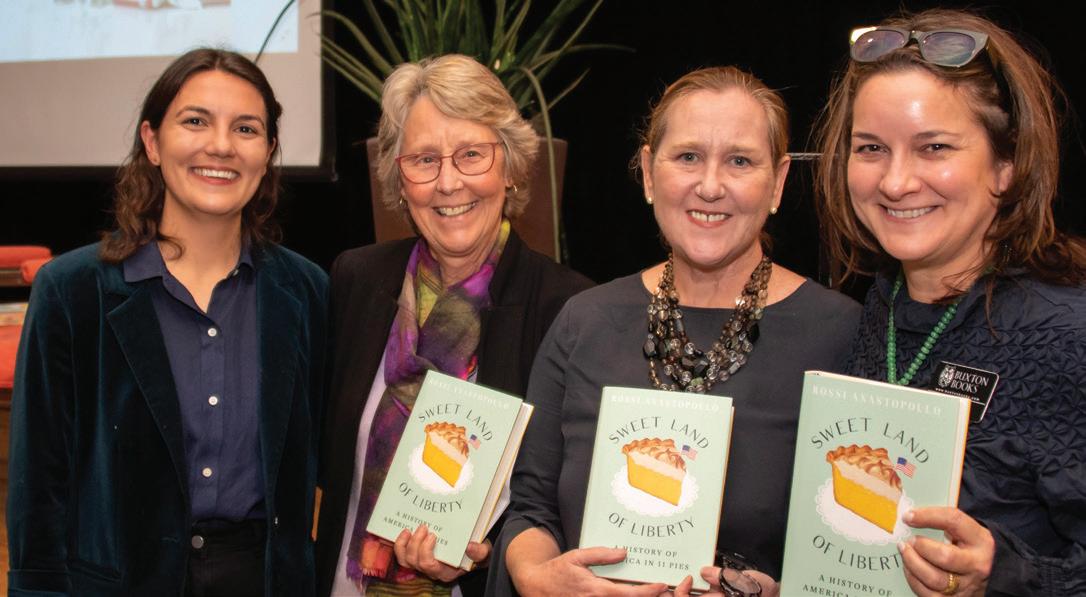
“As an institution, we have always provided opportunities for students to express themselves through the spoken and written word,” says Upper School English faculty member Libby Russler. “The engaging dialogue between Maura and Rossi reflected one of the best things about Ashley Hall: our commitment to help women find their voices.”
Another highlight of the evening? Pie, of course. Inspired by Rossi’s book and Ashley Hall’s commitment to community action, 36 Upper School students and one faculty member baked pies for tasting and purchasing during the event through a special community action initiative, Pies for a Cause. “We wanted to give students a way to help fight hunger in the Lowcountry while celebrating their own family traditions,” Russler says.
Each handmade pie included a list of ingredients, and a brief description of the “story” behind the pie, whether it is a family favorite or simply a favorite. The student-led effort raised over $700 for the Lowcountry Food Bank.
Photos by Brian Principe
On April 21 and 22, nearly 200 Ashley Hall graduates representing classes from 1952 to 2018 returned to Rutledge Avenue for Alumnae Weekend 2023. This year, the School extended a special welcome to its Jubilee Society members, alumnae who have reached their 50th reunion, including new inductees from the Class of 1973. An impressive 44 members of the class traveled from different corners of the world to attend reunion weekend activities. When they arrived, they were met by a familiar face: classmate and dedicated educator, Anne T. Weston, Ph.D. ’73 who is completing her first year as Ashley Hall’s Head of School.
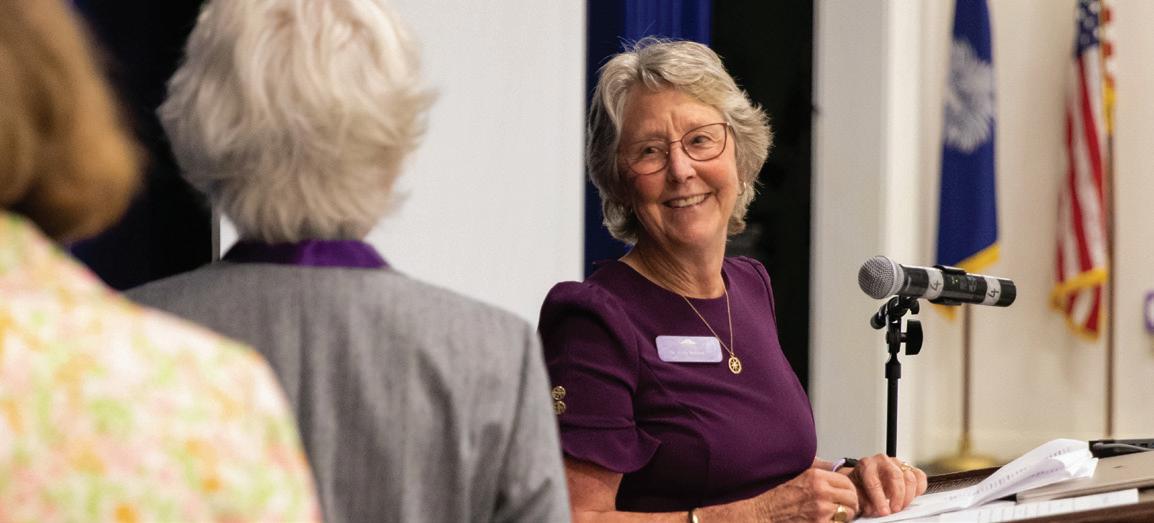
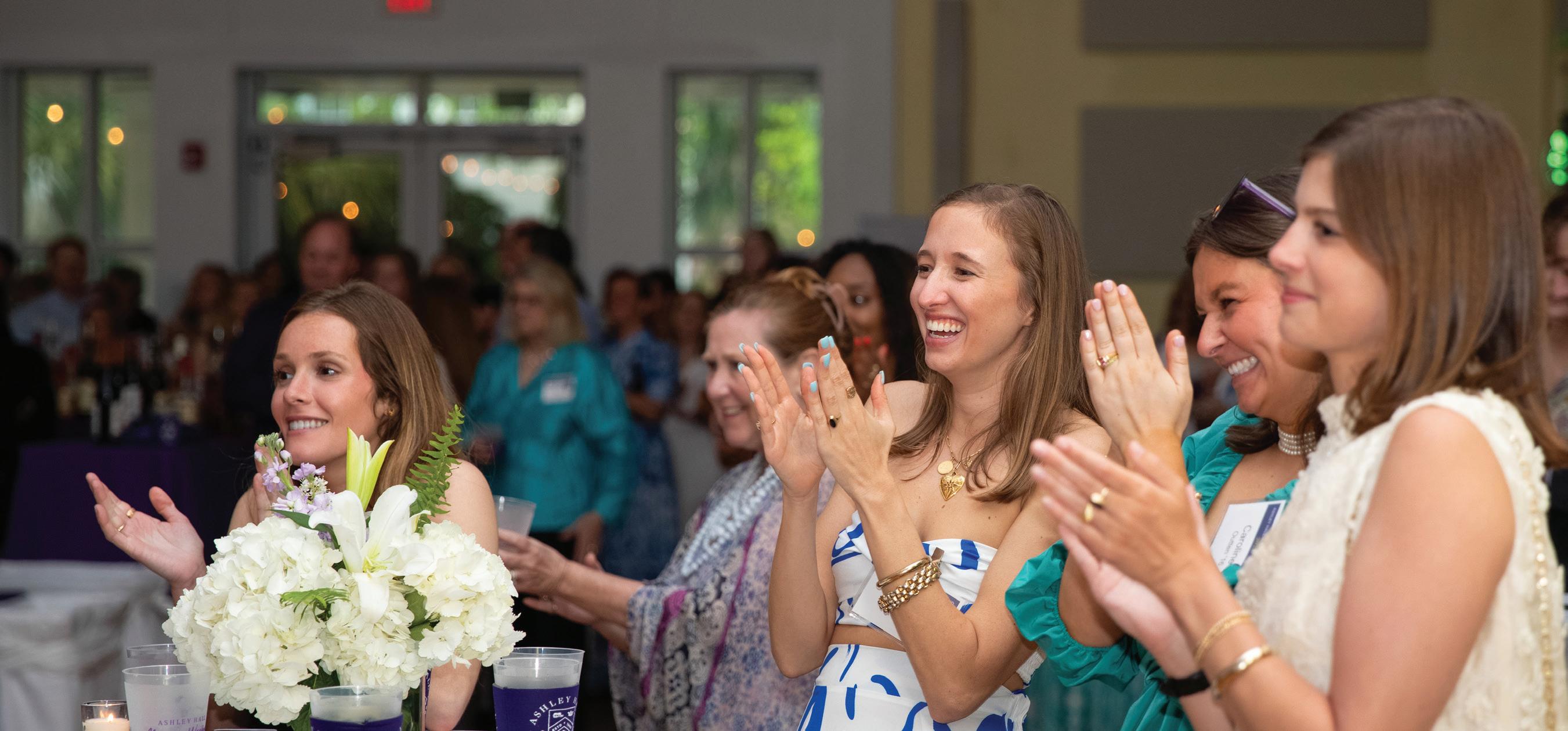
Jubilee Society members joined Dr. Weston for a luncheon honoring their milestone years and another milestone in the School’s history: the introduction of the Anne Thornhill Weston ’73 Endowed Scholarship Fund. Inspired by Weston and led by class representatives Holly Nicholson Brinton ’73, Laurie Arnold Host ’73, Tina Edwards Mayland ’73, and Dale Poulnot ’73, the Class of 1973 created the fund
to provide a scholarship to a deserving student who demonstrates a love of Ashley Hall, a desire to serve, and contributes in meaningful ways with humility.
“In her short time as Head of School, Anne has been leading Ashley Hall with warmth, authenticity, and humor,” says 1973 class representatives. “By creating an endowed scholarship in Anne’s name, the Class of 1973 is not only honoring her lifetime commitment to independent school education, but more importantly, reinforcing the gratitude that our class has for our Ashley Hall education. We are proud to establish a legacy of financial support to deserving students that will be felt well beyond our lifetimes.”
To date, the Anne Thornhill Weston ’73 Endowed Scholarship Fund has raised over $125,000. The first scholarship will likely be awarded in the Spring of 2024.


On Monday, February 27, 2023, Head of School Anne T. Weston, Ph.D. ’73 delivered Ashley Hall’s first ever State of the School Address. With an engaged audience of community members in attendance, this historic event highlighted the School’s latest achievements and commitment to supporting its students as educators and families forge into the future in the pursuit of excellence together.
“Every member of our teaching faculty and staff are educators. They are the very heart of our vibrant and mission-centered institution. Continuing to support and retain our excellent faculty and staff is one of the most important things this School can do. When we need to recruit, we remain committed to seeking professionals from the national and international market, and we aim to provide a competitive salary package that allows our professionals to afford living in a growing city like Charleston.”
“This year, we have initiated the first step in a critical journey for Ashley Hall in the Lower School: pursuing authorization as an International Baccalaureate Primary Years Program. Affiliation with the International Baccalaureate program connects us to a global network of schools whose educators are well-regarded and serve as valuable and engaged mentors who are positioned uniquely to share best practices with our own faculty in supporting the development of knowledgeable and inquiring students.
For Ashley Hall, moving in this direction is an intentional step in globalizing our curriculum, providing additional opportunities for increasing student engagement, confidence, and agency, and supporting further the growth of a caring and culturally responsive community.”
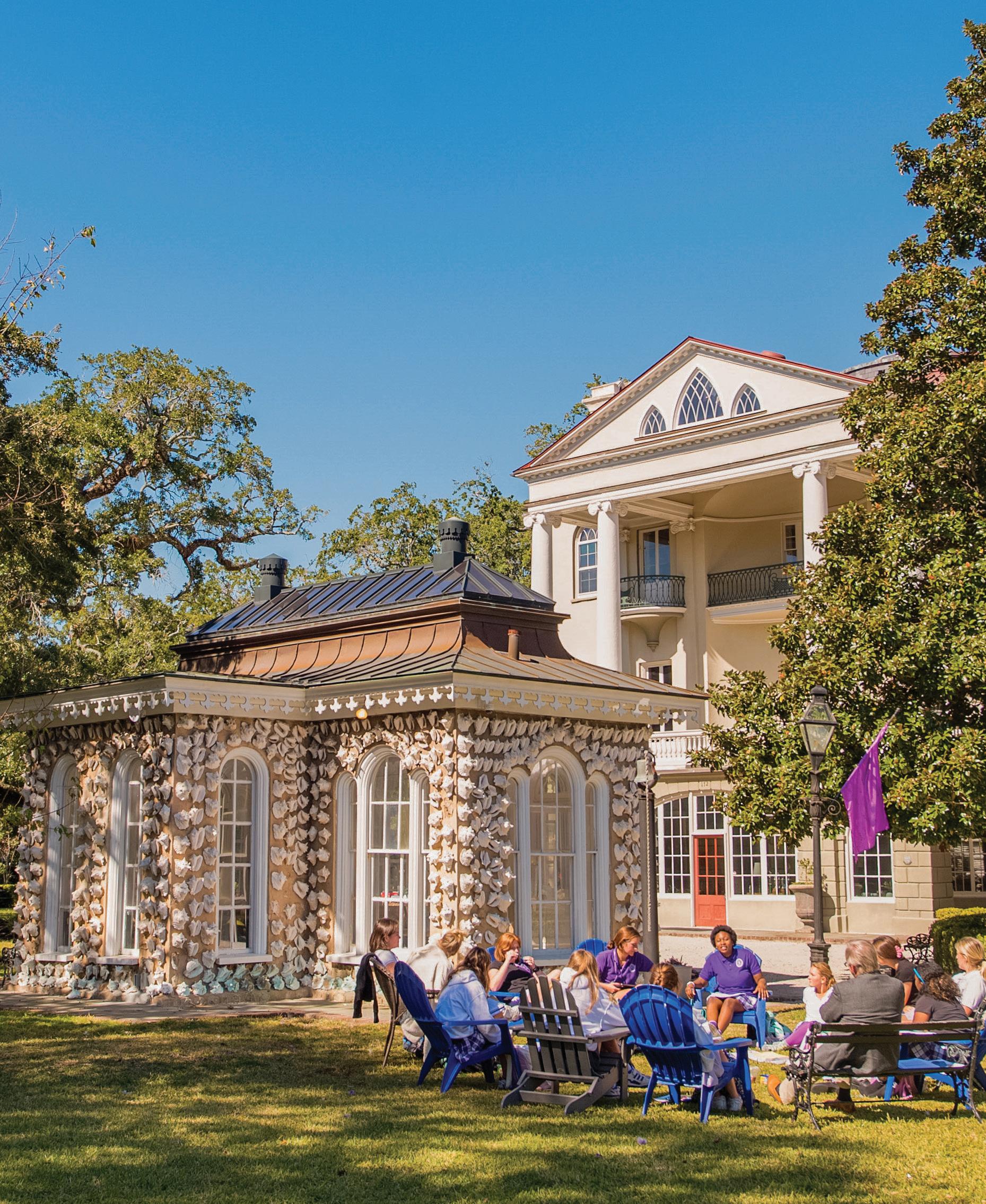
“Inclusion and belonging are two important aspects of student well-being and they are a critical area of focus for Ashley Hall, now and moving into our future. How can we attract and retain a diverse community of students, educators, and thought leaders? What are tangible things to be done to support every student and every family?
We are a historically single-gender school, and yet we have an obligation from our mission to prepare our students to confidently navigate our changing society. We have engaged our faculty community in meaningful professional work to develop capacity, language, and competency to navigate equity issues and will continue to do so. As a School, it is our imperative to teach our students how to be respectful listeners and confident advocates for their own beliefs and to speak in a manner that is civil and does no harm. Our students learn how to think, not what to think, and are asked to show positive regard for every person with whom they interact. It’s a journey for all of us, and our children need to see adults model this for them. We can learn together.”
Excerpted from the 2023 State of the School Address delivered by Head of School Anne T. Weston, Ph.D. ’73
683
3,534
THANKS TO YOU, OUR GRACIOUS DONORS, THE 2022-2023 ASHLEY HALL LOYALTY FUND WILL SURPASS $1,000,000 IN DONATIONS FOR THE 9TH STRAIGHT YEAR.
WITH YOUR SUPPORT, WE ARE:
LOYAL TO OUR STUDENTS | Supporting 79 percent of students who participate in athletics, 39 performing and visual art shows this year both on and off campus, and 29 student-led societies and groups
LOYAL TO OUR TEACHERS AND STAFF | Providing 100 percent of Ashley Hall faculty with professional development opportunities that translate to classroom inspiration and instruction
LOYAL TO EDUCATION | Providing access to a premier education by ensuring financial aid resources are available, when requested
LOYAL TO OUR CAMPUS | Maintaining and enhancing our 10 acre-urban campus, including outfitting five historic properties to meet the needs of the 21st century student
Your support of the Loyalty Fund sends a powerful message that you are Loyal to Ashley Hall, its educational programs, and its legacy. THANK YOU!
READY TO MAKE A GIFT TO THE 2023-2024 LOYALTY FUND? SCAN THIS CODE OR VISIT ASHLEYHALL.ORG/SUPPORT

All year, the 2023 yearbook staff had their eyes and ears open for great stories happening around campus. Here, they share their reporting to offer a unique reflection on life at Ashley Hall through the eyes of its students.
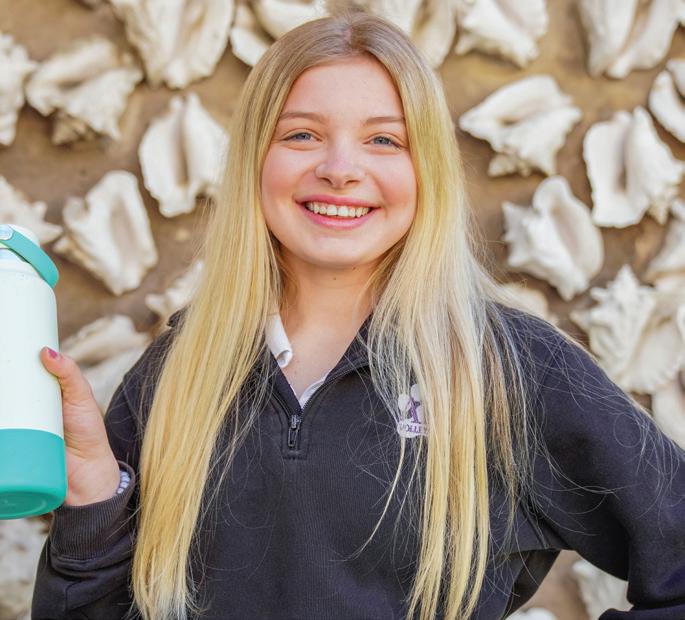
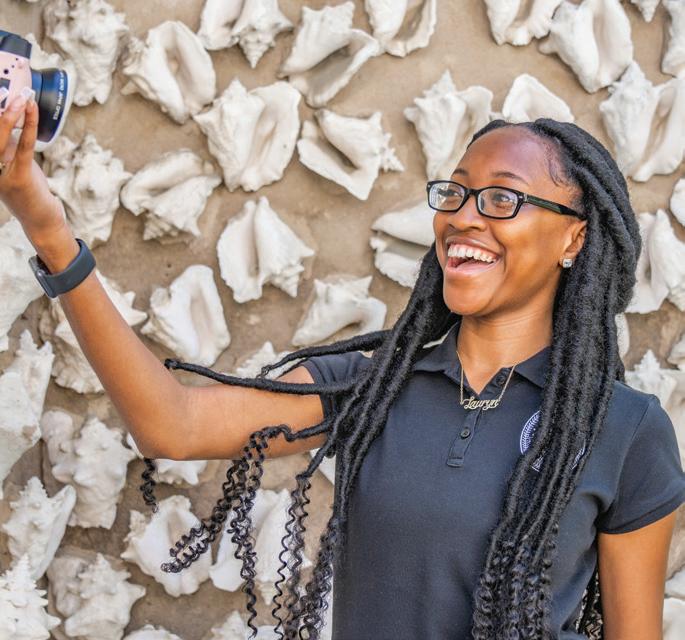


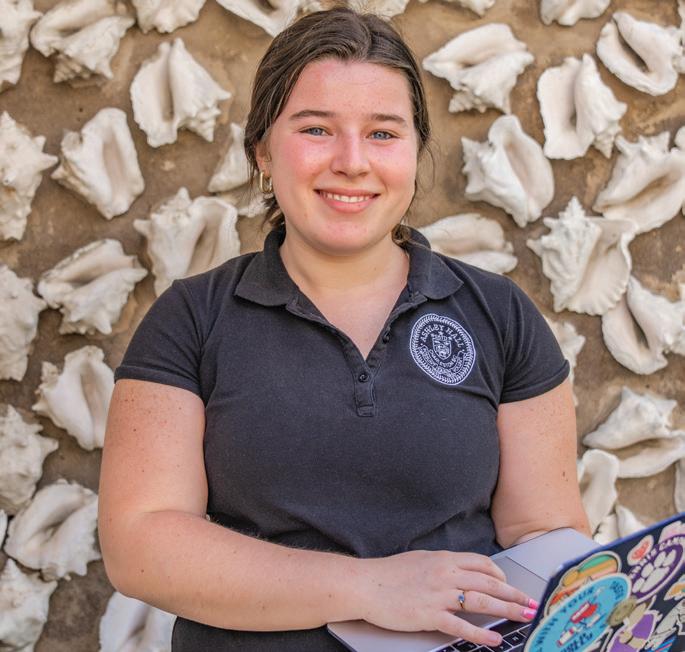
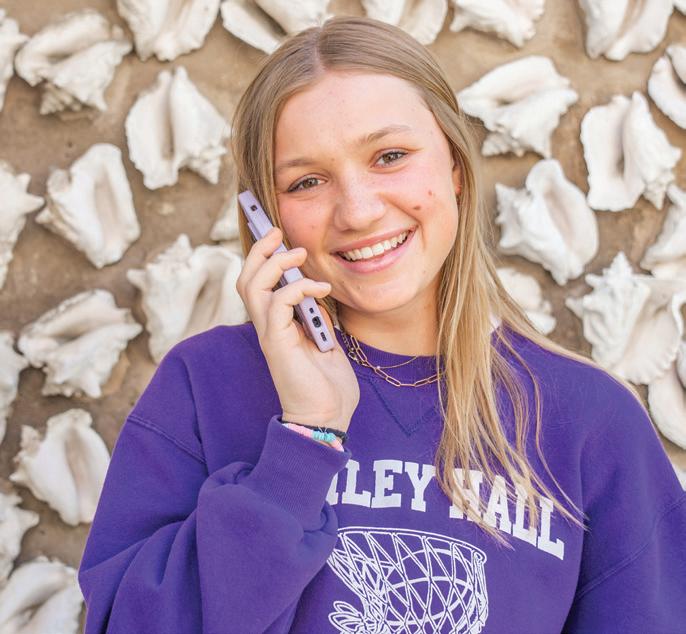
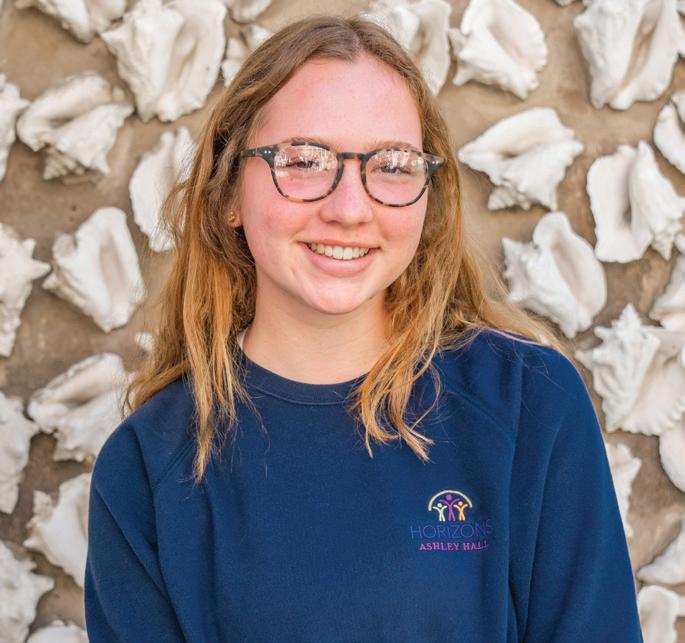

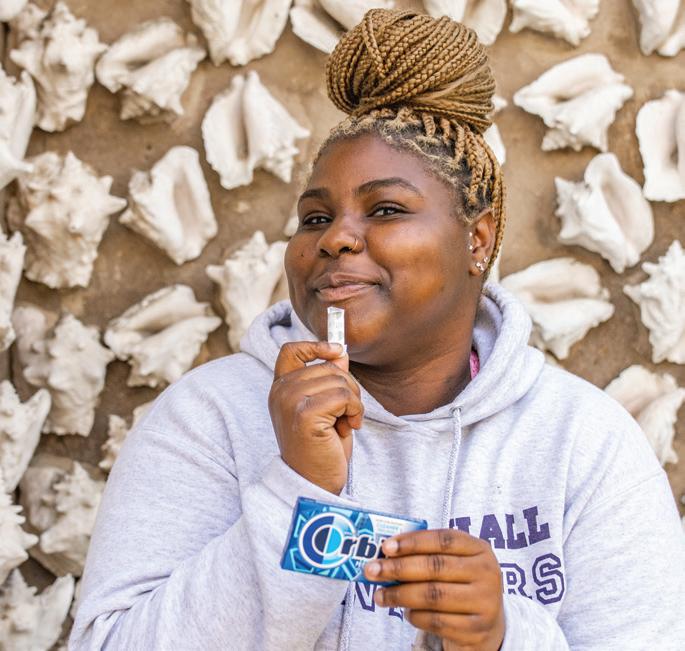
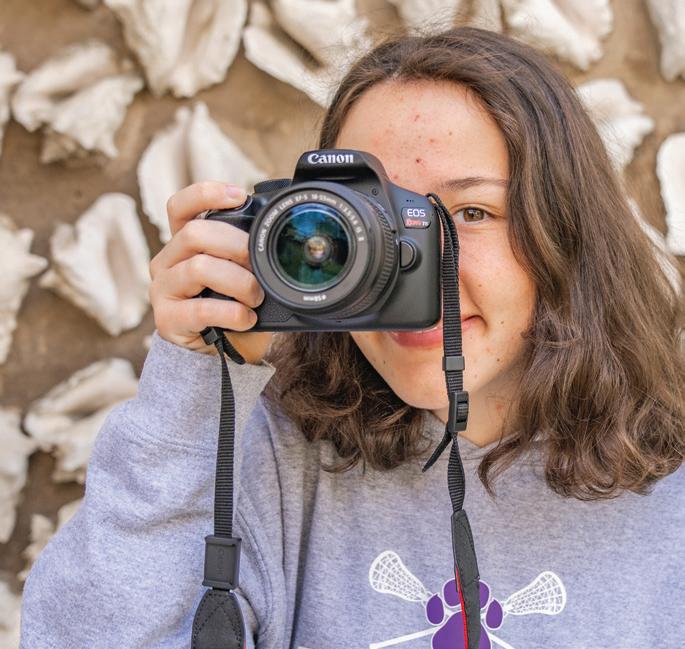 PHOTOS BY BRIAN PRINCIPE
PHOTOS BY BRIAN PRINCIPE
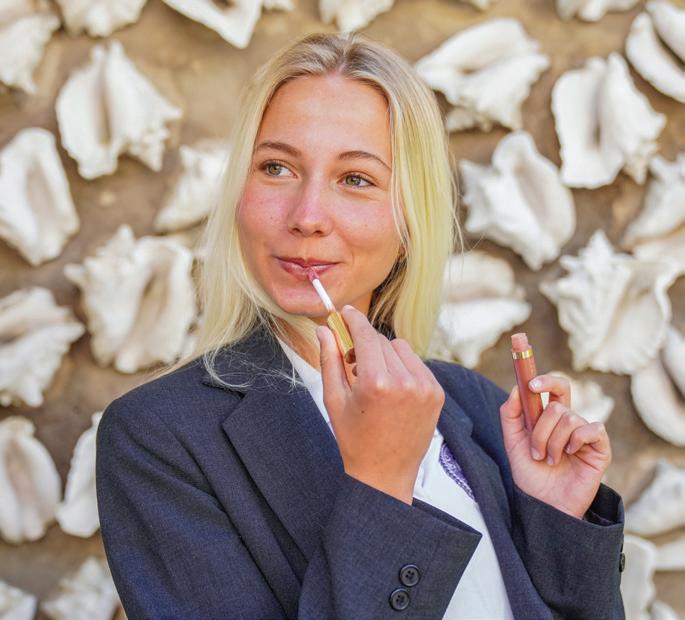

STUDENTS SHARE THEIR FAVORITE THINGS ABOUT EACH GRADE AT ASHLEY HALL
EDITED BY GARNET TOBIN“I really like science because we get to go to the star lab. This was the first time we could go in it.”
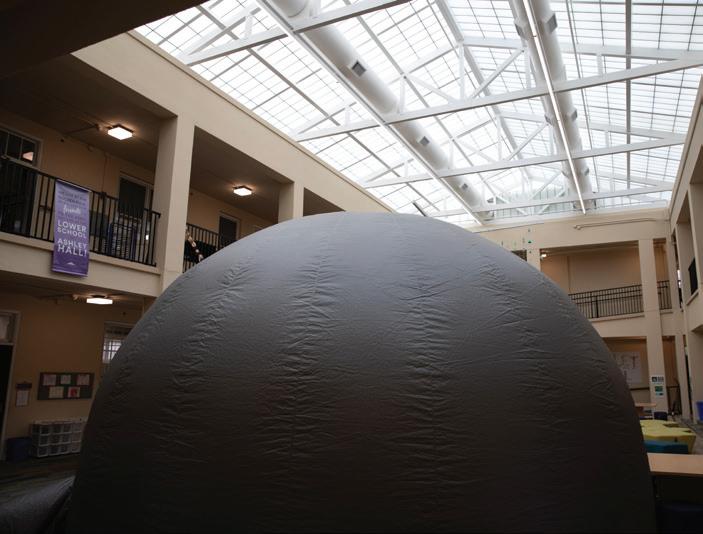
– CATHERINE NICKOL ’35
What’s a Vowel Town?
FIRST “My favorite part of this year was Vowel Town because you get to make towns with paper.” – AURELIA DENNEY ’34
“In first grade, we study long vowel sounds, and we construct a Vowel Town where all of the things crafted in this town have long vowel sounds in them!”
SECOND “My favorite part of second grade has been going up to the top floor of Jenkins with the bees. We have learned a lot about them.”
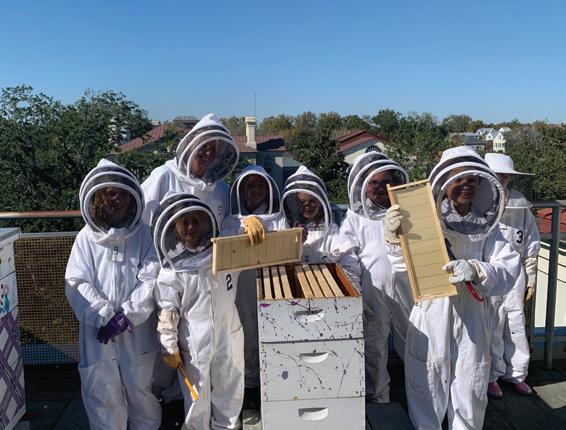
– EMELIA YOUNG ’33
THIRD “Something the second graders should look forward to is the wax museum. We make books about a person, and we dress up as them and present them.” – MCKENZIE WILDSTEIN ’32
FOURTH “The third graders should be excited for Field Day in fourth grade because the fourth graders get to be team captains.”
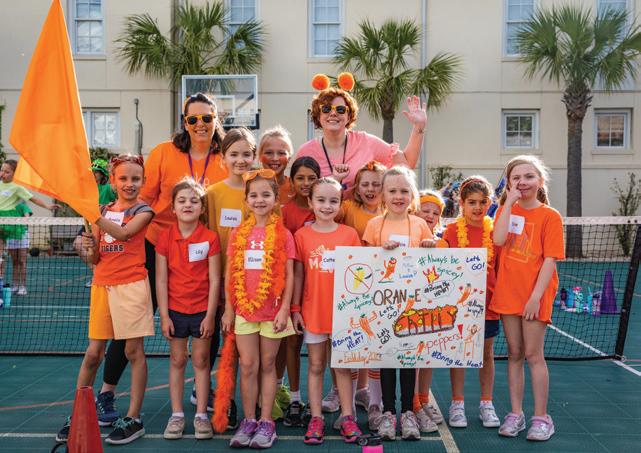
– CHRISTINA MEBANE ’31
FIFTH “Moving into the IP building!”
– CLAIRE PALMER ’30
SIXTH “Getting to read new books in different subjects!”
– ELLA HUTCHISON ’29
SEVENTH “The sixth graders should be excited for different uniform skirts.” – CAMILA ZUNIGA ’28
EIGHTH “The seventh graders should be excited for the eighth grade dance.” – AMELIA FINNEGAN ’27
NINTH “My favorite part of freshman year was the trip to Nantahala. I wish I could go back and be there right now! It was a great time to bond with friends doing different activities.” – MILANI NAKAMURA ’26
TENTH “My favorite part of this year has been the planning of our grade-wide Sweet 16 Dance. There’s so much excitement for us all celebrating being 16 together!” – MIYA BROWN ’25
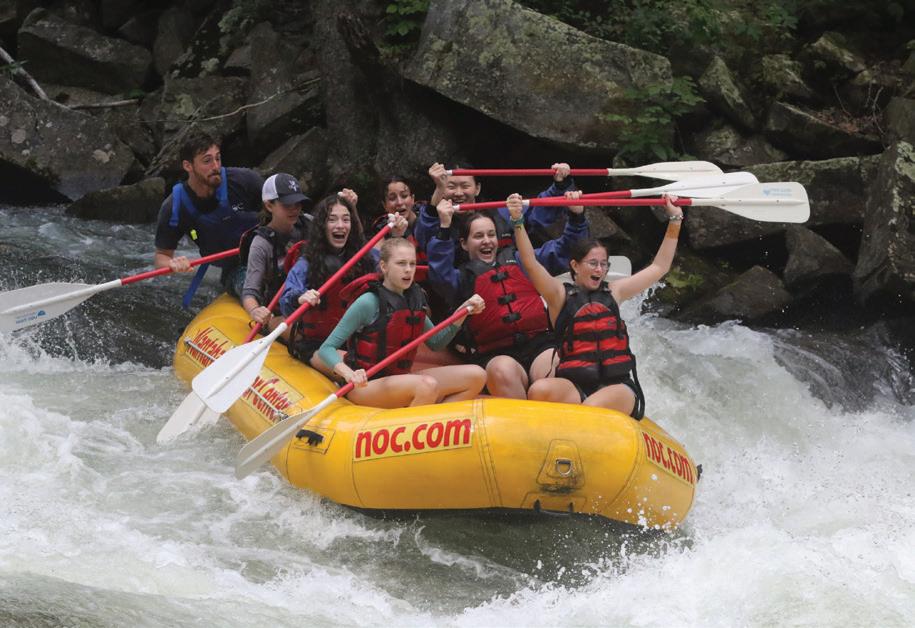 – FIRST GRADE TEACHER AMIE MCINERNEY
– FIRST GRADE TEACHER AMIE MCINERNEY
As early as 1949, the tradition of banquet and prom have been a lively part of Ashley Hall’s history. Juniors put on banquet as a celebration of the senior class, and the very same night, the seniors put on prom for the juniors. Each event is always a surprise for both grades and this year, prom and banquet took place on Saturday, April 29. However, the fun began earlier in the week with more Ashley Hall traditions, including the junior and senior ring and cooler exchange.
Each April, seniors present customized coolers to each rising senior during a special event that takes place on campus. The coolers are decorated to announce the prom theme which stays a secret until this special day, and inside juniors find their class ring, invitation to prom, and fun items to prepare them for summer, including favorite candies, beach balls, beach towels, nail polish, and water guns. These coolers kickstart the celebration for banquet and prom!
Senior class members are in charge of giving juniors their class rings. Since the early ’70s, the ring has been an oval design with either a gold or silver finish. The class rings serve as an introduction to senior year for the juniors. As tradition states, in order to graduate, students must have their ring spun toward their pinky 100 times, plus the year you’re going to graduate. Therefore, this year’s juniors are supposed to spin their ring 124 times throughout the year, with the first spin done by their senior during the ring exchange and the last done by their prom date.
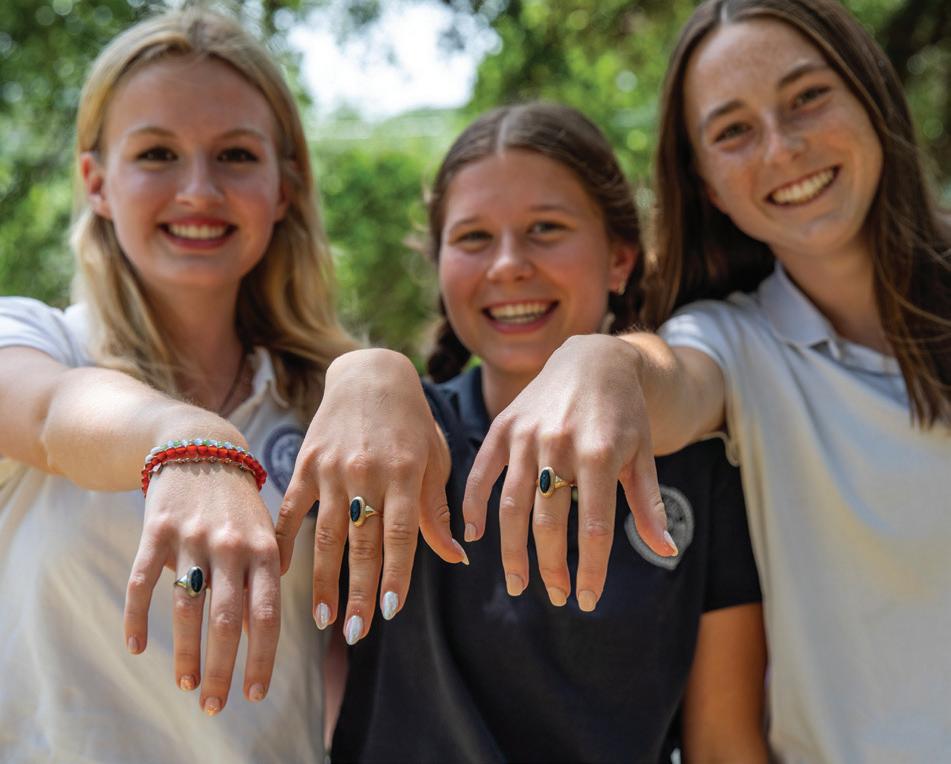
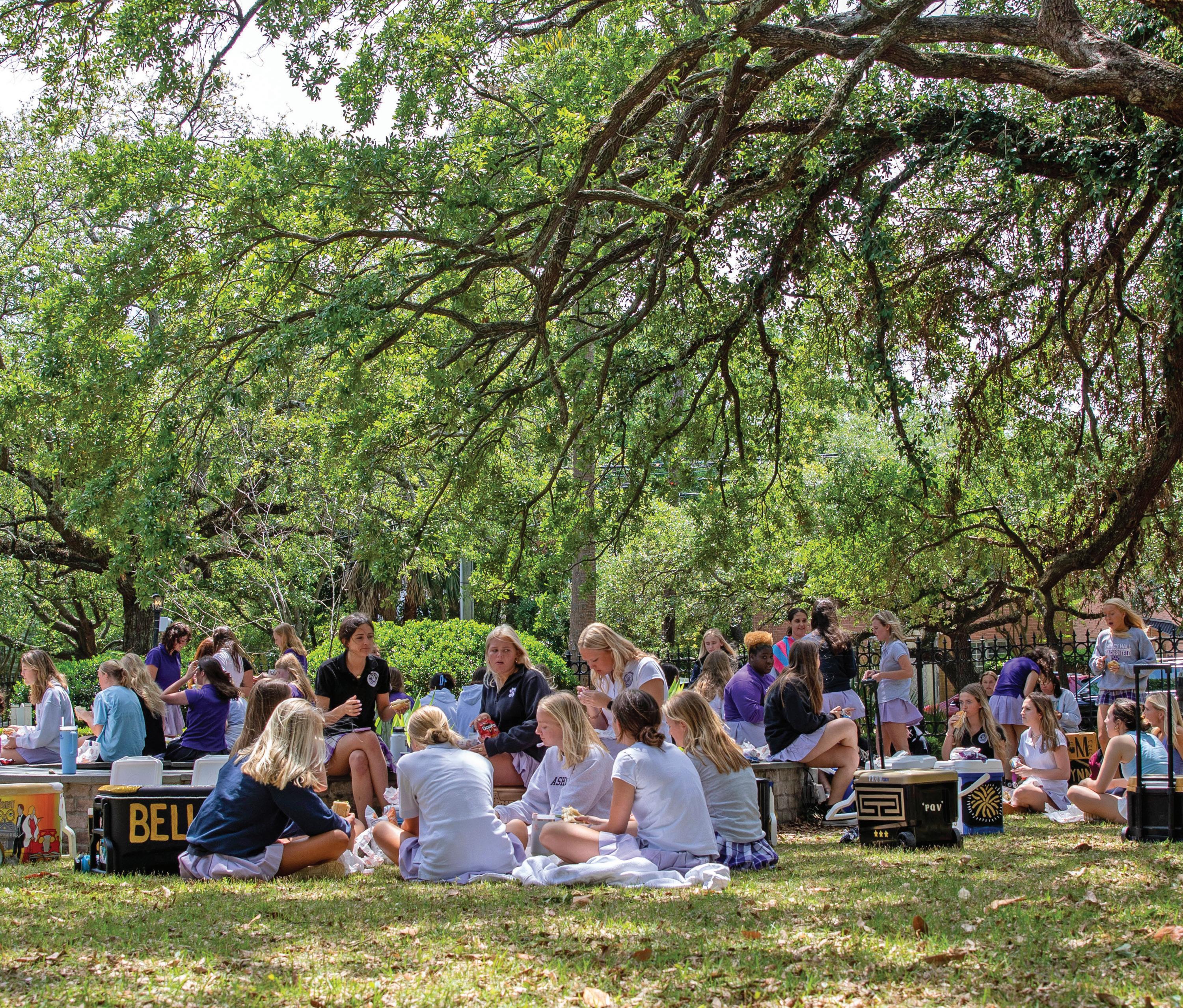
This year, Eads Hubbell ’23 served as Ashley Hall Student Body President. On April 14, Director of Counseling and Upper School Student Life Kelly Sumner announced that Annie Goldstein ’24 had been voted in by her peers to take over for the 2023-24 school year. We sat down with Hubbell and Goldstein to hear about their leadership experiences and plans for the future.
What are you most proud of accomplishing this year? Since my year in the presidency was post-COVID, I’m really proud that we’ve all gotten to hang out together, have in-person assemblies, big dances, and community oriented celebrations. I’m also proud of Tampalooza.* Hopefully future presidents will run with it and bring their own ideas to the table because I feel like it could become something really special.
What advice do you have for Annie for next year? Don’t be scared to be funny sometimes! Sometimes, when I’m up there on stage, I have a joke in my mind, but I get nervous it may come off wrong. But I would say every time I’ve decided not to be silly, I sort of missed an opportunity. Be funny, insert yourself, and be present.
*Tampalooza was one of Hubbell’s main initiatives as Student Body President. During the first week of school, she equipped all the Upper School bathrooms with free feminine products and has continued to restock them all year.
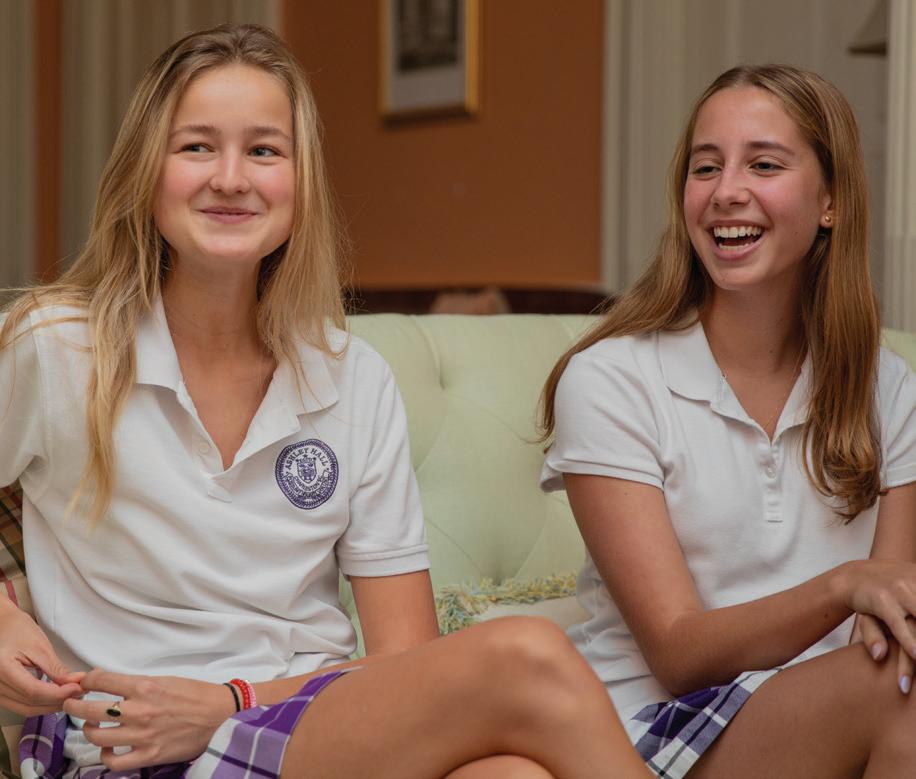

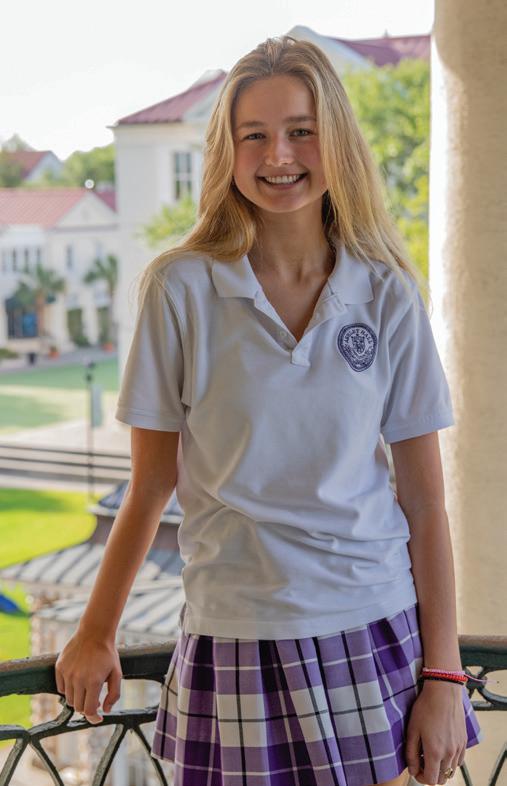
How has Eads inspired what you plan to do as Student Body President? I like how Eads did something every month this year that was special. She did Valentine’s boxes in February and hidden Easter eggs in March. It wasn’t all just school when you were on campus – there was something special you could look forward to every day.
What are you most excited for next year? I’m most excited to lead everyone. I just want to make school more fun and less stressful, and I really like all of Eads’ ideas. It’s so special that she just gave me this jumping off point that I can go from and just keep improving.
What is your favorite part of attending Ashley Hall?
EH: I’ve been here since pre-kindergarten, and my favorite memory has been all the special things that are particular to Ashley Hall. They are the special traditions that we have because the School has so much history. We have been celebrating girls for so long, and I’d say that the things like junior and senior traditions and having little sisters are some of my favorite things.
AG: I’ve also been at Ashley Hall since pre-kindergarten, and the memories I cherish the most are my Lower School memories because I feel like almost my whole grade has been together since we were really little. I just think of all the fun things that we got to do together. As we got older, we just kept adding in new friends, and developing new long-lasting friendships. I think that’s what makes Ashley Hall so special.
| Top: Eads Hubbell ’23 | Middle: Annie Goldstein ’24 | Bottom: Hubbell and Goldstein“There is a tradition here at Ashley Hall, in this city of piazzas and palm trees, of all the girls of the graduating class, standing as one, in dresses and garments, flowing and white, hurling bouquets of roses skyward…”
– EXCERPT FROM THE 2023 COMMENCEMENT ADDRESS WRITTEN BY ROSCOE DAVIS, PH.D.

On Sunday, May 28, 2023, friends, family, and faculty filled the lawn of Ashley Hall’s historic campus to watch 41 members of the Class of 2023 receive their diplomas.

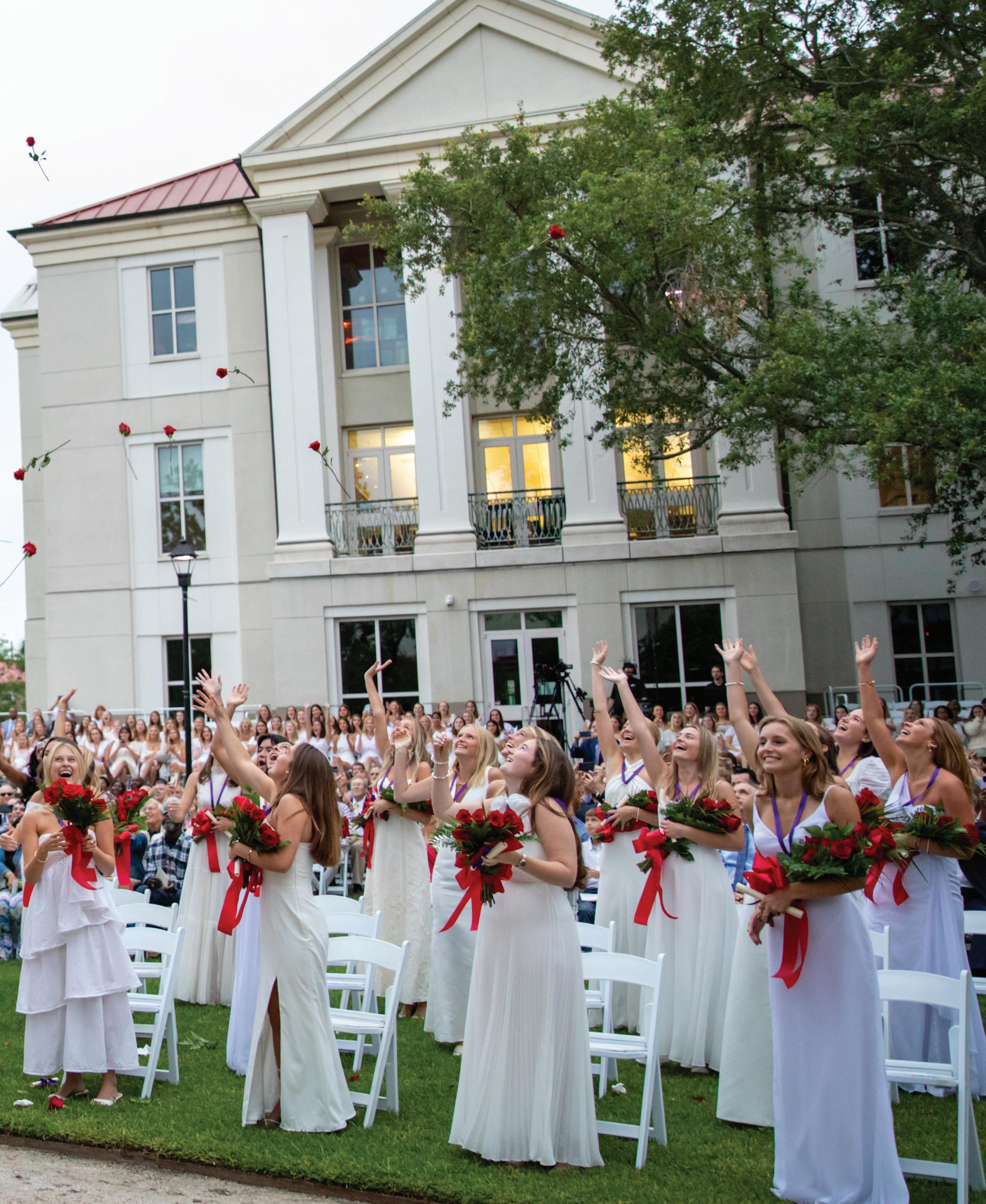
Student speakers featured in this year’s Commencement included Second Honor Graduate Davis Murrell ’23, First Honor Graduate Mattie Hood ’23, and President of the Class of 2023 Julia Richards ’23, who presented the Senior Class Gift, a Charleston Battery Bench dedicated in the memory of former first grade teacher, Jane Bolden, who taught at Ashley Hall for 22 years.
“It is our hope that many moments will be shared by current and future Ashley Hall students [while] visiting and studying outside on this bench,” Richards said. “Students who have also been inspired by special teachers like Ms. Bolden, who loved the gift and magic of outdoor spaces.”

In keeping with their immense gratitude to the teachers who guided them to their long-awaited graduation day, the Class of 2023 selected Upper School faculty member Roscoe Davis, Ph.D., as their commencement speaker. Davis met many members of the Class of 2023 as seventh and eighth grade classics students, and as a beloved Ashley Hall faculty member for the last 20 years, he has witnessed two decades of commencement ceremonies – all of which end with the time-honored ritual of seniors throwing roses in the air in celebration.
“I must say that this particular ritual of the roses, like those in the entire commencement process that precede it, has long moved me,” Davis shared with the Class of 2023. During his speech, he chose not to focus on stories from the past, but rather dreams of the future:
“It is your task to tell your own stories about your own lives. It is your task to keep your own class alive… through the bonds you never stop creating in this loving and very much loved Class of 2023 – this class I love like daughters. When we see roses in the air, it’s not just the end. It’s the beginning.”
The 41 outstanding students of this year’s graduating class were accepted by 97 of the most prestigious colleges and universities across the nation garnering $3.5 million dollars in merit scholarships. The Ashley Hall community is proud of all they’ve accomplished.
Appalachian State University (2)
Arizona State University
Auburn University (5)
Bethune-Cookman University (3)
Boston University
Brandeis University
Bucknell University
Case Western Reserve University
Chapman University
Clark Atlanta University (2)
Clemson University (10)
College of Charleston (5)
Colorado State University (4)
Connecticut College
Davidson College
DePaul University
Duke University
Elon University (8)
Emerson College
Flagler College
Florida Agricultural and Mechanical University (2)
Florida International University
Fordham University (2)
Furman University
Georgia State University (2)
Gettysburg College
Guilford College
Hawaii Pacific University (2)
High Point University
Hobart and William Smith Colleges
Iona University
Ithaca College
Jacksonville University
James Madison University
Kenyon College
Lafayette College
Lewis & Clark College
Louisiana State University (3)
Loyola University Maryland
Lynn University (2)
Mercer University
Miami University (Oxford) (3)
Morgan State University (2)
North Carolina A & T State University
North Carolina Central University
North Carolina State University
Northeastern University
Nova Southeastern University
Oberlin College
Oregon State University
Oxford College of Emory University
Pace University
Pacific University
Penn State University (University Park)
Pepperdine University
Roanoke College
SUNY College of Environmental Science and Forestry
San Diego State University (2)
Savannah College of Art and Design
Sewanee: The University of the South (10)
Southern Methodist University
St. Mary’s College of Maryland
St. Lawrence University

Swarthmore College
Syracuse University
Temple University
The American University of Paris (2)
The College of William and Mary
The Evergreen State College
The University of Alabama (2)
The University of Tampa (2)
The University of Tennessee (Knoxville) (2)
Tufts University
Tulane University of Louisiana (2)
Tuskegee University
University of Arizona
University of Colorado Boulder (5)
University of Delaware
University of Denver (5)
University of Georgia (2)
University of Miami
University of Mississippi (5)
University of New Hampshire (2)
University of North Carolina at Charlotte
University of Oregon
University of Rhode Island (2)
University of South Carolina (15)
University of Southern California
University of Vermont (2)
University of Virginia
Virginia Commonwealth University
Virginia Polytechnic Institute and State University
Wake Forest University
Warren Wilson College
Washington State University
Washington and Lee University (2)
Wofford College
Bold = School graduates will attend Number = Graduates accepted
purchased the private residence at the corner of Rutledge Avenue and Radcliffe Street to establish Ashley Hall in 1909. Its grounds, covered in sprawling gardens and live oak trees, were unrivaled for their beauty, and they still are. Since, they’ve inspired generations of writers, artists, and dreamers who have attended Ashley Hall.
In the inset photo from the 1950s, students sit in the shade of one of the oldest trees on campus that still stands in front of McBee House, the property’s original estate constructed in 1798. Today, visual artists set up their easels in the very same

spot each spring to complete a drawing project next to what is now known as the Madeleine Oak.
Dedicated to distinguished alumna and author Madeleine
L’Engle ’37, the Madeleine Oak was named in honor of the time she spent perched in its limbs with a book as an Ashley Hall student. L’Engle went on to write the award-winning novel A Wrinkle in Time, which garnered the prestigious Newbery Medal in 1963. Her beloved fantasy has ignited the imaginations of young minds ever since its publication, just as her favorite tree on Ashley Hall's campus promises to do for generations to come. —
Liz Regalia